Welcome to the KRLA Beat blog
And in the end....
05.04.68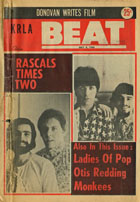
Sharp-eyed viewers will note a peculiar name listed as KRLA Beat publisher on page 2: Mike Curb.
Curb had been in the music business since 1963, composing and producing groups even while in college. By 1968 he was looking for a music newspaper to manage. The Beat was on the market. What could go wrong?
The Beat's original publisher, Cecil Tuck, had fallen into a financial hole and Curb taking over must have seemed like the right move at the time (Dick Clark had also been interested, but Curb was more familiar with the Southern California music scene).
Tuck learned too late that Curb had no real interest in keeping the paper afloat. Curb's intent was to fold the Beat entirely and recoup investment losses with tax write-offs. All the reporters, circulation folks, advertising staff would lose their jobs. That's what could go wrong!
Tuck reversed his decision to sell (though no one noticed Curb's name still in the staff directory). He kept the newspaper barely alive until this very issue, when it folded for good after an unscrupulous distributor absconded with all the Beat's remaining funds.
There was no announcement, no warning. Fans of the Beat had no way to know that this was the last issue they'd ever find on the newsstands. Meanwhile this issue was still full of stories about the music scene, with stories about Donovan, The Rascals, Gladys Knight, Grace Slick, and the trend of pop musicians (Paul McCartney, George Harrison, Paul Simon) writing film scores.
There was still the subscription form on page 19 (one year at $3, two years at $5!) but those future issues were not to be. A few full-page ads were still around, but the Beat couldn't even sell an ad for page 20 where it would have received the most visible placement.
Those of us who were there at the time can appreciate the longevity and importance of sixties rock and roll. It's changed a little over the years but rock is still the music of several generations of listeners. You can't say the same about twenties jazz or forties swing.
The KRLA Beat happened along in time to document the musical waves of innovation during four short years of the 1960s. How fortunate for us that it did!
Over the years Beat publisher Cecil Tuck continued to work in the field of radio news production. His publishing rights to the KRLA Beat, with its untapped mother-lode of pop music interviews and stories, lapsed years ago. He doesn't own a single copy of the newspaper.
Erstwhile Beat reporters seem to have mostly vanished or, if writing still, have gone on to other bylines.
When copies can be found, issues of the KRLA Beat sell on the collector's circuit for anywhere from $25 - $50 each. Mostly-intact collections (increasingly hard to find) can go for thousands of dollars at auction.
But each issue of the KRLA Beat still swings, providing a unique glimpse into pop music's past and proving itself to have been one of the first nascent awakenings of rock-and-roll journalism.
Click the image above to open up the last issue.
Next to last
03.23.68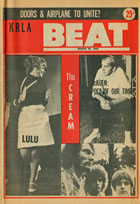
This is the penultimate issue of the KRLA Beat, so far as anyone knows, with only one known issue following about six weeks later.
Advertising revenue had fallen. The Beat couldn't even sell its traditional ad space on page sixteen. But with a skeleton staff still working the Beat did its best to focus on the music scene.
This week's Beat explained why there was never a second Monterey Pop Festival. Negotiations between city officials and Mamas and Papas leader John Phillips had broken down. The city of Monterey felt that the festival brought the wrong sort of people to the city including those inclined to participate in a "violation of public morals." I suppose at the time you couldn't refute some people's opinions.
Writer Tony Leigh reviewed the Santa Monica appearance of Cream. Jacoba Atlas discussed the poetry and songs of Rod McKuen, who explained the popularity of his latest book. KRLA noted that it had played "a small part" in assisting a protest by Caltech students, hoping to influence NBC to restore the popular show "Star Trek" to the airwaves. It was scheduled for the time slot previously held by the Monkees, whose show was cancelled. I fee the apocalypse approaching....
Click the image above to read all about those stories and more.
Who's on tour?
03.09.68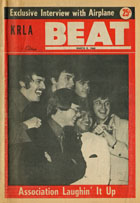
No, not the Beatles, despite this week's KRLA Beat speculating that they might be. Jerry Perenchio, a Los Angeles promoter and talent agent, had bought the rights to book the Fabs in the U.S. and Canada, should they have elected to tour again...but they were true to their word that they'd tour no more.
Interestingly, Perenchio had a slight KRLA connection later on when he paired up with Jack Kent Cooke, a Canadian entrepreneur who once neatly circumvented laws preventing foreign control of U.S. broadcast media. Jack had purchased KRLA in 1959 when it was rebranded as a rock-and-roll station, but he gave it to his brother Donald Cooke, who was a U.S. citizen, to own and manage. Problem solved!
Everyone else was touring, though: the Beach Boys, Tom Jones, Jimmy Hendrix, Bill Medley of the former duo The Righteous Brothers, and Eric Burdon and the Animals. There was no dearth of live music around the country, that's for sure. Page 5 has a photo of the newly formed Alan Price Set prior to their five-week American tour. Some folks will remember Price as the founder of The Animals. Eric Burdon remembered it differently.
For a treat, check out Tony Leigh's article on the Jefferson Airplane on page 6 and Jacoba Altas' review of Arlo Guthrie's talents on page 8.
There's a lot to read in this issue of the KRLA Beat. Click the image above to open up this issue.
Differences of opinion
02.24.68
It's telling that page three carries three letters to the editor complaining or not complaining about the quality of the 1968 KRLA Beat. So far the voting was two to one, with the predominant opinion that the quality of reporting was on the decline while advertising was up.
Here was an unfortunate no-win situation. The newspaper was becoming increasingly hard to manage on the income it generated. There were more folks than ever on the payroll by February 1968. And it was an inevitable truism that income came from advertising, an area where the Beat was beginning to struggle.
The last page, usually a premium space, didn't sell at all in this issue. Instead the Beat made a mock, black-banded tribute to the demise of the Righteous Brothers as a duo. Music was changing, no doubt about it. So was readership.
There are those of us who think that Rolling Stone, a newspaper covering much the same material as the KRLA Beat and which launched in November 1967, got its inspiration from Bay Area sister publication the KYA Beat, also published by Cecil Tuck and Beat Publications. Unlike underground music and lifestyle publications, Rolling Stone was determined to document music with serious journalism. Its ambitions were high, perhaps more realistic too than the latter-day Beat.
See whether you agree. You can experience some of the reporting in the November 9, 1967 issue here. Then click the image above left to read this week's KRLA Beat.
Alternative sounds
02.10.68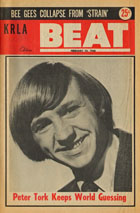
This week's KRLA Beat highlights stories about Frank Zappa's surprising award as "Pop Musician of the Year" by Jazz & Pop Magazine (page 3). Also on the same page is a review of what's up with Miriam Makeba, then on extensive world tours. Astonishingly Makeba could sing in eleven different languages, an accomplishment not seen in many musicians of the time.
Page 5 includes a photo of Ravi Shankar, whose music had already inspired the Beatles and especially George Harrison, then at work in a London studio working on his score for the film "Wonderwall."
Don't forget to check out the film review on page 17 of "The Graduate," Mike Nichol's film about "the Los Angelesism of the world."
Read all about it by clicking the image above!
The wonderful world of color
01.27.68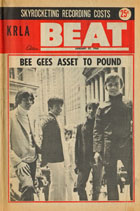
On page 4 Tony Barrow, the KRLA Beat's indefatigable London correspondent, attempts to explain why the Beatles first experiment in movie-making was so misunderstood. As he points out, there were good as well as bad and indifferent reviews of "Magical Mystery Tour," but he identifies one of the principal issues: many folks saw it on the telly in black-and-white instead of color.
Admittedly the TV movie was a pastiche of tenuously-related fantasy sequences, which alone was not designed to bring coherence to the mix. "If people were looking for a plot they were bound to be disappointed," Paul McCartney helpfully explained in an interview. Okay then! Time has been kinder to the film, thankfully.
Sticking with the perspicacious Mr. Barrow for a bit, scroll to page 7 for a review of the U.K. pop scene: all that it ever had been and all that it ever would be, more or less. It's a nice summation of the British pop music world as it was in late 1967. And on page 8 are two forward looking articles on up-and-coming talents: Jacoba Atlas on the talented then-newcomer Nilsson, and Ron Koslow's review of Janis Joplin's recent gig at the Whisky-A-Go-Go, which he claimed "permanently altered the emotional atmosphere of the city." Prophetic words, surely!
Click the image above to open this issue and enjoy all this week's articles.
RIP Otis Redding
01.13.68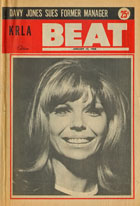
On pages 6 and 7 this issue of the KRLA Beat paid tribute to the passing of Otis Redding and four members of the Bar-Kays, his backup group. The airplane accident that had claimed their lives actually occurred over a month earlier, on December 10, 1967, but production schedules being what they were at the time, this issue provided the first opportunity to acknowledge their passing.
Despite the lag in timely news-gathering, this week's Beat managed to quote from a plethora of press releases and massage spare material into column-worthy prose. The editorial box on page 2 would suggest that the newspaper was at its peak, staff-wise, with four top editors, two staff writers, six contributing writers, and two staff photographers, not to mention an advertising director, business manager, and circulation coordinator. Worldwide distribution also seemed to have been fairly well represented.
Yet this was the year, as Cecil Tuck has said, that things started to go downhill. Production costs were rising and revenues were slipping. In 1966 the semi-weekly production schedule boasted 24 pages of news and views every week. Sharp-eyed readers will note that this issue is down to 20 pages, with no one able to sell an ad on the final page.
So enjoy the Beat while you can! Click on the image above to read the whole issue.
Auld Lang Syne
12.30.67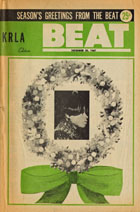
No, you weren't sleeping and missed an issue. The KRLA Beat took nearly the whole month off and published its last issue of 1967 at the end of December, filling its content with good holiday wishes from singers of the era and other news of the time. Page 2 offers a photo of eager reader Don Ruiz, posing near the Saigon River in Vietnam with his copy of the KRLA Beat. We hope that Don made it back to the USA after his service days ended!
There are lots of advertisements in this issue with a plethora of psychedelic album covers, from "Magical Mystery Tour," "Their Satanic Majesties Request," Jimi Hendrix, and H.P. Lovecraft. Quick-thinking fans could even take advantage of a special Beat offer: a free copy of a deleted Buffalo Springfield LP cover. Originally called "Buffalo Springfield Stampede," its name was changed to "Buffalo Springfield Again" with a different cover design. See page 4 for the details. Nice promotion, KRLA, and quick thinking. You're a failure at catering if you don't know what to do with your leftovers.
The local nightclub scene was warm and toasty this month (see page 11), with the Nitty Gritty Dirt Band and the Chambers Brothers at the Ash Grove on Melrose, the Byrds and Ian & Sylvia at the Golden Bear in Huntington Beach, and the Jim Kweskin Jug Band at the Troubador on Santa Monica Blvd.
Read all about the music and happenings by clicking the image above.
Forward into the past
12.02.67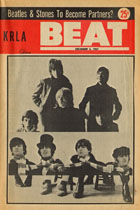
If you've been counting issues, you're right about something: it was almost a full month from the previous issue of the KRLA Beat to this one, right at the start of December 1967. It might have been simply the holiday season wreaking its usual havoc, with the Beat giving up an expected issue for Thanksgiving. Or it could be the first sign of financial worries that were to plague the newspaper from here on out.
For the December 2, 1967 issue London correspondent Tony Barrow ruled the front page. One article discussed (in all seriousness) a possible collaboration between the two biggest groups of the era, the Beatles and the Rolling Stones. The other was a painful timeline of what appeared to be the breakup of producer Lou Adler's prime entertainment group, the Mamas and the Papas.
Meanwhile the Beat staff was forced to cover more lightweight stories. Kim Kobashigawa had an article on page 7 about the rise of The Cowsills, a band formed by a family of musicians from the East Coast. And on page 11 you can read slightly more in-depth treatments reviewing the careers of Stevie Wonder (already a veteran musician of some years) and the Strawberry Alarm Clock, a much more recent musical conglomeration.
There were an awful lot of full-page ads in this issue, suggesting that economically the Beat was doing all right, but this was the beginning of the end of prosperity. The holiday season was always a good time to get your marketing team in action. But this would be the last few weeks of success for the first rock-and-roll newspaper...something we only know from hindsight.
Read the stories from fifty years ago by clicking the image above.
Fussing and fighting
11.04.67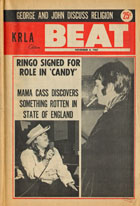
This week the Beat reports on a minor kerfuffle between Mama Cass Elliott and Kensington's Embassy Hotel in London over a pair of keys and a couple of missing blankets. The prosecution was unable to prove Cass had anything to do with the theft, thankfully, and she was cleared of all charges. One less musician in jail this week fifty years ago, and for that we are grateful!
One of Ringo Starr's persistent desires was to distinguish himself as a film star -- if you recall, he was much lauded for his solitary scene in "A Hard Day's Night" a few years ago. So the inimitable Mr. Starkey decided to flex his cinematic wings with a solo part in the film adaptation of Terry Southern's novel "Candy." And it helped to pay the bills.
Also in this issue: Tony Barrow reviews George's and John's appearance on the David Frost Show where they discuss religion, always a topic of interest when it comes to the Fabs, or half of them, anyway.
This week's Beat also covers the Rascals, Don Ho (what was this fascination with Don Ho?), the Four Tops, Every Mother's Son, and Brenton Wood.
Make yourself happy as well as informed. Click the image above to open this week's issue of the KRLA Beat, and all will be revealed.
Breaking up is hard to do
10.21.67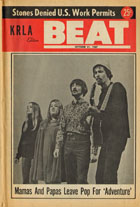
It had been a short era, but the Mamas and the Papas were determined to call it quits and move to Europe, citing disenchantment with the music industry as their motivation.
Acknowledging a different kind of disenchantment, the U.S. Immigration department announced that it would not issue work permits to Mick Jagger and Keith Richard due to their recent drug convictions, so there would be no more Stones concerts for the foreseeable future. Sounds familiar...this was all pver the news in the first issues of the KRLA Beat back in late 1964! What's old is new again.
The Beat also revealed the origins behind George Harrison's new composition "Blue Jay Way," which involved a fog, a street named after a bird, and a lost man called Derek Taylor.
Want the scoop on the Beatles' new spriritual advisor, Maharishi Mahesh Yogi, with whom they'd recently spent a few days in Wales? It's all in this issue, as is Tony Barrow's column, quoting some pithy comments from the New Zealand press about that selfsame guru.
And there's more: Bill Cosby, Bob Dylan, The Association, Bobby Vee, and Vicki Carr (Vicki Carr?).
By clicking the image above you can immerse yourself in the musical landscape of yesteryear.
Hippies as hung-up hypocrites
10.07.67
George Harrison had just recently visited San Francisco and left with a decidedly unsympathetic impression of flower children, whom he thought were "too hung up on LSD and other drugs to really be hip." In a pointed declaration, Harrison stated bluntly that "LSD isn't the answer. It doesn't give you anything."
Are protest songs the real answer? Depends which one you sing! The Smothers Brothers, then at the height of their television fame, were told by CBS that Pete Seeger would not be allowed to sing "Waist Deep in the Big Muddy" on the show because it might be "controversial." Anti-war it certainly was, and the big networks were nervous about upsetting viewers. Ironically Seeger had just recorded an album called "Waist Deep in the Big Muddy and Other Love Songs" for Columbia (which CBS owned). Instead Seeger offered to sing "Where Have All The Flowers Gone?", apparently a much less intrusive protest song, maybe because there were flowers in it instead of guns.
Lots of news from London on page 4 of this week's Beat, where Tony Barrow reveals that the Beatles were working on a new film project about a magical mystery tour.
Check out Mike Masterson's page 11 article on The Doors, "an individualist group unified despite diversity." Well, that's one way to put it.
Fifty years goes by so fast. Find out what it was like by clicking the image above.
The farther one travels, the less one knows
09.23.67
The news about Brian Epstein's death had shocked the Beatles, their families and friends, and their fans when it happened at the end of August. Because of their every-two-week publication schedule the KRLA Beat was nearly a month late in reporting the story.
Just beginning to be a white-hot story: the question of who really would own the copyrights to the catalog of Beatles songs. Rumors were swirling that their songs rights would be sold to pay debts. The story was too complex to be understood at the time, and over the years there would be many twists and turns in the tale. Just this year, in 2017, the situation was finally resolved in Paul McCartney's favor after nearly a lifetime of litigation.
Meanwhile, on page 5 Tony Barrow,tried to make sense of the Beatles' (and other rock entities such as Mick Jagger and Marianne Faithfull) fascination with an Indian mystic called Maharishi Mahesh Yogi. The group of musicians and their families travelled to Bangor, Wales to hear lectures on transcendental meditation, a new way to connect with the spiritual realm.
Page 11 included the new line-up of KRLA deejays for Fall 1967, with all the powerhouse voices on the air prior to 6pm...and Dave Hull as morning man. That was quite a shake-up!
Click the image above to dive into the pop world as it was fifty years ago.
Go for the gold
09.09.67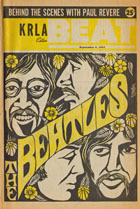
In an experiment gone wrong, the KRLA Beat selected yellow as its secondary color in this week's issue...not exactly an enhancement of the psychedelic front-page illustration. Oh well, it was a short-lived foray into incomprehensible chromatic choices. On with the news!
Tony Barrow, the Beat's London correspondent, offered continuing coverage from the British press about the Jagger/Richard acquittal on pending drugs charges. Alice Bacon, Minister of State at the Home Office, told Parliament that she was "horrified" at the rampant drug use among pop stars. Brian Epstein was quoted as suggesting that Miss Bacon's opinion was "narrow and singularly ill-informed." Ironic statement indeed: because of production timing for this issue, Brian was already dead of a drug overdose when this story was printed.
Catch the story on page 5 of this week's Beat, where George Harrison gave an interview about his renewed interest in learning the sitar, the spirituality of Indian music in general, and where how own musical career might be headed. George was in Los Angeles to attend Shankar's concert at the Hollywood Bowl.
You can read the entire issue from September 9, 1967 by clicking the image above.
Play it by ear
08.26.67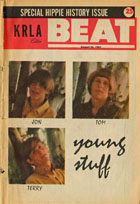
The musicians on this issue's cover -- three local high schoolers in a band called Young Stuff -- seem to have left no trace in pop music history, though they did provide the KRLA Beat with one of its very few color covers. But there was plenty of other news as well.
Mick Jagger and Keith Richard were freed on drug charges (Richard on a technicality -- yes, reportedly there was a naked girl wrapped in a rug in his home, but she wasn't smoking hemp), George and Pattie Harrison came to town, Bobby Gentry revealed what "Ode To Billy Joe" was all about, and the Beat explores "Oriental religions" and what they meant to the young folks who called themselves hippies.
It as, in some ways, a very different world fifty years ago. To find out what it was like, click the image above and read about it.
Everyone is going through changes
08.12.67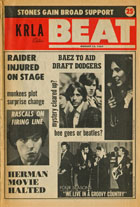
Injuries, protests, changes, mysteries -- it was all a part of the pop music scene and the KRLA Beat was there to cover the hubbub and hoopla.
Procol Harum lost a drummer and a guitarist, paving the way for Robin Trower and Barry Wilson to join the group, with songwriter Keith Reid remaining co-manager (thankfully!).
Joan Baez joined a committee to encourage young men to resist the draft. In more serious reporting from the being-a-pop-star-is-dangerous department, Mark Lindsay of Paul Revere & the Raiders suffered injuries when trying to avoid a mob of fans while exiting their tour bus and again on stage.
The "mystery" this week fifty years ago involved the question about who was really singing on the new Bee Gees song "In My Own Time". The Beat is uncharacteristically coy, claiming that "sources close to the Beatles" confirmed that the Fabs were singing on the track. The Bee Gees denied it, and no evidence ever has emerged to suggest that the Beatles had anything to do with the track. But the story resulted in a flurry of phone requests to KRLA and boosted airplay of the song for a while.
If you click the image above you can read about it as it happened back then. What have you got to lose?
A day in the life of everybody
07.29.67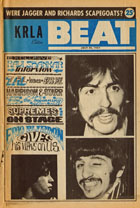
The Beat got particularly creative with this issue, switching from its characteristic red masthead to blue, using hand-lettered headlines on its cover, and even framing one advertisement in scraps of newsprint from a previous issue.
There were a lot of hot topics in the news as well: Carl Wilson of the Beach Boys was cleared of draft-dodging claims, Zal Yanovsky quit the Lovin' Spoonful in a move described as "amicable", and Mick Jagger and Keith Richard were found guilty of drug charges in London. Both Stones planned to appeal, and the charges were later dismissed.
This week's Beat also offered two in-depth profiles of Ringo Starr and George Harrison, an interview with Ravi Shankar, who declared that his music was "not for addicts", a day in the life of the Monkees, and a history of Procol Harum, whose "Whiter Shade of Pale" was Number 1 on the British charts.
What a heady era! Re-live it now (and forever) by clicking the image above.
The best things in life are free
07.15.67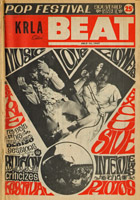
It took a full month, but at last the KRLA Beat produced its "souvenir issue" commemorating the Monterey Pop Festival back in June.
Most surprising news, and I'm not sure I believe it: all acts purportedly performed for free and proceeds from ticket sales were set aside to set up music scholarships, establish courses in the music business and copyright law, and to help struggling musicians in unspecified ways. Not sure how much of this really came to pass, but it was a nice gesture.
There are, however, some exclusive photos and brief interviews with folk such as Brian Jones, "Mama" Cass Elliot, and Jimi Hendrix. Eric Burdon called the festival "a good beginning," and he wasn't far wrong.
Read all about that summer of love 'n' music! Click the image above to start your trip.
Declare the pennies on your eyes
07.01.67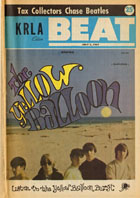
Here it is July 1967 and the poor Fabs are that much poorer. The Italian government decided to take off after the Beatles for unpaid taxes from a 1965 tour of Italy, where the group earned $90,000 for eight performances. No wonder they gave up touring!
On page 3 of the KRLA Beat from fifty years ago, journalists discovered the hippie movement, a far-flung band of disaffected youth invading New York, San Francisco, and Los Angeles, among other environs. Whether the group was for good or ill purposes, the Beat was reluctant to say.
The cover story this week (and in a hand-lettered advertisement on page 9) was The Yellow Balloon. Destined to become a one-hit wonder, the group included actor Don Grady, a former Mouseketeer and one of the sons on the CBS sitcom "My Three Sons." The group's eponymous hit reached number 25 on the Billboard chart, but that was pretty much the end of the line for The Yellow Balloon.
Want to read more? Please do! Just click the image above left to open this magic issue.
Banned by the BBC
06.17.67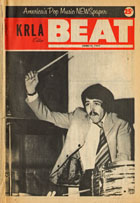
The lead story in this week's KRLA Beat highlighted the baffling puritanicalism of radio stations that banned music they didn't understand.
Our best friend, London-based Tony Barrow, pointed out the inanity of some American stations banning "A Day in the Life" because they didn't get the line about 4,000 holes in Blackburn, Lancashire, assuming it had something to do with injecting illegal substances. But the BBC went the extra mile in England and banned the track because the line about going up to the top level of a London double-decker bus to have a smoke "could encourage a permissive attitude toward drug taking." Never mind that the drug referred to in this line was nicotine!
And as Barrow pointed out, Auntie Beeb seemed to completely miss the line "I'd love to turn you on"... which at the time was "spun" to suggest turning the listener on to music. But the BBC seemed completely clueless about what line meant what. Oh well, music marches on!
This issue of the Beat came out fifty years ago this week and coincided with the Moneterey Pop Festival up north in Santa Cruz, California. Don't miss the next issue of the Beat with a complete run-down of the festivities. In the meantime, click the link above and read all about those halcyon days of yore.
We hope you will enjoy the show
06.03.67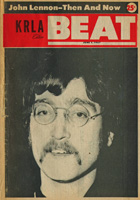
On page 3 of the KRLA Beat from fifty years ago, Tony Barrow extolls the virtues of the Beatles' most recent LP release "Sgt. Pepper's Lonely Hearts Club Band" noting its revolutionary approach to its music, cover art, and orchestration. If you were there and listening at the time, you know how extraordinary it seemed to new and seasoned ears alike. Witness the current accolades for its fiftieth anniversary. Rare indeed is a record album that holds up so well and brings fresh revelation via Giles Martin's sensitive and classy remix of his dad's masterwork.
On page 12 don't miss the run-down of pop acts scheduled to perform at the Monterey Pop Festival June 16-18, 1967. The list of names represented the premier (and some not so premier) singers and musicians from the west coast.
And on page 16 are all the nitty-gritty details in a clever advertisement, from finding hotels, purchasing tickets, clothes, seating, and transportation. Did you attend? Plan on attending in your mind? Click the image above to read all about it!
Carl Wilson vs. the Draft
05.22.67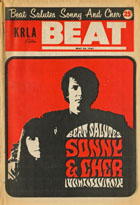
Rare was the time when such prominent people refused to participate in the Vietnam War, which was becoming deeply unpopular in U.S. society among those who were called up to serve. With this issue of the KRLA Beat we learn that the Beach Boys' Carl Wilson had neglected to report for induction on January 3, 1967. Wilson joined company with renown heavyweight champion Cassius Clay (later Muhammad Ali), who also declined to serve. Appeals would serve to keep Carl out of service altogether. There were certainly advantages to having enough money to wield legal clout. Many young men were not so fortunate and ended up paying with their lives.
This week's break-up rumor: The Rolling Stones (see page 3). There was a lot of musicianship to come for the group, albeit with upcoming and unanticipated personnel changes. No surprise to read here that the Stones' film project "Only Lovers Left Alive" had been abandoned, though.
On page 6 London correspondent Tony Barrow explores the apparently in flux pop concert scene. The Beatles were giving up touring and Mick Jagger admitted to the British music paper Melody Maker that "the one-night scene is dead terrible." Noted! However Barrow somehow failed to see the advantage of the festival-style concert series that would give rise to the Monterey Pop Festival in June 1967 and most notable Woodstock several years later. Let's go easy on Tony. Predicting the future isn't all it's cracked up to be.
Read all this and more, just click the image above left.
Shake-up, break-up
05.06.67
Despite rumors to the contrary, producer Lou Adler vehemently denied in this issue that anything was amiss with the Mamas & the Papas. True, they often spent time apart when not actively recording, but the had a solid gig in a little over a month at the Monterey Pop Festival, and multi-music-star extravaganza then in the works. KRLA and KRLA Beat editor Derek Taylor played a significant part in bringing together the artists who would perform on stage in Monterey, California in the first of its kind concert in the western United States. So for now we'll just ignore those pesky rumors, shall we?
With Derek Taylor so involved in the Monterey festival, his editorial involvement with the Beat seemed to slacken, but the reigns were ably taken up by veteran reporter, now editor herself, Louise Criscione. Check out page 7, where Criscione provides some background on why particular news stories were followed and made prominent.
When you think about the history of teen magazines in the mid-1960s it wasn't all that odd to have women at the editorial helm. But the Beat always held itself up to higher standards, going for the attention of young adults and musicians themselves. To have Louise Criscione listed as editor of the only rock music newspaper in the country at that time had some level of significance not usually recognized in rock journalism.
Click the image above to read how it all went down fifty years ago.
Get your crayons ready!
04.22.67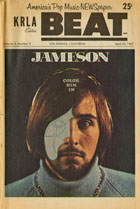
This week's cover story involves an obscure musician, Bobby Jameson, who would be sadly locked in a never-ending promise of stardom that never arrived. Promoted as the next bright young thing of protest music, Jameson (using only one name by this point) orbited around an impressive collection of rock stars who had actually made the grade, recording with and opening for the likes of The Rolling Stones, Frank Zappa, Jimmy Page, and the Beach Boys.
But Jameson failed to catch fire and drugs consumed what musical energy was left. He spent his later years trying to retrieve compensation for his music, which unscrupulous industry folks had rereleased without his knowledge. At best a talented casualty of his time, he died in obscurity in 2015. You can read more about him here. This week's issue of the KRLA Beat did its best to promote Jameson but with very little follow-up in subsequent issues, the project was doomed.
Meanwhile, on page 12, check out the short column on Peter Bergman's new experimental radio show, here referred to simply as "Oz" but more formally known as "Radio Free Oz." Bergman and his cohorts, known as the Firesign Theatre, had actually begun their free-form radio rambles on KPFK-FM, which had a long established reputation for counterculture programming. It was an unusual step for KRLA on the AM dial but it demonstrates how keen the station was to provide music and entertainment that was in keeping with the times. 1967 would be big for KRLA in more ways than one.
Read about it in detail by clicking the image above.
Much ado about nothing
04.08.67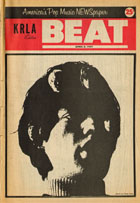
Or so says KRLA Beat reporter Louise Criscione on page 5 of this week's issue.
Her article is an attempt to portray the Rolling Stones in a non-critical light, not the bad boys they'd been branded by the mainstream media, but talented artists with a passion for music and a tendency toward politeness when addressing the press (usually the case when talking to the KRLA Beat but impossible to verify for others). And by the way, that drug bust reported in last week's KRLA Beat yielded not a scrap of drugs, folks!
This was a case of Criscione being out of touch with the reality of the situation, which was not then completely known by the public. Charges actually did come down a month later, a trial was held in June, and both Jagger and Richard (as the latter's name was then spelled) received sentences. On appeal those charges were dropped.
A more sober editorial on the subject by Tony Barrow is on page 8, where he notes that the heavy hand of the London police "doesn't sound like a clever way to solve a problem." Barrow may have been the first reporter, later on in this same column, to announce that a school drawing by John Lennon's son Julian has inspired one of the tracks on the Beatles' forthcoming new album. Maybe Jules should have gotten partial credit for the lyrics?
Page 11 carried the story of a Beatles fan, Patty Juliono, who had been a regular penpal of Louise Harrison Senior, George Harrison's mum. Patty spent a lovely afternoon when visiting England with her family in the company of George's parents, brothers, and George himself. It was rare in those days for fans to get face-time with one of the Fabs, so busy was the group in those days, but Louise treasured her epistolary pals and wanted to do a nice favor for her. Judging from the accompanying photos the trip likely occurred the previous autumn. With grave news abounding about drug busts and drafting pop stars into the military it was nice to read a story that was 100% heartwarming for a change.
Clicking the image above will take you back fifty years, where glorious purple advertising (see page 12) will psychodelicize your soul!
Boos and jeers, for a change
03.25.67
Sometimes being a manager is hard.
Brian Epstein, accompanied by a couple of Beatles, found out how quickly fans could turn at the drop of a curtain. During a Chuck Berry show in London at a theater owned by Brian Epstein, a mini-riot occurred, which brought the abrupt end to the proceedings. Epstein and Fabs got an earful from unruly audience members, and the show had to be rescheduled elsewhere.
But there was much more serious news to report in this week's KRLA Beat. The long arm of the London law captured two big names as London police (including the infamous Sergeant Norman Pilcher) decided to crack down on casual use of drugs by top-flight rock bands. An overview of the event suggests that police procedures and prosecution were more than a bit heavy-handed and illegal, to boot. Pilcher was charged with perjury in 1975, but it was cold comfort by that time, especially to John Lennon, who would himself run afoul of Pilcher in a drug bust and suffer years of botheration when trying to obtain his American green card in the 1970s.
On page 9 is a brief interview with Jane Asher, then on tour in the U.S. and Canada with the Bristol Old Vic. Some unnamed Beat reporter clearly has her knickers in a twist over Jane's refusal to comment on her relationship with Paul McCartney (which was always Jane's approach when asked about her private life). Jane had some nice things to say about American audiences appreciating Shakespeare more than the English, whom she suggests are "a bit blasé" about Shakespeare...a playwright whose name the Beat misspells. Back to school, class!
Also on page 9 is the solution to last week's puzzle. The cryptic band hiding behind the mysterious MQCB acronym was the Mendelsohn Quintette Club of Boston, a real quintet that was founded in 1849, so obviously not available to play Doug Weston's Troubadour Club. In fact, this was an advertising scheme to promote JBL stereo speakers. More about the founder responsible for JBL speakers here.
Joy is yours, even though the years have passed. Click the image above to read all about it.
The whole nine years
03.11.67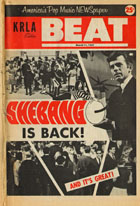
In theory, there should have been a sense of relief that the Beatles and their manager, Brian Epstein, still wanted to work together with EMI. A nine-year commitment to furthering their recording relationship indicated the sense of satisfaction that the group still had in their studio and their manager.
With hindsight and the excellent scholarship of Mark Lewisohn in his masterwork, The Beatles Tune In, it's possible to understand just how innovative and supportive Brian and EMI/Abbey Road Studios were at the time. 1967 would become the year the Fabs created their own musical masterwork, which will be enjoying its 50-year anniversary this June. Go give it a spin on the turntable and revisit the LP in all its glory.
Meanwhile, on page 3, Louise Criscione gets the definition of "a lovin' spoonful" remarkably wrong when writing about the band of the same name, but they probably misled her too, for propriety's sake. 1967 was an evolving universe, but it wasn't evolving that quickly.
The cover story (detailes on page 9) announced that Casey Kasem's TV show, "Shebang," was returning to the local airwaves, this time in color and scheduled for evening airtime. And on page 15 there's a cryptic advertisement about a band called MQCB, which ran similar ads in Billboard at this same time period. All will be revealed in the next issue of the KRLA Beat, so stay tuned, so to speak.
Read the entire March 11, 1967 issue by clicking the image above.
In other news....
02.25.67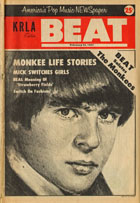
If you want to read about the Monkees, the first eight pages of the February 25, 1967 issue of the KRLA Beat are especially for you.
Personally I find the "Top Forty Requests" on page 8 of this week's KRLA Beat far more entertaining. On this list, compiled by phone-in requests as well as sales figures, the double-A Beatles single "Strawberry Fields Forever/Penny Lane" is the top record, not surprisingly. And with other contenders like "Ruby Tuesday," "I Had Too Much to Dream Last Night," "For What It's Worth," "So You Want to Be A Rock and Roll Star," and "Wedding Bell Blues" (by Laura Nyro!), the musical atmosphere was rich with its own evolving culture. What a time to be listening!
On page 13 of the Beat, London journalist Tony Barrow discusses the ins and outs of the Beatles' current single and explains how both came about. Right next to it is an article with unattributed quotes from Paul McCartney that seem deliberately provocative, fanning the flames of rumor that the Beatles were on the outs as a group. Odd statements from the one Beatle who usually went out of his way to be group-positive. Perhaps those long nights at Abbey Road Studios were beginning to take their toll.
Click the image of this week's cover and you can read whatever you want!
"This thing can't be stopped"
02.11.67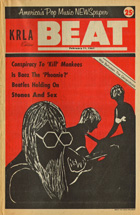
You might miss it if you're focused on Louise Criscione's somewhat peevish story about the Monkees, during which she does sommersalts trying to convince readers of their talents. They were hitmakers, no question, although they relied on songwriters and session musicians to help them along. No problem with that, of course, and the Beat would have been amiss to ignore a group that was then riding high in the music charts and in their own TV sitcom. But signs of a movement of quite a different nature were popping up all over.
The page 7 article on the "war between the generations" quotes liberally from Ralph Gleason, a San Francisco reporter for the San Francisco Chronicle. The city by the bay was having its own problems with City Lights bookstore, and other like-minded businesses, leading the way toward a free press and journalistic integrity and being duly raided by city police as a result.
Los Angeles had its share of protests on the Sunset Strip and college campuses, but the Beat goes into detail about the rise of hippie culture and the proliferation of easily procured drugs. If Beat readers weren't into this culture themselves it was easy to find folks who were. Any serious publication covering the music scene would be remiss to ignore the cultural sea change already in progress.
Meanwhile on page 9 note the article "KRLA Launches New Educational Division." Seemingly altruistic (and perhaps at least partly so), this was yet another step towards rehabilitating KRLA's reputation as a symbol of community service. This move was partly mandated by the station's FCC problems stemming from a 1964 charge of rigging promotional on-air games and falsifying log books (which happened back in 1961).
The man KRLA hired to head its "educational division" was Dr. Averill Berman (despite the misspelling in the Beat), a local professor and social activist. He correctly noted several instances where student involvement in "participatory government" had led to protests against policies that affected them directly, such as the imposition of higher tuition costs at California state colleges.
Berman was a nice addition to the KRLA newsroom arsenal and definitely contributed to the station's devotion to reporting on contemporary social issues. Alas, he didn't live much longer than the KRLA Beat. In 1971 Berman was shot dead by a talented television newsman, KNXT's Stan Duke, whose soon-to-be ex-wife was involved with Berman. Two careers were demolished in an instant. As Stan Duke himself admitted to police the night they arrested him, "It took me 17 years to get where I am and I blew it all tonight."
To read more about the music and cultural atmosphere all those years ago, click the image above.
Selling out
01.28.67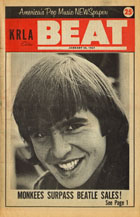
If you're going to say something foolish, make sure it's in 36-point type.
The KRLA Beat lost its mind this week by claiming that the Monkees had outsold the Beatles, and no doubt some cub reporter was being thrashed prodigiously for not checking the facts. Hey, everyone's allowed one slip-up, right? Nothing to see here, move along.
On page 3 this week's KRLA Beat reported that the Rolling Stones werer definitely set to make their movie, adapted from a novel called "Only Lovers Left Alive." How did the Beat know this? Allen Klein, the Stones' manager, told them so in his usual persuasive manner. "We have signed contracts and have been advanced 90,000 pounds. Does that sound as though there were any doubt about the picture?" Not too many years henceforward Mr. Klein would be spinning tales for another major group in England. See whether you can guess their name.
On page 7 Louise Criscione patiently reminds us that the Beatles aren't breaking up, which in 1967 was correct although it might have seemed otherwise, so absorbed were the Foursome in their own separate projects. Truth to tell, the embryonic "Sgt. Pepper" project was beginning to occupy their creative consciousness, although it wasn't so obvious to those outside their orbit.
Speaking of Fabs, a cryptic news item on page 14 seems to refer to the soon to be released "The Beatles — The Authorized Biography" by British author Hunter Davies, which in its time was considered to be a groundbreaking complete history of the group. Published in 1967, the book used the Beatles themselves, as well as family members, to tell the story of their rise to fame and fortune. Some family members, such as John Lennon's Aunt Mimi, objected to revelations that were not what she deemed proper, so the tome was pruned here and there, making it a tad less forthcoming than one would have liked. Still it's a must-read for any Beatles scholar, even today when we have true visionaries such as Mark Lewisohn telling their story in rich detail.
Click the image above to read about the music scene as it was fifty years ago.
The polymath has entered the building
01.14.67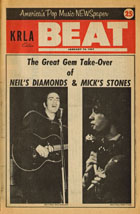
It's kind of hard to fathom how the Rolling Stones could be named number one in record sales to the American market when you had the powerhouse that was the Beatles on stage. Simple explanation: the Stones had more record releases in 1966 than the Fabs did, so technically the calculation was correct.
Not that the Stones didn't deserve it! After their August 1966 American tour the Beatles were burned out, more or less, retreating to four separate creative universes to ponder and pursue separate commitments. 1967 would prove to be a pivotal year for them in more ways than one, so all is not lost.
In other news, this week's KRLA Beat reported that Jeff Beck had left the Yardbird "by mutual consent." The unnamed source further opined (with suspicious disingenuity) that it wouldn't make any difference to the success of the Yardbirds. Pull the other one, it's got bells on.
In other news, page 7 includes a nice interview by Louise Criscione with Neil Diamond, page 12 brings Joan Baez into the spotlight, and on page 13 is the curious news that the KRLA Beat was required reading at UCLA. Prof. Kurt von Meier, a polymath and enthusiast about mathematics, cosmology, and world culture, was teaching an art history course that was far ahead of its time. The Beat, he recognized, was a unique source of news about pop music and poular culture. "Here at home" he said to the Beat "we have some of the most meaningful poetry of the 20th century, put to music by Bob Dylan and Chuck Berry. It's also amazing to see how the Beatles continue to revolutionize their industry — their genius cannot be denied." I'm with him!
Just click the link above to read about the music scene in the first days of 1967, a mere fifty years ago.
The film that never was
12.31.16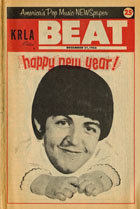
By the end of December 1966 the Beatles were about as far from making a feature-length film as they could be, but that didn't stop the KRLA Beat from speculating about it. Producer Walter Shenson, who had produced both "A Hard Day's Night" and Help!", really, really wanted to make a third film with them. His latest acquisition was a script by Owen Holder called "Shades of a Personality." Each Beatles was to play a component of one man's experience, which might have been intriguing.
But Shenson wanted to hire the trendy, edgy London playwright, Joe Orton, to "punch up" the screenplay. Punch Orton did and sent the result to Beatles manager Brian Epstein...where it remained unread for weeks before being returned to Orton without feedback. Retitled "Up Against It," the returned script was briefly scheduled for stage production in London, with Mick Jagger and/or Ian McKellen improbably considered for two of the leads. But Orton's violent death in early 1967 put the kibosh on that plan.
On the same page the Beat reported that the anticipated Rolling Stones movie was off the table. But take heart. At least the Monkees were considering moviemaking too!
Revisit the end of 1966 within the pages of this week's Beat by clicking the image above. It was a very good year!
True confessions by Brian Wilson
12.17.16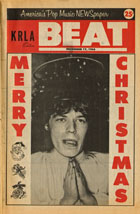
I'm not entirely sure I believe the story on page 6 of this week's KRLA Beat, purportedly written by Beach Boys genius Brian Wilson himself. They style bears an uncanny resemblance to the writing style of someone besotted by John Lennon's poetry and prose...and Beat reporter/columnist Shirley Poston could fill those winkle-pickers nicely. It's my suspicion, anyway.
Page 7 includes an interview with The Yardbirds' Jeff Beck, who acknowledges what an influence the Beatles had been on rock music in the sixties, and is careful to distinguish "electronic" music from the songs on Yardbirds' albums. Very different they are, too.
Page 11 carries a fairly comprehensive history of the infamous riots on Sunset Strip, which began on November 11, 1966 and continued for several weeks. The uproar increased just as policemen started enforcing a 10:00pm curfew for club-goers under the age of 18. While city councilman Eugene Debs referred to the protests as a "powderkeg," The New Tropicana Club down on Manchester Avenue took out an advertisement encouraging teens to come to their club. With acts such as Chet Baker and the Ray Bryant Trio, I'm guessing that the gesture was well-meant but not very successful.
There's something happening here! Read all about it by clicking the image above.
Breaking up is hard to do
12.03.16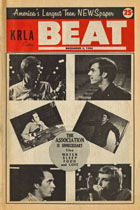
"Consensus among London music observers" was a reputable source? C'mon, KRLA Beat: the Beatles weren't close to breaking up! But speculation must have been good for newspaper sales. Citing "ambiguous" statements from Brian Epstein, the Beat fulminates about the imaginary breakup of the Fabs for more paragraphs than was necessary. Calling all journalists!
"DISCussion," the pop music review column by Nikki Eden Wine (page twelve) reviews the new release by The Yardbirds, "Happenings Ten Years Time Ago," surely their most psychedelic to date, and always worth another listen. Also up for review: Wilson Pickett's latest single "Mustang Sally." Hard to believe that those releases were fifty years ago this week.
On page fourteen you can read a short review of Mitch Ryder and the Detroit Wheels, while Rochelle Reed reviews the apparent Vaudevillian trend of music, with acts such as The New Vaudeville Band (actually a group of session musicians), Donovan, and Ian Whitcomb exploring the styles of the nineteen-twenties. Forward into the past!
Click the image above to open this week's issue and explore what was going on in December 1966. It's time travel for free.
Crazy mixed-up kid
11.19.16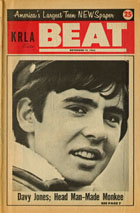
News out of London in this week's issue of the KRLA Beat involved a film that was actually never made...but its rumored existence made for good copy.
"Shades of a Personality" was a script treatment by Owen Holder, but Beatles film producer Walter Shenson hired playwright Joe Orton to whip it into shape, so to speak. The script languished with Brian Epstein for a time before it was returned to Orton without comment. Needless to say, the Fabs never filmed it.
But there was a lot of other strange news in this issue from fifty years ago. Berry Gordy marries Diana Ross of The Supremes? Never happened...but they did have a daughter together, Rhonda, it was revealed much later. Break-up of the Beau Brummels and The Yardbirds? For the former it was ill health and the draft that did them in. For the latter, songwriter Keith Relf was right that The Yardbirds weren't breaking up...at least not fr a couple more years. Hard to know what stories to trust!
Upheavals abound. On page three the Beat reported on profound changes to The Animals' lineup. On page five we learn that The Standells were thrown out of three Chicago-area hotels because their hair was too long.
On page seven Louise Criscione does her doggone best to find out what authentic talents members of the "man-made" singing group The Monkees might have had. And there were talents, apparently. Both Mickey Dolenz and Davy Jones had enjoyed acting careers (Jones, in fact, debuted on American television the same night as the Beatles, following their performance on the Ed Sullivan Show in a sequence from the hit musical "Oliver!"). And Mike Nesmith: college-educated and a fan of Renaissance music. Who knew?
Read about it all in the comfort of your own computer. Click the image above to launch this week's issue of the KRLA Beat.
Into the breach
11.05.16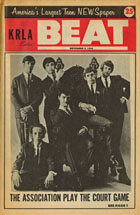
Not just one, but two publicists were alleging breach of contract by The Association, reported the November 5, 1966 issue of The KRLA Beat. What a headache! Nothing brings out the legal teams faster than success, I guess, as the group found out to their dismay.
Not surprisingly, an "unnamed Monkee" from the group of the same name admitted to New York Times reporter Judy Stone that, while they did perform their own singing, session musicians played the instrumental backing tracks. Was anyone surprised, really? This was a manufactured band for a manufactured television show, after all.
More hand-wringing takes place on page 3 of this week's Beat, where an anonymous reporter frets that Paul McCartney was about to compose a film score...without John! The horror! Not so much, really. Paul did complete the film score for the movie eventually released as "The Family Way" and the universe continued on its merry, all-expanding way.
Behind the scenes the Fabs were in a solo-exploration mode and from this point forward they'd work on their own material in addition to collaborating in the studio, just as they'd always done. Delicious offerings were afoot, such as "Strawberry Fields Forever" and "Penny Lane," albeit not yet reported in the Beat. Stay tuned!
Words to the wise: if you see something advertised that you really like and think it might not be around forever, act on your instincts and buy it. I've spent fifty years regretting that I didn't purchase a couple of the "granny glasses" in the advertisement on page 18 of this issue. I'm just saying.
Click the image above to read what was going on in pop music fifty years ago this week.
Within you, without you
10.22.16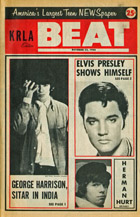
Page two of the October 22, 1966 KRLA Beat touches on some of the new explorations being made by George Harrison, whose interest in the sitar was no passing fancy. Harrison first debuted the instrument on "Rubber Soul" almost a year earlier, but by the end of 1966 (and likely feeling freed from the shackles of touring), George and Patti Harrison headed for Bombay to study with famous sitarist Ravi Shankar.
Did Bob Dylan really have a motorcycle accident? Was it worse than reported? Or did it happen at all? The discussion is still ongoing, not surprisingly. And he didn't end up on stage again until 1967.
On page five the Beat wondered whether the new San Jose band The Count Five was really a copycat of The Yardbirds. Not even close! But their hit "Psychotic Reaction" had one of the catchiest drum parts ever recorded by a garage band, and probably inspired a passel of other garage-band hopefuls at the time.
Want to read up? Just a click on the cover of this issue above opens up a world of retrograde goodness...and we mean that in a most positive sense.
Resistance is futile
10.08.16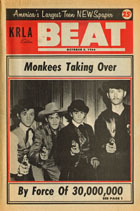
In autumn of 1966 the KRLA Beat was easily enraptured by the Monkees, the singing group assembled by NBC to star in their new TV series of the same name. The Beat interviewed a hundred or so viewers who labelled the show "groovy," "great," "funny" and "fresh." Columnist Louise Criscione, no less, praised the tunesmiths who were behind the music, Tommy Boyce and Bobby Hart. You tell 'em, Louise!
Page nine offers a look at Brian Hyland's career, at this point mostly over due to the changing landscape of pop music. There was no longer a place for bikinis, itsy-bitsy or otherwise, in the soon-to-bloom psychedelic future. "It's a gas!" he says about life in general. Good to know!
The October 8, 1966 issue also includes articles about The Association (flying pretty high at the time), Ian Whitcomb, James Brown (who says modestly "I'm a dynamo!"), and on page 17 a teen panel especially assembled to discuss whether anti-war feelings were anti-American or anti-hypocricy.
Enjoy this issue! Just click on the image above to open the Beat and read about it for yourself.
Blow Up
09.24.16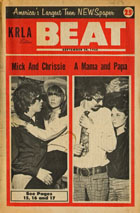
John Lennon had survived the hubbub over his remarks on religion, so much so that he sounded almost hopeful for the future. "I hope to get to see more of America because it's the kind of place that might blow up someday, by itself, or with the help of some other country." How prescient!
Meanwhile Eric Burdon wasn't quite so enthusiastic about the States. The September 24, 1966 issue carried a page one article suggesting that The Animals, as they had been, were about to undergo a shakeup in personnel. Burdon wasn't at all in love with America, not the littlest bit. He thought American fans were "much wilder, less considerate, less hip, and much louder" than British fans. Some pop singers would have seen those attributes as a feature, not a bug!
Page 6 brings an exclusive interview with Tony Barrow, still the Beatles' chief press officer and a special correspondent to The KRLA Beat. Those of you who had the chance to see Ron Howard's recent film about the Beatles' American touring years, "Eight Days A Week," will have had an insider's view into just how tired the Fabs were with the whole touring scene of 1966. For a number of reasons it wasn't pleasant, and this was clear even from contemporary news stories. But ever the diplomat, Barrow refused to confirm or deny that the Beatles would be back in the future, although it must have been obvious to all insiders that touring was at an end.
For an insider's view of the Beatles' last concert tour of America, check out Rochelle Reed's page 8 article on watching the concert from Dodger Stadium's infield, where she meets up with musicians such as David Crosby and Joan Baez, eager in their own way for a close-up view of the waning madness.
There's much else to read about, from the Mamas & the Papas, The 4 Seasons, The Remains (whose claim to fame was opening for the latest Beatles concert), and the Alan Price Set, proving that there was life after The Animals.
Relive those days now by clicking on the cover above to read this issue for yourself.
Back to the future
09.10.16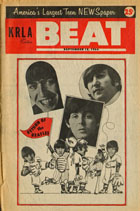
This week's Beat peruses the changes in Beatles music, most notably in their two most recent LPs, "Rubber Soul" and "Revolver." Here it was, well into September 1966, and the Beat was still musing about future concerts by the Fabs where "there won't be quite as much screaming" from the fans. Make that no screaming.
The KRLA Beat wasn't prescient. They couldn't have know that the tours were over, for good. What would follow was the group's re-emphasis on shaping their music into new forms. They were about to dedicate themselves to the craft that would make them very nearly immortal, if the last fifty years are any indication.
Meanwhile in the letters to the editor section, a passel of Beatles fans express their feelings, one way or the other, on John Lennon's remarks about Christianity. That atmosphere was a big part of those waning days of Summer 1966 and everyone had a moment to wax rhapsodic about it.
On page 6 the September 10, 1966 Beat has a curious short news story about a British group called The Move petitioning to go to Vietnam to entertain the troops. Most Beat readers hadn't read about or even heard The Move, a Birmingham band led by singer Carl Wayne who at this point hadn't even recorded a single. A later alumnus of the group would be ELO frontman Jeff Lynne.
Talk about prescient! Who knew that Hawthorne's own Chris Montez had the gift? On page 8 he talked to a Beat reporter about his early tour with the Beatles in March 1963, when the group opened for him and Tommy Roe, also on the bill. Montez admitted to having no insider information but opined that the Beatles would tour no more. "They're probably getting awfully tired," he mused.
Page 9 carries a nice interview with Brian Holland and Lamont Dozier, whose songwriting partnership had provided hits for The Supremes, Martha & the Vandellas, and The Four Tops. And on page 22 this week's Beat explains everything you've ever wanted to know about psychedelic music. Hold onto your hats! 1966 is about to take a sharp turn into the future.
Click on the cover above to read all about it.
Fussing and fighting
08.27.16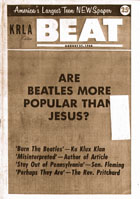
The August 27, 1966 issue of the KRLA Beat reveals a chaotic landscape in rock music. The Animals had just lost two more members of their group. The Dave Clark Five got into a punch-up at their July 1966 concert in Phoenix. And a teen publication called Datebook was the catalyst for a right royal rumpus over some remarks by John Lennon.
You can read a transcribed version of the original Maureen Cleave interview that ran in the British newspaper The Daily Telegraph back in March 4, 1966. On the whole, the complete article frames John's remarks in the deft, ironic tone he so rarely used outside of his trusted circle of friends. He knew and trusted Cleave, as did the other Beatles, all of whom were interviewed in turn and had separate profiles by Cleave published in the Telegraph. Paul could have gotten bigger press for his not-inaccurate quote about race relations in America. But it was John's thoughts on religion that sparked a controversy that very nearly derailed the Beatles' last tour of the States.
Brian Ward, a professor of American Studies at Northumbria University in Newcastle, has published a recent article reexamining the question of context in John Lennon's remarks, and it's worth a read. If you took a look at the American teen publication Datebook in 1965, it was clearly pitched to teenage girls hungry for stories about pop stars, dating, fashion, and hysterical articles about the dangers of unwed pregnancy.
Prof. Ward's argument is that Datebook was on the cusp of a re-boot of sorts, much as the KRLA Beat was experiencing with its expansion to 24-page issues and fortnightly publication. Datebook became a monthly publication rather than sticking to an every-two-weeks schedule, and its editor, Art Unger, says Prof. Ward, was keen to revamp the publication as a "socially engaged magazine."
Encouraged by no less than Tony Barrow, Unger and his associate Danny Fields pulled quotes from all four of the Cleave/Beatles interviews to highlight their controversial opinions on the problem of race relations and current affairs in the United States. The interesting point: nobody picked up at all on Paul's or Ringo's pronouncements on the horrors of segregation. The flash point was John's remarks on Christianity.
This week's Beat covers the controversy in depth, but there's also plenty of good reading about the Mamas & the Papas, Otis Redding, The Kinks, The Yardbirds, The Dave Clark Five, Odetta, and Bob Dylan. For good measure there's the "Beat Showcase" on page 14 highlighting bands and singers new to the field of pop music, most of whom would never be heard from again. Something for everyone!
To read all about that crazy scene fifty years ago, click on the cover above.
Ups and downs
08.13.16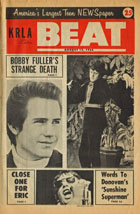
It was a complete mystery in 1966 and it's not much clearer today.
Bobby Fuller, the Texan who had two irresistible hit records in the mid-1960s ("I Fought The Law" and "Let Her Dance"), had been found dead in his mother's blue Oldsmobile under circumstances that were clearly mysterious, as latter-day investigative journalism suggests. But it was a life cut too short, and a promising career derailed.
Sharp-eyed readers will note that the August 13, 1966 issue of the KRLA Beat ushered in a new publishing schedule: bi-weekly instead of every week. Presumably this enabled the newspaper to expand its letters to the editor section and publish more in-depth articles on the music scene. The Beat also goes from a 16-page format to a 24-pager, with room to wax rhapsodic about the Beatles' new LP "Revolver," Cliff Bennett (who?) covering "Revolver," Donovan as the "magician of music" (see page 17), and a new band about town, the Everpresent Fullness (page 21). Did we mention more space for advertisements?
But the new production schedule had a down-side as well. As a bi-weekly, the Beat's news was another week older, so its ability to present timely music news was necessarily hobbled. Devoted readers adjusted to the schedule, but it was the start of a slow-moving evolution of the Beat, as well as a struggle to find a new direction in music journalism.
A note: this issue was not originally mine but was purchased to replace a missing issue in the collection, hence the penned notations. I hope whoever committed this atrocity is atoning for it now.
Click the image above to read the expanded August 13, 1966 issue of the Beat. Next update in two weeks time.
It gets worse before it gets better
07.30.16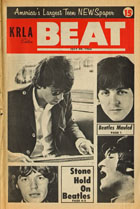
The best of times, the worst of times.
The Fabs were riding high in their careers and were on the edge of a number of musical developments that would showcase their growing creativity and innovation. It was just at this moment that they landed in Manila and faced the very mother of all publicity disasters.
By failing to turn up at an event not previously part of their schedule -- a luncheon hosted by the Filipino president's wife, the redoubtable Imelda Marcos -- the Beatles incurred the wrath of the country's rulers in a way that put them in true danger. They barely escaped the country before beleaguered manager Brian Epstein offered vast quantities of money in a bid to buy their freedom. Buy it did, but the whole experience left the group shaken to the core. No longer very fond of touring anyway, the experience probably cemented the desire of three out of the four of them never to tour again as a group. Guess which three?
Meanwhile, mainstream Time Magazine was attempting to stir things up by claiming that the song lyrics of the sixties were "smutty and suggestive" pushing "LSD and lechery." I could point out handfuls of songs written decades earlier that dealt with drugs and sex before the sixties ("Minnie the Moocher" and "Anything Goes" come to mind), but it would be pointless because we eventually won. Still, read all about the controversy on page 4 of the July 30, 1966 Beat.
This week's issue also covers the Stones, Jackie Wilson, James Brown, The Righteous Brothers, and the Lovin' Spoonful. And for a change the back page advertisement for the Hullabaloo Club is nowhere to be seen. Instead the up-and-coming king of the pop nightclub comes to the fore. During July and August the Whisky-A-Go-Go played host to The Turtles, The Doors, Johnny Rivers, The Chambers Brothers, and Love. Change is afoot!
Open the doors to perception by clicking the image above.
Mob rule
07.23.16
Sometimes touring must have seemed more trouble than it was worth.
But surely lobbing tear gas at Rolling Stones fans in Lynn, Massachusetts was over the top. "5,000 wild fans" were alleged to have mobbed a 75-man wall of police as the Stones made their getaway, and it was not a pleasant post-concert experience for anyone, one necessarily gathers.
But at the Beatles concert in Japan the authorities had clearly done their homework. They deployed 2,000 policemen to guard the Beatles against 10,000 fans, and that combination clearly worked. The Beat called it a "hysterical -- but happy -- event." Way to go, Tokyo!
In other news, the Beat covered the incendiary story of a top pop group (in this case the Mamas & the Papas) replacing Mama Michelle Phillips, fired by her husband John, it was alleged, for becoming a little too fond of The Byrds' Gene Clark. Jill Gibson had actually been involved in the music business for some time as a songwriter, collaborator with Jan & Dean (she and Jan Berry were an item for years), and singing backup as needed on recording sessions and pop television shows.
Gibson stayed with the group for just a couple months, involved in recording sessions for the group's LP eponymously titled "The Mamas & the Papas" and some touring, but Phillips decided that the chemistry wasn't enhancing the group. Gibson was out by late August and Michelle was back in her previous role. Interestingly Gibson at that point took up photography and was one of the celebrated photographers of 1967's Monterey International Pop Festival, an event in which KRLA and the Beat would play a big part in 1967. The future beckons!
Lots more to read in this issue, so click the image above and enjoy.
Why the big fuss?
07.16.16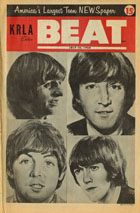
Beatles fans were apparently a lot more tolerant about artistic experiments than the KRLA Beat, if this week's letters to the editor are any indication. Most of those who expressed their opinion about the "butcher cover" that originally graced the front of "Yesterday...and Today" thought it was a lot of argy-bargy over nothing. And think of all that lost profit as a result of Capitol's reprint of the album cover! $250,000 smackers was a lot money in those days.
Courtesy of an unnamed source (probably Tony Barrow), this week's Beat treats us to a behind-the-scenes look at the Beatles recording session for "Paperback Writer." Too bad no color photos exist of this session. By the descriptions of the Fabs' clothing alone it must have been the most colorful of sessions!
Check out page 9, where you can fill out the order for for your Beatles concert tickets! With prices from $3.00 to $6.00 it seems reasonably affordable...but for some of us in days of yore, three dollars required six week's worth of savings and deprivation. Money, that's what I want.
Click the link above and read all about it!
Misplaced commas and other adventures
07.09.16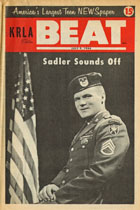
In the RCA Studios in Hollywood again were the Rolling Stones, in town to record what would be their next big hit, "Paint It Black"...or rather, as the KRLA Beat referred to it, "Paint It, Black."
The article on page 4 and 5 of the July 9, 1966 Beat actually recounts a session several months prior to the publication date of this issue (March 8, 1966, in point of fact). Recording in Studio B of RCA Records, the single was eventually issued by Decca with a curious comma on the label. The Beat reporter Tammy Hitchcock apparently was looking at the label when she wrote her report on the session because she refers to it that way too. Reissues of the record have since dropped it.
As if to highlight the changes coming to rock and roll music, Rochelle Reed tries in vain to interview the new group Love and meets with resistance and obfuscation, much of it, once can speculate, as a result of reporting techniques more suited to moptops. Their single "My Little Red Book" had garnered attention for Love, but an analysis of their music might have been better served with a reporter who shied away from standard queries about how they met and what their name means (and she didn't bring a tape recorder to the interview, Love noticed collectively, a persuasively valid point -- maybe that suggested that she wasn't entirely serious about interviewing them). Reed insisted that she was using "hip and straight" questions to get them to respond, but her conclusions are that the group is "weird" and "rude and uncaring." Read all about the debacle on page 7.
There's a lot more to read in this issue about The Miracles, The Outsiders, The Leaves, and Paul Simon (page 13) complaining that Bob Dylan is "too arrogant."
The weekend starts here! Click the link above to read all about the happenings fifty years ago.
Are friends electric?
07.02.16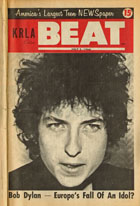
Or are folk singers not supposed to be?
Tony Barrow reported in this week's issue on the very mixed reception that Bob Dylan received in England and France during his 1966 tour. Dylan was not, despite Barrow's assertion, a "complete bomb." Dave Lifton gives a cooler interpretation of those eventful tours fifty years ago. Clearly audiences were expecting a more acoustic stage presence, a puzzlement since Dylan's biggest hit to date was 1965's "Like A Rolling Stone," not exactly a bastion of the classic folk sound.
But audiences at the time were more likely to find fault with musicians who were in the throes of adaptation and evolution. The Beatles were another prime example of a group whose whose forays into early psychedelia on their upcoming album "Revolver" would not be embraced by all fans. The best musicians explored new sounds and instrumentation, and Bob Dylan was no exception.
Sometimes change was too extreme for the general public. Witness key evidence on page 3 of the July 2, 1966 KRLA Beat: a description of the banned Beatles album cover for their next release "Yesterday...and Today." The infamous "butcher cover" was actually part of a triptych of surreal photos envisioned by longtime Fabs photographer Robert Whitaker. The group themselves were mixed about the use of the image as their new album cover, George claiming in "The Beatles Anthology" that he thought it was a stupid idea, while Paul McCartney told Capitol Records' A&R man Alan Livingston at the time that it was their protest against the Vietnam War. Rolling Stone had a recent article about it, which might be valuable to peruse for a more complete understanding of the controversy.
As Rolling Stone makes clear, the pop music world was on the edge of its own kind of revolution, with cuddly-and-cute moptop-style mania about to be left in the past. These changes would also affect the publishing world of the KRLA Beat too, as we'll see over the coming months.
To open this week's issue and read all the fuss for yourself, click the image above.
Out of many: one
06.25.16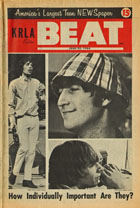
On page 4 of the June 25, 1966 Beat, reporter Nikki Eden Wine thoughtfully mused about the focus on the singular talent within the pop group. Just a few years earlier the Beatles had initially perplexed their record producer George Martin with their interwoven presence as a group of musicians. The norm in 1962 was to be Someone & the Somethings. George Martin couldn't figure out who Someone ought to be...and finally realized that their strength was in their unity of personality and sound.
For Wine it made sense to focus on the unique qualities of musicians like Brian Wilson, John Sebastian, Eric Burdon, Mick Jagger et al. And she too admitted that the Beatles were a unique case, recognizable as individuals and as a group.
Speaking of the Fabs, as the Beat tells us on page 4 the group was about to "invade" Japan where three sold-out concerts of an expected 30,000 fans apiece was about to take place. Due to an out-of-context quote in a teen fanzine by John Lennon, the summer of 1966 was about to get hotter in more ways than one. This is the calm before the storm....
Read all about those lazy, hazy, crazy days by clicking the image above to open this week's issue.
Wishful thinking
06.18.16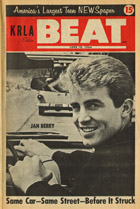
It was certainly thoughtful of Lou Adler, president of Dunhill Records, to let the KRLA Beat staff know about Jan Berry's recovery following his horrific car crash on Whittier Drive in Beverly Hills some two months before. The Beat reported that Berry was showing signs of improvement. In reality he'd awakened from a coma just a couple days before press time and was to have more than a decade of recovery ahead of him. It was a sad end to the active career of Jan & Dean.
The big news was that the Beatles were about to debut their newest album. The bad news, as the Beat admits, is that the British version of the LP had more songs on it, largely due to Capitol Records' stingy approach to paying royalties. And as a further insult, the "Yesterday...and Today" album that was released in the States was a mish-mash of tunes from the British LPs "Help!" and "Rubber Soul" as well as the not-yet-released-in-America "Revolver."
It was remarkable that in 1966 managers were still dressing their groups in wildly inappropriate stage costumes. Witness The Your Rascals on page 7 of this week's issue. They look just as uncomfortable in those Peter-Pan collars and silly hats as we do seeing them in The Beat's photo spread.
Click the image above and read all about it!
Shake-ups and make-ups
06.11.16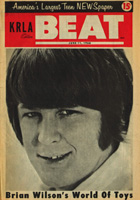
While it's understandable that Yardbirds-shakeup rumors were inevitable in mid-1966, what with all the personnel changes, the groups was still going strong after their recent hit "Shapes of Things." The June 11, 1966 KRLA Beat was full of reassurance about the group, whose next release was revealed to be a number called "Over, Under, Sideways, Down." It too would enjoy a nice run up the charts.
This week's issue gives us a follow-up from Tony Barrow on "Only Lovers Left Alive," which was meant to be a cinematic vehicle for the Rolling Stones, and to be directed by Nicholas Ray, whose best-known film was "Rebel Without a Cause." The joke was on Tony Barrow. The Beatles' third film (such as it was), actually did come out before the Stones' film...which was never made.
Page 4 offers a serious interview with the Stones whose opinions are sharp as well as on point. Yes, Mick thinks that Peter Noone was "kind of weak and watery" and he shrugs off the pop scene in England entirely. As for the reason their latest single had a comma in a weird place ("Paint It, Black"), Keith Richard blamed it on their label, Decca.
There's much more good reading in this week's issue. Click the image to download a copy for your reading pleasure.
Sorry folks, no sitar
06.04.16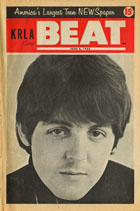
Tony Barrow reveals that the upcoming new Beatles single ("Paperback Writer"/"Rain") is "packed with technical specialties" that should delight Beatles fans, even if there is no sitar in the mix.
In other news, the Rolling Stones managed to procure a payment of a million dollars for their first feature film, to be adapted from the British novel "Only Lovers Left Alive". Wonder whether they had to give the money back when the film wasn't made?
This week's Beat also looks at the "writer's revolution" driving pop-music's composers, two groups who released the same single (The Remains and Captain Beefheart), a possible comeback by The Tokens, and an overview of Roy Orbison's career.
Clicking on the image above to read all about the music world as it was fifty years ago.
Everyone is going through changes
05.28.16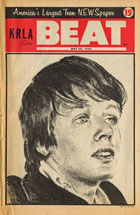
Change is in the air in May 1966 and it seems to hit the KRLA Beat at full force.
Remarkably the British Invasion had begun to wane, according to Louise Criscione's page 2 story. Fewer English groups were on the American charts, now dominated by domestic acts. Yet in a case of holding two exclusionary philosophies at once, the Beat also notes (page 12) that British films, television, and culture had never been more popular in the United States. It's ambidextrous news reporting at its finest, I guess.
"No questions allowed" says the Beat on page 13 in a chaotic photo story about the Velvet Underground coming to The Trip, a happening club on Sunset Blvd. "It's a pair of dancers, a candle, two whips, a candy bar, a violin, a pop bottle, and movies," notes the story enigmatically.
The Trip was an over-21 club that had hosted more standard folk and rock groups such as the Byrds, the Grass Roots, Barry McGuire, and the Leaves. By early 1966 the night club was venturing into new territory, with appearances by the Paul Butterfield Blues Band, Frank Zappa and The Mothers, and the Modern Folk Quintet.
Billed as "Andy Warhol’s Exploding Plastic Inevitable," the Velvet Underground had not actually released a record at this stage of their game, but provided a surreal media entertainment that presaged (or was, in fact) psychedelic. Beat reporter Louise Criscione ventured an opinion in her "On the Beat" column (page 2) that Velvet Underground vocalist Nico could not sing. Mick Jagger apparently disagreed. Time and hindsight would settle the argument.
Open this week's issue of the KRLA Beat by clicking on the image above.
The waiting is the hardest part
05.21.16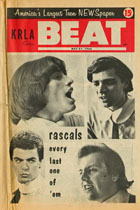
The short article on page 2 about the forthcoming new Beatles single gives a sense of how far ahead some news stories had to be written.
The scoop from Beatles press officer Tony Barrow alerted us to the June 6, 1966 release date for "Paperback Writer"/"Rain" but the unnamed reporter complains that you'll have to wait "practically a whole month" to buy it.
Actually the May 21, 1966 issue of the KRLA Beat was likely written closer to the first week of the month, then sent to the typographer, proofed, printed, and distributed/mailed almost a week before its cover date. By the time you were able to read any weekly issue its news may have been slightly out of date. But the wait would be less for that all-to-important next Beatles release.
This week's Beat also covers Sonny & Cher, The Sunrays, bluesman Jimmy Smith, The Outsiders, and an in-depth feature on Ringo Starr.
There's plenty to read so click the image above to open this week's issue of the KRLA Beat.
Mad Men
05.14.16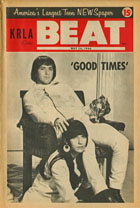
Amidst the repetitious news stories about bad movies (tell me, how many times have you watched and re-watched Sonny & Cher's "Good Times"? Thought so!), contretemps between rock groups (does it matter about the Rolling Stones and the Walker Brothers?), and puff pieces about Bob Lind a.k.a. The Man Who Cannot Believe He's Popular, we find a curious advertisement on page 14 of this week's KRLA Beat. A full page ad, mind you.
It touts a new single by a band called Opus 1 called "Back Seat '38 Dodge." The hook in the title referenced a then-controversial art piece by Edward Kienholz at the Los Angeles Museum of Art (actually titled "Back Seat Dodge '38" but who's quibbling?). The song itself presages The B-52s' guitar sound and has been described as punk, surf, garage...and the group leader reminisces here about what it was like in the studio in 1966.
To hear the song and see what it was all about, visit this clever YouTube page and see whether you think this was the dawn of psychedelia. Personally I'm reserving my opinion for now.
Click the image above to read all about it.
The price of love
05.07.16
It seemed unbelievable in an era where rock and roll was marching forward towards a horizon where psychedelic music was emerging. But the Everly Brothers, who had been radio and recording artists since the 1940s, were experiencing a resurgence in the Far East and England.
Page 12-13 includes a spread on how the Everlys were selling out throughout The Philippines, Vietnam, and Hong Kong. It was a remarkable come-back for a group whose records had considerably influenced The Beatles' own harmonic approach to their own music.
If you happened to notice the April 30 article in the Beat on dueling shenannigans at the Hullabaloo Club, it may help explain the slim pickings at the club in this week's KRLA Beat advertisement. The club's owner, Gary Bookasta, managed to hang on to Dick Dale this week plus the club's resident band The Palace Guard, but gone were the Mamas and the Papas and the Modern Folk Quartet.
The Mamas and the Papas had been warned that Bookasta shortchanged P.J. Proby by paying him less than agreed. Bookasta protested that all contracts had been fulfilled and there were a passel of misunderstandings. Who knows for certain? The Sunset Strip nightclub scene was evolving, and there would be more surprises ahead for the club as time marched on.
Read all about it by clicking the image above.
They'll be back
04.30.16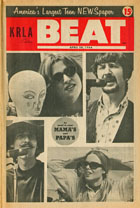
For all the joy brought to Beatles fans by the page one announcement of the Beatles' 1966 tour schedule, in hindsight we know, fifty years out, that there was very little joy in it for the Fabs. Four years after beginning their recording career at Abbey Road, the group had made huge strides in songwriting and musicianship since September 1962. Their best work was no longer on stage. They already knew it. We were about to learn it ourselves.
On page 2 The KRLA Beat ran a scathing retort from Chad and Jeremy, who had been accused by Louise Criscione in an April 16th article of attempting to avoid the American draft. How she got her facts so wrong is anyone's guess at this point -- the singing duo were British resident aliens in America, not citizens, and not subject to the draft. Chad and Jeremy's rebuttal very nearly smokes with indignation.
On page 6 is possibly one of the earliest article to treat Brian Wilson as a substantive producer, and it's a treat to read Brian's ultra-lucid thoughts on the subject. It would be some years hence before Brian's skills were widely acknowledged and appreciated.
Go ahead, wallow in the world as it was fifty years ago! Read these stories and much more by clicking the image above.
The long and the short of it
04.23.16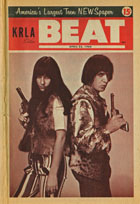
It was kind of a social interaction communications thing: in April 1966 the KRLA Beat began to embrace controversial topics that were central to its readership. What could be a hotter topic than hair length and how school officials viewed it?
Hard to believe nowadays that the tonsorial fashion style wrought by the Fabs was the cause of academic crackdowns on students' hairstyles. But administrators felt they had a right to enforce vague wording that compelled students to "submit to the authority of the teachers of the school." If they didn't like your hairstyle they had a right to suspend students, or, in the case of one San Diego 15 year old, more extreme intervention. The unnamed student was "forcibly held down while a teacher sheared his head with sheep shears." A $28,000 lawsuit resulted.
In this week's issue you can also read about the Beau Brummels, Dionne Warwick, the Young Rascals, and Gerry Marsden, who held a surprising opinion about Bob Dylan.
To read more news and views from fifty years ago, click the issue pictured above.
"I ain't marching anymore...."
04.16.16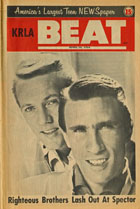
As 1966 marched on ahead, the KRLA Beat began to approach some of the social controversies of the day. On page 2 Louise Criscione provides an overview of American and English approaches to the system commonly referred to as The Draft, the lottery system then in place to compel military service. Interviewing young people and entertainers, she invites Beat readers to chime in with their own opinions...and there would be many as protests over the Vietnam War began to make news.
Page 10 includes a brief overview of The Jefferson Airplane, then with singer Signe Anderson, who had not yet been replaced with Grace Slick. They successfully evade Carol Deck's serious questions with a passel of silly answers. As Deck notes, the group was big in San Francisco and was looking to expand to other musical horizons. That mission, it goes without saying, would be accomplished shortly.
Page 14 includes a more than half-page advertisement in the form of an obituary. Jim Washburne had been a KRLA deejay and program director for the station from 1961 through 1963 and was responsible for the hiring of "Emperor" Bob Hudson. He then enjoyed on-air success in San Francisco station KYA-AM. He was driving back from Big Sur to SF and fell asleep at the wheel. He was 32 years old and clearly much missed by his KRLA compatriots.
Click the image of the April 16, 1966 issue to read more news and views from fifty years ago.
A well-respected man
04.09.16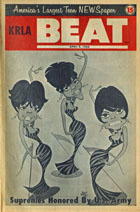
The man who claimed he didn't want to be a pop star has now, fifty years later, made quite a career out of it.
The Kinks, then riding high in the charts, were profiled in the full-page article on page 3. Perhaps, for Ray Davies at least, it's more accurate to describe his brand of lyrical commentary as one of a kind. His keen eye for detail helped him explore the Victorian age, British wartime, and the changing landscape of pop music as well as society at large. The hints of his genius were all there in 1966.
Page 12-13 includes an in-depth article by Nikki Eden Wine about the Rolling Stones, who were in Hollywood for a closed recording session at RCA. Somehow a Beat reporter was able to sit in on the session and provides details of the varied instruments used in this session, pointing to "Aftermath" as the album in progress. The Stones had been in Hollywood just a month pefore to complete the LP as well as their next single, "Paint It Black."
Barrow refers to her series in the London Evening Standard this past March 1966 with a couple of pithy pull-quotes. The entire article on John is worth reading in full, if just to give proper context to the entire piece. A short excerpt, lifted without context in the teen magazine "Dateline," was about to give rise to the "bigger than Jesus" remark that made the group's tour later that year more or less a suitcase full of pain.
To read all about it, click the image of the April 9, 1966 issue above.
It's all happenin' at the zoo...
04.02.16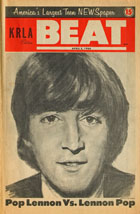
KRLA Beat reporter Nikki Eden Wine takes us on a field trip with the Beach Boys in the April 2, 1966 issue. Sojourning to the San Diego Zoo to photograph cover artwork for their forthcoming "Pet Sounds," the Beach Boys visit animals and pose up a storm. PopSpots writer Bob Egan meticulously reconstructs the places that the boys visited that day.
If the advertisement on the back cover is any indication, Dave Hull's Hullabaloo Club was beginning to attract some pop-worthy acts, such as The Mamas and the Papas, Dick Dale, The Turtles, and Peter & Gordon. This was around the height of its popularity as a teen club in the heart of old Hollywood, where the under-21 night scene continued to grow.
You'll also find good articles on Ray Charles, Johnny Cash, The Turtles, and more in this week's issue. Just click the image above to read all about it.
The Great Singles Slump of 1966
03.26.16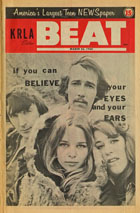
As Louise Criscione notes on page one of this week's KRLA Beat, for the first time since they became popular, the 45 r.p.m. record was no longer as popular as it had been throughout the rise of rock. It was a convenient, inexpensive, and accessible way to get music to young people, but as the long-playing album became more innovative and interesting, buying habits changed.
The Beatles were likely at the heart of the matter. Their sudden popularity in 1964 gave rise to an appetite for all things Beatles-related, and the more songs you could listen to, the better. In the world of pop music it had always been part of the package to include the hit single on an LP that was otherwise packed to the rafters with forgettable tracks. But as Criscione notes, the Beatles changed all that, and music listeners began to shift gears in favor of more musical selections.
Gil McDougall's page 3 article on The Rolling Stones is worth a read as well. McDougall delves into the pre-musical career of each of the Stones and discusses the group as serious musicians...a fact of life that many parents at the time were unable to comprehend. What fifty years will do to enhance the reputation of a rock group...still rocking Havana, Cuba today.
This is an issue jam-packed with good reading. Click the image above to peruse the March 26, 1966 Beat!
End of an era for The Cavern
03.19.16
Page 2 of the March 19, 1966 KRLA Beat brought some sad news about The Cavern Club, the venue that provided The Beatles and countless other beat groups with a musical platform. Originally a jazz club (i.e. trad jazz, the British version of Dixieland), the club gradually bowed to the inevitable when groups playing Merseybeat became more popular than trad. Ray McFall, the club's owner, took the hit with $42,000 in debt. The concept of rock memorabilia had not yet become reality. If it had, the Cavern might have been preserved and enshrined in appreciation for its history.
On page 11 Susan Frisch writes about Peter & Gordon's newest single, "Woman," written (allegedly) by "some unknown but certainly talented song writer." Credited to Bernard Webb, it didn't take long for the single to become number one on the charts. Eventually it was revealed to have been the work of one Paul McCartney, who said he was curious whether he could have a hit with an anonymously composed song. Not surprisingly, he proved that he could.
Read more by clicking the image above.
"Ready for success"
03.12.16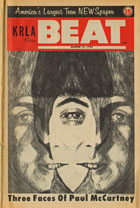
The article on page 4 of this week's KRLA Beat is something of a puzzlement. Al Martino was not exactly part of rock and roll programming. In fact, the ascent of rock played havoc with careers of crooners like Martino, whose biggest hit was in 1952 with "Here In My Heart." By 1966 he was looking for the sixties equivalent of a reboot. Further chart success eluded him, although he gained some acclaim by becoming an actor instead.
On page 10 in this issue you can read all about The Byrds in an interview conducted by three of their fans...a unique undertaking that is an earnest effort on the part of the three budding journalists.
Click the image above to read this week's Beat in depth.
Come to the cabaret
03.05.16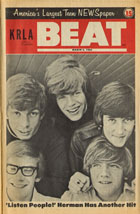
Tony Barrow's "Hotline London" column in this week's KRLA Beat is certainly worth a read. He outlines the changing shape of music performance in London with articulate clarity and analysis.
The bigger pop venues were no longer making money as they had in days of yore, except for the very biggest acts such as The Beatles and The Rolling Stones. Now, in early 1966, popularity was shifting to intimate nightclubs and cabarets where one or two performers could be showcased, such as Dusty Springfield, Gerry & The Pacemakers, Cilla Black, and the irrepressable P.J. Proby. Barrow's portrait is better than a time capsule for capturing the musical scene in London.
On page 3 of the March 5, 1966 Beat is a thoughtful, non-fanzine interview by Bob Feigel with David McCallum, then riding high on the wave that was "The Man From U.N.C.L.E." With a strong theatrical background, McCallum had worked his way through other television opportunities to land a role as a sort of hybrid spy, a sort of mix of James Bond and John Steed ("The Avengers"), but with a Slavic twist. The show's popularity was phenomenal at the time.
A new Beat reporter, Anna Maria Alonzo, details the burgeoning popularity of Nancy Sinatra, whose career as a singer was slow to catch fire (she'd been trying for a hit since the early 1960s), but when it did, it sizzled. Her current hit, "These Boots Are Made for Walkin'" was making waves on the charts.
George Lincoln Culver (another new Beat reporter) discusses a KRLA documentary produced by newsman Lew Irwin about the legitimacy of the draft, the lottery system by which young men were compelled to serve in the armed forces. Considering the growing intensity of the Vietnam War and the youthful KRLA listenership, this was a serious and timely topic... and an expeditious way to fulfill KRLA's obligation to present public service programming.
There are lots of serious topics under discussion in this week's KRLA Beat. Click the image above to read in depth.
Behind the scenes at KRLA
02.26.16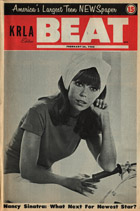
Page 8 of this week's KRLA Beat carries an "Inside KRLA" column of some interest, detailing two behind-the-scenes stalwarts who contributed to the station's overall success.
Sie Holliday (originally Shirley Schneider) worked in radio as one of the few women broadcasters of the early 1960s. She was with KRLA from 1962 and her voice was heard on Sundays with her own show for several years, and again as one of the narrators of John Gilliland's acclaimed radio series "Pop Chronicles," the first-ever show to treat rock-and-roll as a serious art form. Sie was part of the Los Angeles radio scene until the late seventies, when she retired and took up theatrical direction. She died in 2006.
KRLA newsman Jim Steck was also profiled in this issue. A serious reporter, he also teamed up with Dave Hull for a spontaneous plane flight with the Beatles one day, and performed extensive interviews with John Lennon. Hull's and Steck's interviews were captured for posterity on the LP compilation "Hear the Beatles Tell All" in 1965.
Louise Criscione has a nice overview of a British band on page 11, just beginning to hit the U.S. charts with a big hit: The Hollies. Also revealed was a surprisingly harsh comment from George Harrison over The Hollies' version of "If I Needed Someone," a rendition that Harrison apparently didn't like. Oh well...you can't win 'em all.
Click the image above and you can read exactly what The Hollies thought about it all.
Jazzing it up
02.19.16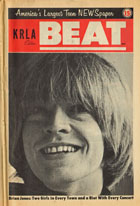
This issue seems at war with itself, and from the battling journalistic approaches it's hard to know whether the KRLA Beat is veering towards fanzine hysteria or trying to broaden its appeal as a music newspaper.
The news of George Harrison's marriage from last week's issue seems to have sent one overwhelmed veteran reporter over the edge (see page 6). In Beatles news it was true just about this time that the group didn't seem to be doing much in public (except getting married, having moped accidents in Liverpool, etc.), so maybe the mournful reportorial tone was to be expected.
In an attempt to appear to be hip, reporter Carol Deck takes on jazz musician Bud Shank, who expounds on the "wrong" way Beatles music was written: "A well schooled musician just wouldn't have written like that," Shank helpfully explains when discussing "Yesterday" and "Michelle," two songs that had begun to cross over into mainstream middle-of-the-road arrangements. John Lennon was also doing it wrong when he wrote his books, according to Shank. You stick to your saxophone, Bud, and let the Beatles do what they do best.
Read it yourself in the February 19, 1966 Beat by clicking the image above.
Wedding bells for a Beatle
02.12.16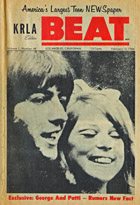
You can read all about George Harrison's marriage to Patti Boyd on page 2 of this week's KRLA Beat, and of particular interest is the eyewitness report of Beatles publicist Tony Barrow. With this issue he began a series of "Hotline London" reports on the British music scene.
In addition to news about George and Patti (of course), Tom Jones, and Paul Simon, Barrow recounted Paul McCartney's moped accident that caused a minor facial injury. While Barrow dismissed the severity of the accident, its effects were persistant enough to be noticeable in the two music promos the Beatles would make in March. Sharp-eyed viewers of the "Paperback Writer/Rain" promos will note that Paul smiles less than usual and in several shots a chipped tooth can be seen.
On page 5 you can read the debut article by Mary Ellen Criscione, sister of Beat reporter Louise, on the Walker Brothers, who were trying to make up their mind whether to be American or English. Of course the trio was made up of three guys not named 'Walker' and not really brothers...but who's counting?
Click the image above to read all this and more in the February 12, 1966 Beat!
Batty
02.05.16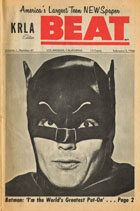
There were some folks, back in the sixties, who didn't get the concept of camp...so the TV series "Batman" demonstrated it for them. This week's KRLA Beat explores the phenomenon of the new TV debut, ostensibly based on the DC comic character of the same name, but that's where the similarity ended.
Adam West, who starred as Batman, believed that he was hired over better-known actors because he alone could deliver his improbable dialog with a straight face. Certainly it was an attraction for well-established actors looking for a momentary romp through satire. The likes of Burgess Meredith, Cesar Romero, Frank Gorshin, Eartha Kitt, Julie Newmar, George Sanders, and (of all people) Rudy Vallee, among others, lent their talents to the show. KRLA was also enraptured, arranging a photo session where its deejays were pictured in miniature, arranged artfully around Batman's formidable physique.
In other news, you could pick up enough home decor tips reading about Sonny & Cher's Encino home (page 6) to replicate the same "Spanish Rustic" style in your own home, should you wish to do so. Also previewed in the February 5, 1966 issue are The Yardbirds, The Fortunes, The Kinks, and on page 10 a nice review of Doug Weston, owner of The Troubadour club, still home to famous folk groups. The proofreader must have been on holiday for this issue. "Troubadour" is misspelled throughout the article.
To read this week's KRLA Beat, just click the image above, and you'll be groovin'!
Parties to the left of me, parties to the right....
01.29.16
This week's KRLA Beat breathlessly covers two events of note: a party given for The Yardbirds at the Hollywood Hills home of producer Kim Fowley, and a separate one for Gary Lewis & The Playboys in honor of their first year as a band. Both groups were doing well on the charts through 1965 and into the early days on 1966 with multiple hits for both. Arguably the bigger influence on mid-sixties music was from The Yardbirds. But their pursuit of pop hits had cost them their most innovative guitarists. Never mind! Eric Clapton would be back eventually in a very different guise.
The little advert on page 10 of this week's Beat champions something they were calling "The First All Star Folk Festival," but it wasn't exactly all folk all the time. Produced by the same folks who had released the successful "T.A.M.I. Show" a year earlier, this production was called "The TNT Award Show." Joan Baez and The Byrds were among the headliners, but with folks like Ray Charles, The Ronettes, Petulia Clark, and Bo Diddley, there was definitely a blues/pop vibe as well.
Meanwhile over at The Troubadour Club, real folkies like Chad Mitchell, Buffy St. Marie, and Judy Collins were part of the line-up. Forgive the poor typesetter who didn't know Collins well enough to spell her name correctly!
On page 13 The Beat notes the rise of the long-playing record album. In the new column "Albums Go 'Round" the phenomenon of rock-and-roll LPs, as opposed to singles, is discussed in detail. It seems second nature to us now, but previous to the Fabs the single was king. Pop LPs were an afterthought, packed mostly with forgettable fillers of little interest.
That changed in 1964 when The Beatles arrived. KRLA was one of the few forward-thinking stations to start playing Beatles album tracks in addition to hit singles. Listeners got the benefit of hearing the group's less familiar tracks, and as other stations hopped onto the trend, LP sales went up. By 1966 the stage was set for the type of playlists that FM radio would shortly embrace. The rise of FM would, sadly, spell the beginning of the end for AM radio. But don't despair. 1966 was by any measure a banner year for KRLA and other stations like it...and for the music they played.
Read the January 29, 1966 issue by clicking the image above.
A man called Bob
01.22.16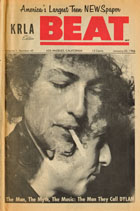
From page three through six this week's KRLA Beat was focused on Bob Dylan. Plowing through reporter Nikki Eden Wine's rather stream-of-consciousness prose is a bit of a challenge but there are some observational gems there. Chuck Boyd's photography is the highlight of the piece.
This makes the third issue where the Beat mentioned the difficulty encountered by the Beatles in lining up their third film, which they were contractually required to complete. The Richard Condon novel "A Talent For Loving" was deemed inappropriate for them (it was produced in 1969 by Walter Shenson with a decidedly non-Beatles cast).
The Fabs were then sent an unsolicited script by British playwright Joe Orton called "Up Against It," which was returned without comment by their office in 1969. Eventually United Artists agreed to the concept of an animated film with a brief live appearance by the foursome themselves. "Yellow Submarine" would be completed in 1968.
You can also read about Jay & The Americans, The Rolling Stones, Sam the Sham & the Pharaohs (who had ditched their old look for something new), and two guys named Jones (Tom and Jack...no relation!) by clicking the image above.
Silver and gold
01.15.16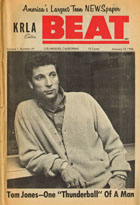
It was a real mix of silver and gold artists in this week's KRLA Beat. The gold, of course, was the Beatles' latest LP, "Rubber Soul," which sold a million dollars worth of record in just one day, as Louise Criscione explains in her front-page article. At this stage in their career it would elicit gasps of surprise if a Beatles record hadn't gone to number one.
The "silver-haired" oldsters of rock-and-roll's first great flowering were well represented in this issue. Elvis turned down a tour of England but the Everly Brothers were just on their way to tour the UK, and it was clear how much they appreciated the opportunity.
It's also amusing to watch two folk groups vying for attention in the Beat. On page 8 was a story about the up-and-coming duo Simon & Garfunkel, while on page 15 The Kingston Trio strives for relevance in a changing world of folk music. Their career was nine years old at this point, and their latest release used electric guitars for the first time ever. It was hard to be heard in a musical world where the likes of Dylan, Donovan, and The Byrds were reinventing what folk music really meant.
Lots of other good reading in the January 15, 1966 KRLA Beat on Mel Carter, Glen Campbell, The Lovin' Spoonful, and a host of others. Just click the image above to open a copy of America's greatest rock newspaper.
Who's on first?
01.08.16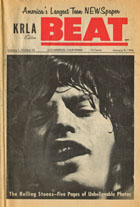
Before you peruse the news in the January 8, 1965 issue of the KRLA Beat, take a look at the back cover. Dave Hull's Hullabaloo Club was beginning to amass an admirable lineup of rock stars for what was still a relatively new nightclub. Del Shannon, Ike & Tina Turner, Mitch Ryder & the Detroit Wheels, The Yardbirds...those were some of the prime hitmakers of the sixties.
The Rolling Stones dominated the first few pages of this week's Beat with interviews, press conferences, and KRLA's exclusive photos of the group. But there was a new band on the horizon known as The Who, and the KRLA Beat profiled them on page 14.
Their first successful single in the States was "My Generation," clocking in at number 24 (up from 29) in this week's Tunedex. Also on the Tunedex at the top this week were both sides of the Beatles' newest single, "Day Tripper/We Can Work It Out." British chart activity also showed the song as a number-one double "A" side but Billboard, with its retrograde mindset, listed the two songs separately, with "We Can Work It Out" at number one and "Day Tripper" at number 8.
The Fabs had another hit on their hands but this one was on the album charts. According to Billboard, their holiday release Rubber Soul had sold 1.2 million copies in just nine days, and according to Capitol Records this broke every other sales record previously held by the group.
Read the January 8, 1965 issue of the KRLA Beat by clicking the link above.
Everybody wins!
01.01.16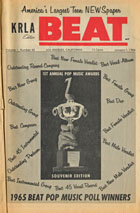
The KRLA Beat throws confetti in the air at the conclusion of their first International Pop Music Awards. Not quite everyone won, but the usual suspects certainly did. Read all about it on page two through six...profusely illustrated throughout this issue.
One of the biggest LP releases of 1965 was the much anticipated Beatles release, "Rubber Soul," groundbreaking in a number of ways and (one might argue) still garnering praise today. On page 15 Beat reporter Nikki Eden Wine (bylined here as Eden) compared the American and British versions of the albums.
Capitol's approach at the time was to pare down the number of tracks available on American albums, something that irritated the Beatles own producer George Martin -- but Capitol (which EMI owned) was still calling the shots. Noted and reviewed are the three new-to-American-ears tunes: "Drive My Car" (with Paul on vocals), "What Goes On" (Ringo), and "If I Needed Someone" (George). Most American fans at the time were unaware that they were being short-changed with each album purchase. This practice would end with the 1967 release of "Sgt. Pepper" when all versions of Beatles LPs would be standardized.
Ry Cooder fans may want to check out page 16 for a nifty photo of The Rising Sons, recently signed to Columbia Records. The group's lineup at that time included Taj Mahal, Jessie Lee Kincaid, Gary Marker, Ry Cooder, and Kevin Kelley.
To read the issue, just click on the image above left.
Holiday hullabaloo
12.25.15
Predictably, the December 25, 1965 issue of the Beat was full of holiday messages from music and entertainment stars, and it's interesting to note that some TV folk who had no connection to pop music were also represented. It's an indicator of how high their stars were aligned for this brief period. Ask your random person-in-the-street today who Robert Vaughn and David McCallum were and you'll likely get a very blank look. But any veteran of the time can name them as the stars of "The Man from U.N.C.L.E" in its original TV iteration.
Carol Deck's article on page 6 is worth a read just for the introduction of a new band called the Great Society. Named after a series of domestic programs launched by then-president Lyndon Johnson, this group was headed by Jerry Slick, his brother Darby, and Jerry's wife Grace. Darby had written a nifty little ditty called "Somebody To Love," and once Grace was part of her next band, the Jefferson Airplane, it would help to define an era. But at this moment in time that was all in the future.
Dont miss Louise Criscione's excellent preview of the forthcoming second "T.A.M.I Show," which was filmed in Santa Monica in 1965 but which would premiere in cinemas on January 26, 1966. The lineup was quite different from the previous edition of the show, but this represented how quickly the music scene was evolving. 1966 would prove to be one of those years when everything and everyone was explosive... in a very good way!
Click the image above to read all the holiday cheer from fifty years ago!
"12-Bar Original" did not make the cut
12.18.15
Thankfully the Beatles' attempt at soul music was recognized for what it was: "plastic soul," the phrase applied to singers like Mick Jagger, who were only playing at singing the blues. The Fabs' attempt at blues was as painful as it was misplaced, and until it was included in "The Beatles Anthology" series "12-Bar Original" was unheard by most fans (except for those who pursued every scrap of Beatles music on bootlegs).
But put that same phrase through the Fabs' transformative mindset and you get "Rubber Soul," not just the name of their newest LP but a collection of songs mostly unique, thoroughly trendy, and entirely noteworthy. The album cover didn't even need their name attached to it, so arresting was Robert Freeman's distorted picture. Everyone knew who they were. The KRLA Beat didn't even bother to run a headline on this issue's cover. But the music inside would shape the future of rock.
The December 18, 1965 issue of the Beat also has some nice words about up-and-coming acts such as The Association, The Mojo Men, The Grass Roots, We Five, and The Beau Brummels. If you click on the cover of this week's Beat you can read all about it for yourself...and imagine you're back in those halcyon days.
I'll be back to baroque
12.11.15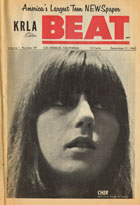
On page 12 of this week's KRLA Beat is a fleeting reference to "The Baroque Beatles Book," which was only partially a tongue-in-cheek parody. Reinventing the Fabs' compositions as baroque-styled concerti was an earnest attempt by Julliard-educated composer and orchestra leader Joshua Rifkin to explore the solid musicianship of Beatles music, as well as having a little fun, Peter Schickele style, with the concept of swapping rock for Bach.
The album was released in late 1965 on Nonesuch Records, a label that had been launched the year before to provide affordable but quality classical music to listeners whose budgets precluded works on more pricey labels like Telefunken and Deutsche Grammophon. Joshua Rifkin also recorded two LPs of music by then mostly forgotten Ragtime great, Scott Joplin, which helped to relaunch his popularity and focus on the artistic legacy of one of music's earliest great African-American composers.
This wasn't the first time that someone in the classical field sought to elevate Beatles music out of the pop arena. One of the first serious articles on their compositions was published at the end of 1963 in the London Times by William Mann. His article, "What Songs The Beatles Sang," left his classical compatriots all agog, if not aghast, by interpreting their compositions using classical terminology. He was a legitimate critic and he really believed them to be "[t]he outstanding English composerss of 1963." Read the original article here and don't forget to hang on to your aeolian cadences!
You can also read about Mel Clark, the Dave Clark Five, the Miracles, Roy Orbison and more musicians of the modern era by clicking the image above. You won't want to miss a beat of the December 11, 1965 issue.
Rock and roll showplace
12.04.15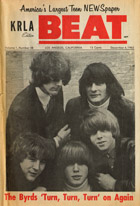
The building at 6230 Sunset Boulevard was used to entertainment. It had already changed its image several times.
It opened in December 1938 as the Earl Carroll Theatre, full of showgirls and big-band swingers. Then it shifted to the Moulin Rouge nightclub, where the soppy daytime show "Queen For A Day" was filmed in the nineteen-fifties.
Embarking on a new career move, Dave Hull became the next master of ceremonies of the renamed Hullabaloo Club, which this week's KRLA Beat celebrates on page 9. Catering to teenagers from 15 to 21 years old, the club would provide a relatively safe haven to see local and distant pop stars at just $1.50 admission fee. That was practically affordable, if one was careful with one's weekly allowance. Dave kept his deejay gig, of course, and it's a good thing too.
The Hullabaloo lasted long enough to garner some claim to fame by its house band, the Palace Guard, but after a falling out with his partner Dave Hull retreated to the welcoming warmth of the KRLA studios. The Hullaballoo turned into the Kaleidoscope briefly, where it hosted The Doors and other acts, then was quickly co-opted for the traveling company of the musical "Hair," renamed The Aquarius Theatre for the duration. Most recently it belonged to Nickelodeon, and is now waiting for Hollywood to preserve it for historical posterity.
Click the image above to read all about it.
Teenager's turn
11.27.15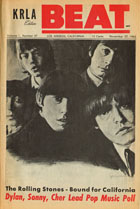
It's the same old song: teenagers and their angst. Ten years earlier it had been the advent of rock and roll. This time, according to The Byrds, it's a revolution.
This week's KRLA Beat fifty years ago asked members of the Byrds what they thought about their teenage fans and how this revolution had come to be. The cumulative opinion was that music fans, whatever their age, were paying more attention to the world, asking more questions about society and their role in it, even watching less television. These sound like positive developments, all things considered.
Are you one of the people who could never quite figure out the words to the Rolling Stones' "Get Off My Cloud"? Me too! But this week's Beat has the solution. Turn to page 12 and you'll see the lyrics laid out for you in glorious black and sepia.
On page 14 you can read all about The Kickerbockers, who at this point were just beginning to dream big. Their future hit "Lies" was just a twinkle in the eye at this point, that Beatles-sounding single that fooled a lot of folks into believing it was the real thing. Here they're just gearing up for the future.
Fifty years ago this was the face of pop music. Enjoy it by clicking on the image above.
Third time's the charm
11.20.15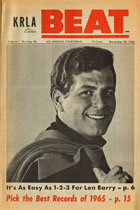
It's the Story That Wouldn't Die. What else? "Shindig" was still on KRLA's collective mind...and thus on the front page of this week's KRLA Beat.
No less than George Harrison weighed in on the demise of the show, hoping that it would be replaced with another pop music entity. Jim McGuinn (not yet Roger McGuinn) was bold enough to mourn the show "that really tried to do things the right way." Shindig's failure to persevere was "proof of the wretchedness which dominates American television" and McGuinn put the blame squarely on the shoulders of TV executives.
One of those selfsame TV executives, Leon Mirrell, producer of "Shindig," provided the Beat with the raw truth: bad ratings were at the root of the decision. "The network officials were only doing their job," Mirrell opined.
Moving on, check out this week's KRLA deejay review of Bob Eubanks on page 10. Bob discusses everything from his origins at Oxnard's KACY-AM (where Dick Moreland and newsman Jim Steck had also honed their skills), to walking into KRLA as if by accident to replace an indisposed all-night deejay, his involvement in bringing big concerts to Southern California (The Beatles, The Rolling Stones, and Bob Dylan being not insignificant talents), and his inside observations about the Fabs professionally as well as personally.
What's probably my favorite KRLA Beat caption of all time accompanies the photo of Bob, Ricky Nelson, and Mamie Van Doren at the bottom of the page. And I'm still kicking myself about not buying a pair or two of those Byrds glasses when I had the opportunity.
Enjoy this issue from fifty years ago by clicking on the link above.
Second time around
11.13.15
This week's KRLA Beat is seriously appalled at the forthcoming demise of "Shindig" in favor of a replacement show about "a comic book character who calls himself Batman." But despite the Beat's editorial whining it really was all about ratings, and a sagging rock and roll show wasn't sacred enough to the television powers-that-be to be kept on-air. "Batman" did turn out to be its own kind of fun, introducing mainstream TV to the concept of campiness, perhaps for the very first time in broadcast history. Unless you consider the Ernie Kovacs show a form of camp...which could be argued.
But lets move beyond mere TV.
If a time machine were possible, one could do pretty well by teleporting back to "a Hollywood nightclub" (probably the Whisky A Go Go if memory serves) to see Bob Dylan onstage with The Byrds. Page 3 sports a rare photo of Bob and The Byrds on stage, with Jim/Roger McGuinn's 12-string Rickenbacker in all its splendiferous glory.
On page 10 of this week's Beat is a fine tribute to an underappreciated KRLA deejay, Dick Moreland, who at this time was working both as an on-air personality and as music directory for the station. Clearly a major off-air music fan himself, Moreland was a fully-fledged music man with an appreciation for rock, jazz, country-western, and classical. Those were the qualities that helped him broaden KRLA's playlist to something well beyond the standard pop tunes of the day. If you recall hearing an occasionally off-beat or experimental track on KRLA's airwaves during those days of yore, the reason for it is staring right at you. Thank you, Dick Moreland! I know you're everywhere...so there.
P.S. For fans of KRLA Beat regular Shirley Poston, you won't want to miss the beginning of her series "The Adventures of Robin Boyd" on page 15. It carries its own brand of wacky charm translated into vivid newsprint.
Read this issue for yourself by clicking the image above.
Television tribulations
11.06.15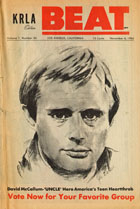
While the KRLA Beat was primarily a booster for a radio station, the musical landscape was evolving to encompass television. Reporting on a different artistic medium was essential, even if only one current KRLA deejay (Casey Kasem) was involved with TV as host of "Shebang!"
This week's Beat from fifty years ago noted that ex-KRLA veteran Jimmy O'Neill's job as host of "Shindig" was in peril, if you could count on rumors swirling through the industry. Ratings were the root of the problem, the Beat explained, and "Shindig" was on the chopping block, to "Hullaballoo's" good fortune, which might be expanded back to an hour-long show.
Meanwhile the Beat revealed two new teen-oriented pop music shows that might debut in the near future: "TJ's," to be hosted by actor Sal Mineo, and "Way Out" with Joey Paige as host. Neither of those two options saw the light of day, it should be mentioned.
As if that weren't enough, Ramsay Lewis and his trio, who were riding high on their jazz crossover hit "The In Crowd," rethought the benefit of appearing on two other pop music TV shows, "Ninth Street West" (hosted by yet another ex-KRLA man, Sam Riddle) and "Hollywood A Go Go." Lewis, interviewed by the Beat, made it clear he appreciated teenagers who bought the record, but wanted to remain loyal to older jazz fans who, presumably, would not watch a show "geared to teenagers." Not quite sure of the logic here....
It's remarkable to think that a mere three years earlier the only nationally televised teenage pop music show you could find was Dick Clark's "American Bandstand," and in Los Angeles the only regional such show was Lloyd Thaxton's dance oriented broadcast on KCOP channel 13. By 1965 the TV market had exploded in its attempts to garner teen attention. Ramsay Lewis could have found some benefit therein...or maybe managed to convert a few more fans to his style of music. But what's past is past.
Old news is still good news! Click the image above to read the November 6, 1965 issue of the KRLA Beat.
Is British better?
10.30.15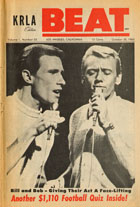
The October 30th, 1965 issue of the KRLA Beat had another international reporter at large. This week fifty years ago it was Sharon Richardson, reporting from England.
One of the striking differences between the U.S. and England was radio. At this point in history the BBC, England's official radio service, restricted rock and roll to just an hour or so out of the broadcast day.
Hence the popularity of continental stations such as Radio Luxemburg, which devoted hours to pop and rock and roll music and stole listeners from Auntie Beeb. It was Radio Luxemburg, in fact, where George Harrison first heard the Beatles' first released single, "Love Me Do," on the airwaves in October 1962.
The BBC's intransigence also inspired another pop music service, Radio Caroline, stationed on a decommissioned battleship three miles off the coast of England. Thus sidestepping British broadcasting regulations, Radio Caroline was free to present rock and roll for as many hours of the day as they wanted from "international" waters.
Ms. Richardson also gives us the lowdown on British pop music TV, Carnaby Street shopping, the London stage (where Jeremy Clyde, Chad Stuart's musical pal, was starring in a musical comedy at the Prince of Wales Theatre in Picadilly Circus). There's also a review of Liverpool and the Cavern Club as a bonus. It's almost a travelogue.
Read all about it (and much more pop music news) by clicking on the image above.
Top of the pops
10.23.15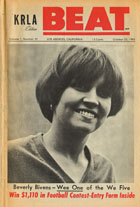
Now that rock music has been mainstream for more than fifty years, it's still hard to conceive that there was a time when it wasn't. Trade publications like Billboard were grudging in their admission that rock had in any way contributed to the popular music landscape. But it unmistakably had done so.
This week's KRLA Beat took the bull by the horns and issued its own proclamation. The Beat would take votes in the first of its kind poll: the International Pop Music Awards.
The Beat envisioned this process as a parallel track to the Oscars or the Emmys, which respectively paid tribute to the film and television industry. Why not offer a way for pop music fans to vote for their favorite music artists? Hey, it's a start!
This issue offers a rare look at The Rolling Stones on tour in Germany. KRLA Beat reporter Sharon Held happened to be in transit from Paris to Munich and caught the Stones backstage, where---no doubt impressed to see a Beat reporter in Germany---the group gave her a candid 20-minute interview about playing to German audiences. Clearly German rock fans were still appreciative of British groups!
Read all about it (and more) by clicking on the image above.
Changing of the guard
10.16.15
The most interesting news from this issue may have nothing to do with pop music, or whether Elvis Presley was still relevant, or why protest songs existed and why we should care what The Lettermen thought about them.
Derek Taylor was no longer managing editor of the KRLA Beat. That baton was passed over to one John Tynan, whose only association with KRLA appears to have been via this fast-growing and ever influential weekly newspaper.
What's the deal? Impossible to say. Cecil Tuck, KRLA's news director, was still listed as the publisher of The Beat. Perhaps there was some chit-chat in Southern California about The Byrds' press officer, Derek Taylor, also acting as editor for the paper that covered The Byrds in such meticulous and laudatory detail -- as on page 4 of this particular issue.
Maybe that was considered a conflict of interest. Of course Derek continued to write pieces for the KRLA Beat, both news and opinion items, for the next several years, but he'd be uncredited henceforward.
With the October 16, 1965 issue of The Beat you also get all the latest news, from Pete Best suing the Beatles for various reasons, a short biography of Dave Hull, a photo from Bob Eubanks' pre-"Newlywed Game" foray into TV, "Hit Or Miss," and a sob story about The Becket Quintet, who came to Hollywood with musical dreams and encountered big disappointments...initially.
Actually the Becket Quintet started getting some real work in gigs around L.A. shortly after the Beat article appeared in print -- even opening for Bob Dylan at the nightclub The Trip one night, so it was said. Read more about their brief but hopeful career here.
And to read the Beat from cover to cover for all that newsworthy goodness from fifty years ago, just click on the image above.
"Nothing's happening in England"
10.09.15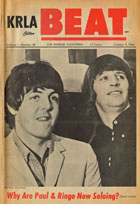
Peter Noone might have wanted to keep his opinions to himself -- but he didn't. Thus the curious interview about his experience with Herman's Hermits in the UK, where it was possibly true that nothing much was happening with his band...certainly not the fame he encountered in the United States.
But it's a bit of hyperbole to trash the entire music scene there, particularly when one of the newest British bands was hyped in a full-page article in this issue of the KRLA Beat. Oh, and about those Byrds, Mr. Noone....
On page 3 The Yardbirds are profiled, and The Beat gets an exclusive listen to their sound courtesy of a private concert at producer Kim Fowley's "pad" in the Hollywood Hills. Beat reporter Louise Criscione talked at length with the band members and their then-manager Giorgio Gomelsky about the group's music and influences. They admitted that their fans weren't entirely happy with former bandmate Eric Clapton's departure from the group, whose adherence to strict R&B was eventually the deal-breaker. It was the best move for everyone, I think it's safe to say.
Moody and magnificent: page 15 of this week's Beat included a photo of The Girls, who were in their third incarnation of musical reinvention. They started out with a kind of Patience & Prudence sound as The Sandoval Sisters, then had moved to a more standard girl group approach as The Moon Maids. As The Girls, Margaret, Sylvia, Diane, and Rosemary Sandoval launched their leatherette phase, wrote some of their own songs, and did some notable touring in the mid-1960s. In fact they're still making music today.
Read this week's KRLA Beat by clicking on the image above.
The ups and downs of rock and roll
10.02.15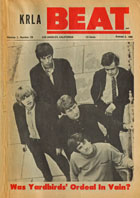
Not sure whether it was Derek Taylor's well-entrenched British connections or something about reporter Louise Criscione's smooth professionalism, but somehow the KRLA Beat was allowed to sit in on a Rolling Stones recording session. And lucky readers of the Beat got to go along, virtually speaking.
The sessions were held at RCA Studio B in Hollywood, a site much appreciated by rhythm-n-blues artists the world over. The Stones had recorded "Satisfaction" here earlier in the year. This time on September 5 and 6 they were working on "Get Off My Cloud," which would be another worldwide hit for the group, as well as "The Singer Not The Song," "Talkin' About You," and "Blue Turns to Grey" among several other tunes.
Interesting review of the Hollywood Bowl Bob Dylan concert on page 7. Shirley Poston was the reporter for this one, and it wasn't at all like other pop concerts that had been booked at the Bowl. And why would it be? No opening act, no encores, just straight Bob with the first half an acoustic set, the second half with a backing band...not too well rehearsed, according to Ms. Poston. But perhaps recognizing that Dylan wasn't your average entertainer, she finds nice things to say. "It felt like more" was her puzzled conclusion.
On the other hand, some willing British musicians couldn't get a break. For what seems like the billionth time the KRLA Beat addresses the whims of the Musicians Union, who cavalierly turned up their noses at The Yardbirds, who were in town for appearances on American TV shows including "Shindig." For reasons unknown (and apparently for no reason at all) they were denied their permits to perform, tossed out of their hotel, and prevented from visiting Disneyland, which in those days had hairstyle restrictions. What's a rock group to do? Well, they happily accepted a visit to KRLA's studios at 1401 South Oak Knoll, Pasadena, the Beat got a nice cover page out of the debacle, and Derek Taylor (anonymously) got his reportorial ire into high gear for the editorial on page 2. That's tellin' 'em, Derek!
At least there's something good amidst all the news of prejudice, protests, and Musicians Union pomposity. You can tell that good times are coming to the KRLA Beat advertising office...just look at all those ads! It's a further sign of the newspaper's ascendancy into further success.
See what the rock and roll music world was like fifty years ago by clicking on the image above.
Ming Toy Ginsburg?
9.25.15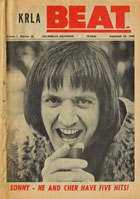
Fifty years ago this week the KRLA Beat published an in-depth interview with Robert Vaughan, who was then riding high as the co-star with David McCallum in television's "The Man From U.N.C.L.E." With spy shows much in vogue that year ("I Spy" was a similar TV hit), Vaughan wastes no time laying out his non-dramatic accomplishments, which were not few.
Already possessing a B.A. and an M.A. degree from Cal State Los Angeles, he was also pursuing a PhD in Communications from no less than USC, he revealed. Vaughan admitted to harboring potential ambitions in politics as well, though was unwilling to confirm whether his eventual goal was the presidency.
He did make one joke at the end of the interview, which appears to have flown straight over the reporter's head: Vaughan claimed that Ming Toy Ginsburg was his favorite entertainer of all time.
By the 1960s this tired old joke was likely out of fashion, but it was riding high in the 1940s and 1950s. A 1950 issue of the "The H-SU Brand," the student newspaper of Hardin-Simmons University in Abilene, Texas included the joke in its column "Bunkhouse Bunk," if you're really curious. And if you're intent on pursuing it, here's the link. Don't say I didn't warn you.
In musical news there's an excellent interview with Brenda Holloway on page 6 of this week's issue. Miss Holloway's haunting hit "Every Little Bit Hurts" so impressed The Beatles that they chose her to accompany them on their 1965 North American tour as part of their opening act. She talks with some candor about traveling with the Fabs and their entourage and how much fun it was.
Just below the article on Brenda is a short advertisement looking for talent of all sorts: singers, songwriters, groups. "Everyone will be given an opportunity." Folks, Johnny Otis wants you, give him a phone call!
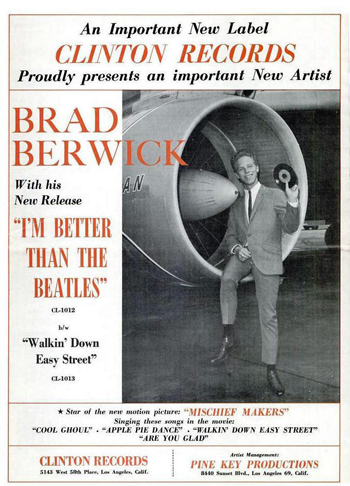
Speaking of the Fabs, note Louise Criscione's article on page 7 detailing the ins and outs of a Beatles press conference. The accompanying photo would have been taken on the day of the lads' late August arrival in Los Angeles prior to their 1965 Hollywood Bowl. John is wearing his iconic "Rubber Soul" jacket, which must have been a favorite sartorial choice at the time.
Advertisements are a fun part of this issue. On page 9 is a cryptic box that simple says "The Mothers." Of course we know now who this group was, but in September 1965 they were content merely to sow the seeds of confusion.
And on page 11 is an ad for Brad Berwick, who threatened to answer the protestors with a little ditty on Deem Records called "God, County, and My Baby" backed with "Are You Glad." "Brad's proud of his country, he sings about it!" Brad's other 1965 release was "I'm Better Than the Beatles," which you really don't want to hear. Because, not surprisingly, he wasn't better. But it's good to dream big, I guess.
Read this week's issue of the KRLA Beat by clicking on the cover.
On the cover of the KRLA Beat
9.18.15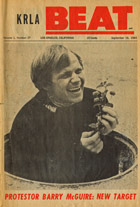
You knew that this was coming.
With McGuinn and McGuire just a' catching fire (apologies to the Mamas & the Papas), one of them was bound to be on the cover. Barry McGuire found his moment to shine forth on the front page of the September 18, 1965 issue of the KRLA Beat.
But that's not all. This week's issue includes the debut of a series written by the 24-year-old manager of the Cavern Club in Liverpool. Rob McGrae's "Liverpuddles" column would occasionally report on the Merseybeat scene back in Liverpool.
This week he showcases The Clayton Squares, a group that failed to catch on in the States but had released a couple of creditable singles in the UK. Bob Wooler, Cavern Club deejay, was their manager at first, later giving way to Don Arden, but they couldn't find the forumla for a hit record.
McGrae's confidence in their talent was not misplaced, however. The Clayton Squares actually opened for Cream on one of that band's first live gigs, and during one memorable week The Clayton Squares shared a stage at the Marquee Club in London with The Move, The Action, The Art Woods, and a group called David Bowie and the Buzz. Curious for more? Here's an online interview with their lead singer Denny Alexander.
In other news, back in August veteran KRLA Beat photographer Chuck Boyd captured exclusive photos of a swanky upscale party, thrown by Capitol Records head Alan Livingston, published in the September 18 Beat. Three of the four Beatles attended, with George Harrison sneaking off to sit in on a recording session with The Byrds. Later the Byrds were invited to the Fab's exclusive Benedict Canyon rental for some music and relaxation. The two groups' mutual admiration society was in full bloom.
If you were an admirer of the "For Girls Only" column for its swingy prose and Beatles references, you'll notice that there's a new byline this week. Same author, but now she's called Shirley Poston, and in reality she was Janie Milstead, a veteran of teen magazines and a regular writer for the Beat. Explore the section "Beat Writers" at right for more about the author of the series "The Adventures of Robin Boyd," which would later become a series in the Beat.
Page 9 includes an advertisement for a new club "for Young Adults 15 years of age and over." It's Boss, located at 8443 Sunset Boulevard, had been Ciro's in the 1940s and 1950s, a favorite hangout for Humphrey Bogart among other film stars. It had been made over for teens who couldn't get into regular clubs where alcohol was served. The musical line-up looks pretty good! Today this is the site of The Comedy Store.
Click the link above to read this week's news-packed issue of the KRLA Beat!
Poet, performer, protester
9.11.15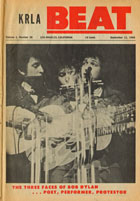
This week's KRLA Beat provided a distinctly proto-counterculture vibe with its coverage of the recent Hollywood Bowl appearance of Bob Dylan, and an in-depth look at "kooky clothes" worn by pop stars such as Sonny & Cher, Mick Jagger, Donovan, and others.
What the Beat was recognizing was the first flowering of sartorial splendor, very likely engendered in England from Carnaby Street tailors, which encouraged a domestic response in kind. Clothes for both men and women would become more colorful and texture-based, the better to encourage individualism. Matching suits would soon be left behind.
On page 12 the Beat further stoked the fires by carefully explaining what protest music was meant to do, more or less: make the world a better place. I'm not sure whether this editorial convinced any parents at the time, but I'll give it an "A" for effort.
There's plenty of other news too about The Kinks, James Brown, Joey Paige, The Animals, and The Seekers, among others.
Dive into the plethora of pop music coverage by clicking the image above.
The pounding of the drums
9.4.15
Despite the fact that The Beatles dominate the cover and first pages of this week's KRLA Beat, there's still much ado about Barry McGuire. His "Eve of Destruction" was still causing controversy but nonetheless it was racing up the Tunedex, this week at number 9, up from number 15 last week.
In an attempt to decipher the man behind the hit, this week's Beat provided an in-depth interview with McGuire written by Beat staff writer "Eden," a pseudonym for Nikki Wine, who later went on to become a producer for Casey Kasem's "American Top 40" radio show.
McGuire comes across as chatty, positive, even upbeat as he recounts his early career as a construction worker, then an accidental nightclub folkie, then a card-carrying member of the New Christy Minstrels. Not surprisingly he acknowledged his debt to songwriter P.F. Sloan, the nineteen year old whose words and music provided the platform for McGuire's indelible performance.
This week fifty years ago the Beat takes some care to review the latest developments with the second wave of British musicians. Dave Berry and his group The Cruisers had been making waves in Sheffield, England since 1963, and he had a string of hits in England and the Continent throughout the mid-sixties. He didn't chart in America for some reason, although he became known via Neil Jordan's haunting 1992 film "The Crying Game," which used Berry's British hit of the same name as a striking musical motif.
On page 8 the Beat introduces us to The Yardbirds, whose "Heart Full of Soul" was lodged comfortably on the Tunedex at number 25. On page 11 and 12 is a two-page spread on the phenomenon of women in pop music. Give them credit for the acknowledgement at least. There wasn't enough time or space to devote to the status of women entertainers on the charts, let alone the contributions they'd made to popular tunes since the beginning of recorded music, but it was a starting point.
Read the details of this week's KRLA Beat by clicking the image above.
It's the same old place
8.28.15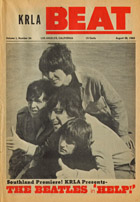
Any record that debuts at number 15 on the Tunedex had something special going for it. That was certainly the case with "Eve of Destruction," the P.F. Sloan song sung with such righteous fervor by former New Christy Minstrels member Barry McGuire.
But the song was already ruffling feathers in some music markets where it was banned outright for it's accusatory lyrics. KRLA editorialized that they had no intention of censoring music, so as a result the song was the subject of several more articles to come in the KRLA Beat. Sad to say...the lyrics still rings true fifty years on. Progress comes in fits and starts, and we still have a long way to go to fix the world that "Eve of Destruction" so vividly describes.
There was plenty of Beatles news too, with their second movie "Help!" just released to cinemas and the band's imminent arrival for their second Hollywood Bowl concert on August 29th and 30th that year. There's also an in-depth interview with The Turtles, just then enjoying their first success. And on page 6 that great West Texan philosopher, Bobby Fuller, reveals that he thinks "the English trend" of music was on its way out. Still waiting for that to happen....
If you're a fan of the original TV series "The Man From U.N.C.L.E." you'll enjoy the interview on page 8 with David McCallum. There's also the debut of a new column, Surf Beat, on page 12. Catch a wave!
As usual, the Tunedex was full of golden music with its mix of English and American talents, plus photos of all the KRLA deejays for your viewing pleasure.
Read the August 28, 1965 by clicking on the KRLA Beat for this week fifty years ago.
That's where it's at
8.21.15
Quick, before it disappears -- turn to the KRLA Beat Tunedex on page 16 to see the fleeting proof that The T-Bones' first single, "That's Where It's At," was actually released.
There it is in its debut at number 40 on the chart. It failed to chart the previous week and would be pulled rapidly when KRLA realized that it would make a jolly good foundation for a new series of radio jingles. KRLA wanted a new sound to represent its ascendancy into the number-one-station status. Here's the solution, and it was a catchy one at that. This instrumental seemed to epitomize the up-beat, the forward-looking music that signaled the change of an era.
The T-Bones themselves were little more than a studio band, made up of some of the members of the popular session musicians known as The Wrecking Crew. Released on Liberty Records and written by Stan Hoffman, the song was more a tribute to the big-band brass sound of the past, but its pervasive drumming and solid beat made it a compelling, rocking tune.
Today it's hard to find a used single of the record, so thorough was the effort to remove it from distribution. But you can hear it here.
The rest of the Tunedex looks pretty good too, from Bob Dylan's "Like a Rolling Stone" at number one, with the Turtles, Rolling Stones, Sonny & Cher, James Brown, Mel Carter, the Four Tops rounding out the list. Plenty of news items to enjoy too.
To read the August 21, 1965, just click the image above.
Busy nights at the Hollywood Bowl
8.14.15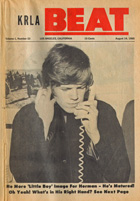
Bob Eubanks and KRLA doubled their concert credibility with the announcement in this week's KRLA Beat that two major Hollywood Bowl concerts were coming up. We all know about The Beatles' two nights on August 29 and 30, 1965. But now the word was out: Bob Dylan would be headlining a concert on September 3, 1965.
You'll also read Louise Criscione's third installment on The Rolling Stones' career, plus a look at The Turtles, whose first record was a cover of Dylan's "It Ain't Me, Babe." We note wistfully that none of The Turtles had yet turned 21 years old. But they sure didn't sing like teenagers. Their angst-filled delivery was suitably framed by Dylan's snarling lyrics.
This week fifty years ago was notable for the ascendancy of the latest East Los Angeles band, Thee Midnighters, whose "Whittier Blvd." had already conquered Southern California and was now making inroads on the national charts. They were fortunate to have a couple of powerful local deejays on their side too: Dick "Huggy Boy" Hugg from KTYM-AM and Casey Kasem himself from KRLA. Kasem, who frequently hosted bands in and around Southern California, called Thee Midnighters one of the best dance groups he'd ever hired. That's really saying something!
So, does anyone think the page 1 article on Sonny Bono is just a tad full of hyperbole? Getting thrown out of a restaurant for wearing the wrong clothes had to be old hat (no pun intended) by now. Calm down, Sonny, calm down...go write a song about it.
Clicking the image above to read about the goings-on in the KRLA Beat on August 14, 1965.
Revolution in the air
8.07.15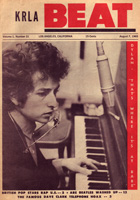
The fellow on the cover of this week's KRLA Beat was finally making waves beyond the shores of folk music. The Beat makes it plain: he was the bridge between folk and rock. Of course it required talent in other quarters as well. Part of Dylan's appeal was enmeshed in the catchy arrangements and re-workings of his tunes as sung by The Byrds, The Turtles, and Sonny & Cher. Now it was Bob himself who was poised on the edge of a number one record with "Like A Rolling Stone." At the time it truly felt like a new great musical force had arrived.
Beatlemania...dying? The article on page 12 addresses the fact that their concerts were not universally selling out as they had in 1964, but that was hardly proof of the group's demise. In fact record and album sales proved quite the opposite. But listenership was beginning to mature, a phenomenon not entirely visible to the world in August 1965. In the studio around this time the Fabs were working on the LP that would become "Rubber Soul," a release that would take their music to new heights. Pop music was evolving.
And if any proof was needed that the Beat was reaching beyond its teenage target, the Mail Box on page 9 gives us the scoop. Thomas Vincent Quiroz, at the ancient age of 24, admits that he's a regular reader of the newspaper. It was true that no other publication was writing about rock and roll music this seriously, "intelligently and without sensationalism," as he puts it. The Beat was unique in that way.
Read the August 7, 1965 issue by clicking the image above.
The roots of rock-and-roll
7.31.15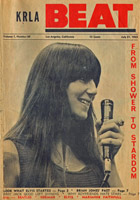
One of the things that distinguishes this week's KRLA Beat, published fifty years ago today, was its page 3 article on the growth of the music that KRLA had played since September 1959, and even then as a large market radio station they were late to the party. Check out Jerry Naylor's history of rock-and-roll.
Jerry Naylor began his broadcast career in San Angelo, Texas on radio station KPEP. Naylor was all of fourteen years old. KPEP was co-owned by Joe Treadway and Dave Stone, who also co-owned KDAV in Lubbock, Texas where Buddy Holly and the Crickets often performed live on the air.
Naylor's baptism in the pure waters of rock-and-roll and rockabilly couldn't have been more intense. In 1961 he was actually offered the position of lead singer in The Crickets, Buddy having died tragically in the infamous plane crash of two years earlier. It was this version of The Crickets that had a 1963 hit with "Don't Ever Change," a song that inspired the Beatles that same year to add it to their live radio broadcasts in England. Such polite boys! They even sent a thank you to The Crickets, as shown in Jerry's article.
So far as I know the chart on page 4 of the Beat was the first-ever attempt to plot a genealogy of rock-and-roll, tracing its rhythm-n-blues roots as well as its ancestors in country-western and rockablly. It's an impressive attempt for 1965.
The July 31, 1965 issue has sentimental roots for me as well. My allowance was twenty-five cents a week back then, just enough to afford a comic book, a sour dill pickle, and a bottle of Dr. Pepper at the deli in Pomona where we shopped every Friday night.
Out of the blue my father came over with a newspaper he found on the magazine rack. "Would this interest you?" he asked, and viewing my astonishment (I hadn't seen an issue before) he bought it for me. It was no secret to anyone who knew me then that I was a KRLA fanatic, but I thought it had escaped the notice of my parents.
The following week my allowance was mysteriously increased to fifty cents, the better to afford each weekly issue myself. And from then on, each week, I bought a copy of the KRLA Beat without fail.
And now it's all this! Thanks, Dad.
Read the entire issue of this ultra-special KRLA Beat by clicking the image above.
The big Beat
7.24.15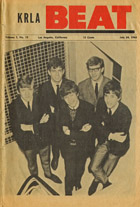
KRLA Beat Publications took a little time off to restructure its newspaper. And it was worth the wait.
The Beat fifty years ago this week increased its size to sixteen pages. They also added talent to their editorial staff. This week, in addition to the regulars, we see some new names: Jean Watson, Michelle Straubing, and Susan Wylie. They join Louise Criscione, Sheila Davis, Dave Hull, and Derek Taylor in this issue.
This week's Beat scores a nice interview with The Kinks, who had been in town the month before. Drummer Mick Avory revealed his love of jazz by revealing his evening sojourn to Shelley's Manhole, at that time one of the better-known jazz clubs in the Southland. Not surprisingly, Mick paid particular attention to the drummers.
Of course all this extra copy came with a price, an increase to fifteen cents. Still a bargain at the time, and a subscription was even cheaper. One year's worth of the paper was $3.00, two years $5.00. You can't beat that with a stick.
Enjoy this week's issue of the KRLA Beat by clicking the image above.
The little fight that wasn't there
7.07.15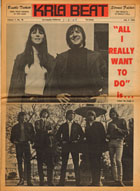
The big page 2 news this week fifty years ago was all about a disagreement between two record labels. In a colossal show of marketing ignorance, Imperial Records (for whom Sonny & Cher recorded) and Columbia Records (who had The Byrds) were convinced that these two groups couldn't release the same song, "All I Really Want To Do," at the same time. Perhaps the marketing men thought that record buyers would be confused, or that one song would cancel the other out, or that music listeners themselves couldn't find enough room in their hearts (or money in their pockets) for two versions of the same song.
Clearly the artists were in agreement. These were different approaches to the same Bob Dylan tune, and there was plenty of room on the Tunedex and elsewhere for both. But just to be nice, The Byrds agreed to let radio stations turn to the B-side of their hit and play that one too. As a result, their unexpected next hit was the scintillating "Feel A Whole Lot Better." And the pop music world was at peace.
In addition to articles about Herman's Hermits, Ian Whitcomb, and the Dave Clark Five, the July 7, 1965 issue of the KRLA Beat includes what might be the first mention, at least in an American pop-music-newspaper (of which there was only one anyway), of the songwriter behind this week's double release. Read all about Bob Dylan on page 11...at least as he was in those more innocent days of mid-summer 1965.
Sharp-eyed readers will note the tiny advertisement on page 5 for The Rising Sons. This five-piece Los Angeles band included several musicians who would go on to make their name in upcoming years, including Taj Mahal, who went on to become a solo blues artist, Ry Cooder of session-guitar fame, and Ed Cassidy, who would later form the band Spirit.
Then, as now, July 7 was and still is the birthday of Ringo Starr. We wish him the best!
Read this week's issue of the KRLA Beat by clicking the linked image above.
That didn't take long
6.30.15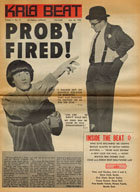
Last week's KRLA Beat was giving valuable space to P.J. Proby and his imagined trajectory toward Stateside stardom.
But a week later, the love affair was over.
A kerfuffle between Proby and "Shindig!" producer Jack Good resulted in the firing of P.J., whose misunderstood nose was seriously out of joint. Proby claimed that he'd been promised superstar status on the show. Good countered with claims of Proby's unprofessionalism, resulting in Proby being fired from "Shindig!" altogether. I wonder how their mutual lawyers made out in this musical argy-bargy?
In more pleasant news, take a look at the Tunedex! "Satisfaction" is at the top at number one this week, with the Four Tops on deck with "I Can't Help Myself." The Byrds' "Mr. Tambourine Man" is still at a healthy number 12 position, Sonny & Cher had two hits in the Tunedex, and Bobby Fuller just charted with his latest release, the haunting and irresistible "Let Her Dance."
Music was what it was really all about -- not the pontificating of pouty pop stars.
Clicking the image above to read all about the music world as it was fifty years ago this week.
P.J. Proby Shoppe
6.23.15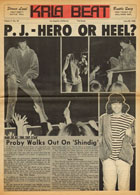
And fans of the Firesign Theater's live performance of "The Giant Rat of Sumatra" will know exactly how to pronounce that title, I have no doubt.
It's hard to imagine what inspired this week's KRLA Beat to involve its hard-working editorial staff in three (count 'em) articles about P.J. Proby. Proby's earlier career as a singer/entertainer (under the name Jett Powers) went nowhere in the early 1960s, despite the best efforts of singer-songwriters like Sharon Sheeley ("Poor Little Fool") and Jackie DeShannon, who introduced him to record producers in the industry.
After traveling to England in 1964 he gained some attention after appearing on The Beatles' television special "Around The Beatles" in 1964, but his chief claim to fame at the time was an energetic stage presence that regularly culminated in the "accidental" pants-splitting incidents alluded to by this week's Beat. Proby's only American chart activity was to occur two years into the future, with "Nicky Hoky" in 1967.
Meanwhile, in real news, Derek Taylor is justifiably elated at the growing popularity of The Byrds, a group of enviable talent who not so coincidentally were represented by Derek's talent agency -- a fact unmentioned in Derek's column. But who are we to complain?
For the first time in print, I think, we see an allusion to the phenomenon of "one-shot wonders." Today they're usually called one-hit wonders, but the syndrome is examined in some depth by Louise Criscione, who frets that perfectly talented folks such as Manfred Mann, Cilla Black, Millie Small, and Georgie Fame could not, for the life of them, manage a follow-up hit single to continue their early promise in the charts.
Not exactly one-hit wonders, any of them, but their successes weren't only measured in hit singles. Cilla, in fact, had a long and successful career in television. Manfred Mann was to enjoy considerable fame as a premier R&B British group in the album-oriented rock universe of the future. Georgie Fame went on to work with ex-Animals keyboardist Alan Price. And Millie Small might just be the best candidate to laud for the introduction of "bluebeat" into the pop music charts, the precursor of ska and reggae music.
Read the June 23, 1965 issue of the KRLA Beat by clicking on the image above.
Battle of the Beat
6.16.15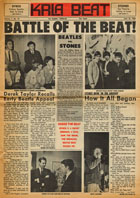
This week's KRLA Beat pits the two top stories about the two top bands side by side on the front page. And now that the Beat is twelve pages long there's more room for all the news (and more paid advertising) that's fit to print.
Derek Taylor continued his narrative of his first Beatles concert in May 1963 and how it changed his life, as it arguably did. And Rod Alan Barken interviewed the Rolling Stones when they were in Los Angeles, probing their musical origins and influences.
Derek Taylor also devoted some of his regular column to a review of the just-released American LP "Beatles VI," which to his ears reveals the influence of folk music as well as an affection for "hard rock 'n' roll." Interesting that this folk influence was noticed so early on. Usually "Rubber Soul" (again, in its American format) was seen as the Fabs' first foray into folk.
Louise Criscione took some time to cover KRLA's philanthropic side, detailing the various charitable causes supported by various 1110 Men. She notes that KRLA was then operating as a non-profit organization...and that's a clever way of turning around the FCC's decision that made this status a requirement. The radio license irregularities that had occurred in the dim days of 1960 caused the FCC to put KRLA on notice. Their non-profit status was not exactly voluntary...but what a great way to turn a negative situation into some positive publicity!
On page 12 the Beat now offered not merely its famous Tunedex but the British top ten too. It made for an interesting comparison to the Southern California record-buying trends.
Click the image above to read what they were saying in the KRLA Beat fifty years ago this week.
Move over, Beethoven
6.9.15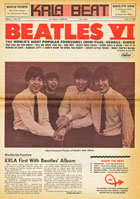
The KRLA Beat editorial for this week fifty years ago noted a new fact of musical life: mainstream publications like Time, Life, and Look were beginning to accept rock-and-roll as a permanent part of American culture. They didn't necessarily embrace it, but grudgingly they called attention to its permanence. Rock music was just a little more than ten years old in June 1965, but some facets of society still hoped it would go away!
A new color adorns the Beat with this issue: we're seeing red. The Beat's use of black and red ink brings it into step with British music newspapers such as The New Musical Express and Melody Maker and further emphasizes the Beat's professional look.
The June 9, 1965 issue is jam-packed with substantive articles. On page 1 is the story of how the American LP "Beatles VI" was debuted on the air in a world-wide KRLA exclusive via Dick Biondi's evening show. It's worth noting that when he was at WLS-AM in Chicago, Biondi was the first documented American deejay to play any Beatles song. The March 8, 1963 WLS chart showed a curious group called the Beatles with a number 32 song, "Please Please Me."
Not sure why Derek Taylor was fuming (page 3) over the failure of the Fabs' hit single "Ticket to Ride" to make it to number one. He claimed that even in the KRLA Tunedex it only reached number 4. Perhaps he missed the May 22, 1965 issue of Billboard "Hot 100" chart which clearly showed the song safely ensconced at number 1. No worries, Derek!
Derek also recalls the first time he ever saw a Beatles concert where they were topping the bill of what had started out as a British tour headlined by Roy Orbison. There's an informative on-the-scene look into filming "Help!" in Austria and England, a continuation from last week's issue.
And check out the interview on page 9 with The Byrds, possibly their first in-depth chat with a music reporter. David Crosby reveals a surprisingly eclectic musical taste, citing influences such as John Coltrane and Miles Davis as well as the Rolling Stones, the Beatles, and Manfred Mann. He also reveals his interest in an Indian musical instrument called a sitar as played by Ravi Shankar. That's certainly a surprise given the fact that "Help!"---with its own scene involving a sitar---had not yet been released. This might well be the first mention of Ravi Shankar by any pop musician. George Harrison's own involvement with Shankar and the sitar was yet to come.
Click the copy of the KRLA Beat above left to read all about it.
Mind the gap!
6.2.15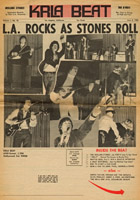
There are several meaty topics covered in the June 2, 1965 KRLA Beat, not the least of which is an on-site report by Derek Taylor's associate Tony Howard on how the cast and crew of "Help!" managed to get from London to Austria to the Bahamas. Where do you pack a 12-foot-tall statue of the imaginary multi-armed god Kaili? Tony Howard has the scoop.
You'll also enjoy the first-hand interview with the Rolling Stones by Rod Barken on page 4. Rod takes us behind the scenes at the recent Rolling Stones concert, hosted by KRLA at the Long Beach Auditorium.
Speaking of which, that concert inspired the first-ever KRLA Beat editorial, and someone's not very happy about crowd control (and behavior!) during the concert. In the ominous tones of the prose, I detect the mellifluous style of Derek Taylor himself, who must have witnessed similar scenes when he was with the Beatles on their initial travels through worldwide Beatlemania.
A debut this week: "For Girls Only," a column that someone must have thought was essential for the Beat's fashion-conscious readership. The alleged author is one Sheila Davis, who was later replaced (perhaps in name only) by one Shirley Poston. Were the two one in the same? Only Janey Milstead can tell us for sure.
Due to an overenthusiastic coupon clipper, we have a gap in the newsprint on pages 7 and 8, spoiling the Tunedex for all of us. Was that rip really necessary?
Click the image to read the KRLA Beat as it was fifty splendiferous years ago.
It works both ways
5.26.15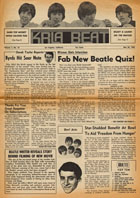
You'll note that this week's KRLA Beat has started referring to itself (not without merit) as "the nation's top newspaper for young Americans." Interesting choice of wording..."young Americans" covers a lot more ground than merely a teenage demographic. More evidence that KRLA saw its journalistic presence as a key to reaching a more widespread audience.
Also for the first time (see page 5) a full-page advertisement invites readers to become subscription representatives. Clever! It was a simple, nearly cost-free way to cast the readership net even wider, without incurring the expense of a circulation department.
Louise Criscione's article on page 4, "It Works Both Ways," brings up an issue that may have escaped the notice of music aficionados whose focus was entirely on the British Invasion: "No one, it seems, cares to discuss the fact that Americans have contributed heavily to the pop scene all over the world, and the British pop scene in particular."
It was certainly true -- Buddy Holly actually had more hit records, during his lifetime as well as posthumously, in the English charts than in American. And as Ian Whitcomb (interviewed on the same page) reveals, his influences included American rock-and-roll, jazz, and ragtime.
But it was an advantageous give-and-take. All kinds of American pop music, from jazz to Motown to surf instrumentals, enriched British music of the early 1960s. Packaged up in their own inimitable style, British artists gave their version back to us and caused a welcome sea change in the music we were listening to in 1965. Just take a look at the Tunedex (page 3) if you don't believe me.
Click the image above to read more about the music world as it was fifty years ago today.
Immigration blues
5.19.15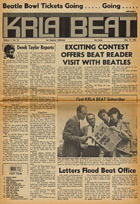
Both Derek Taylor and Louise Criscione let loose with their criticisms of the U.S./English immigration authorities in this week's issue. Both countries were at a stalemate over how often (and how many) artists from each country would be issued work visas to perform in England or America.
Stateside the issue settled on the shoulders of performer's unions, who had been saddled with the task of determining whether British artists had either sufficient merit or ability, or had unique talents that could not be duplicated by an American act. Considering that most bureaucrats were incapable of hearing, let alone deciding on, rock-and-roll's merits, this was a true nightmare for popular British acts of the time. If you were big enough (The Beatles, The Rolling Stones), no problem. But if you were someone up-and-coming...it would take some time before the immigration botheration was sorted out.
But on the positive side, this week's Beat fifty years ago today sported a brand-new, slightly trippy masthead as well as a photo of the first ever KRLA Beat subscriber, Rosie Hession of nearby San Marino, California. She's pictured on the front page with program director Mel Hall, deejay Dick Moreland, and Beat reporter Derek Taylor. With subscriptions still pouring in as the Beat went to press, KRLA's newspaper was on its way to expanding its Southern California readership.
To open a PDF copy of this week's issue, click the image above, and happy reading!
They'll be back
5.12.15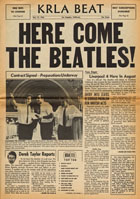
The KRLA Beat continues in this week's issue to fill each and every one of their eight pages with fresh music news and photos. Best news of all: KRLA had successfully beaten out a bevvy of contenders to host the Fabs in Los Angeles once again. Two new Beatles concerts were planned for late August, with ticket prices ranging from $2 to $7.
The Beat is also beginning to attract a few more advertisers, mainly for small dance clubs and cosmetics sweepstakes, but on page 6 is a three-quarter page advertisement for Suzuki, manufacturer of lightweight and affordable motor bikes. If that's out of your economic reach, there's the "Yeah-Yeah Whisk" advertised on page 5 to add a little kink to your dance moves.
Editorial expansiveness pushed Derek Taylor into overdrive, with his regular "Derek Taylor Reports" column as well as a review of the Beatles' first trip to Los Angeles during August 1964, when Derek was still on board as their press officer. He explains that George Harrison, despite general perception, didn't throw a drink at a Herald-Examiner press photographer that night at the Whisky-A-Go-Go, just tossed a couple of ice cubes from a glass at him. Glad to have that cleared up!
In more Derek verbiage, page 8 carries what is probably the first ever print reference to Larry "Wild Man" Fischer, who eventually came to the attention of Frank Zappa and the crew at Rhino Records as what's politely termed an "outsider musician." Score another point for the KRLA Beat.
To read this week's KRLA Beat, just click the image above.
Eight pages a week
5.5.15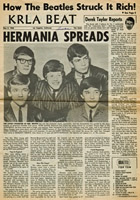
The business side of the KRLA Beat must have been going well by this time fifty years ago. Beginning with the May 5, 1965 issue the little-newspaper-that-could went from four to eight pages.
That meant twice as much Derek Taylor, under his own monicker as well as various uncredited articles. Note the insider's view of a Beatles recording session on page five. The session took place in October 1964, when Derek was not yet a part of the KRLA Beat, yet it paints a vivid portrait of recording "I Feel Fine/She's A Woman."
Beatles fans take note: here's a clue for you all. Who really produced that feedback tone from John Lennon's Gibson J160e? John always claimed to have been the first to incorporate that famous musical note, yet here Derek Taylor gives partial credit to Paul McCartney, who "stepped between two pieces of equipment to produce a weird twanging sound."
In addition to Derek, Louise Criscione, and various uncredited reports there's an article by one Rod Alan Barken. His review of the career of Phil Spector signaled the KRLA Beat's growing interest in exploring rock and roll music's history during an era when others had yet to recognize it as an artform. Barken had a connection to what was at that time the only FM radio station in the Los Angeles area playing rock and roll. KLFM was located near Signal Hill in Long Beach and its transmitter was situated in an old Airstream trailer. It wasn't widely heard in the region due to low signal strength and a dearth of FM receivers in the average household, but it made its mark in Southern California radio history.
Also notable for this issue: one of the first mentions of The Pretty Things (who never managed a hit record in America), The Who (who did have some chart hits), and the elusive former drummer for the Beatles, Pete Best.
Click the image above to read this week's KRLA Beat.
Folk music by any other name
4.28.15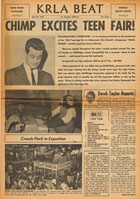
If you referred to American folk music in 1944, according to Billboard's 1944 Music Year Book (page 353), you were talking about music produced by "plain folk of the grass-roots." They meant artists like Gene Autry, the Hoosier Hot Shots, Bob Willis, Louise Massey, Denver Darling, Roy Acuff, and Montana Slim -- by other people also referred to as cowboy music, what we'd call Country-Western today. Billboard marveled that such music was as popular in some circles as big band and swing.
Almost twenty years later in January 1963 Billboard was congratulating the folk music industry for its most successful year ever during 1962, when groups like The Kingston Trio, Peter Paul & Mary, and The New Christy Minstrels were enjoying chart hits at the top of the pops.
Fifty years ago this week the KRLA Beat was also debating the folk music question, noting in an article on page four that Brian Epstein was intrigued enough to sign a folk group, The Silkie, to his own management stable of stars. Meanwhile, the Beat mused, who was more authentically folk, Bob Dylan or "an 18-year-old boy-hermit from Glasgow"? That would be songwriter Donovan, who was criticized for sounding too much like Dylan.
Nowadays that criticism is hard to fathom. The two were distinct singers with different songwriting styles, and one could argue that both were at least as authentic as Peter Paul & Mary, who, despite their undeniable talent and verifiable folk roots, had been assembled by Albert Grossman for the very purpose of cashing in on the burgeoning sixties folk scene.
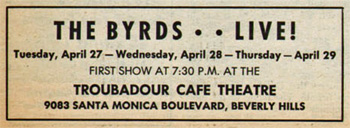
Speaking of which, The Byrds were making waves this week at the end of April 1965, with a high-profile gig at The Troubadour on Santa Monica Boulevard. Blending some of Dylan's own songs with their own Rickenbacker-flavored instrumentation would open a new path of mutual influence among musicians on the scene, reaching Dylan as well as The Beatles themselves. Rock and roll was about to encounter a folk-rock renaissance.
Yes, there are also stories about the Fabs and the Stones. The Beat never neglected news-gathering. To read this week's issue, click the image of the KRLA Beat above left.
And in other news....
4.21.15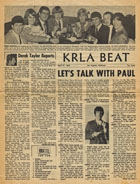
There was quite a lot of non-Beatles news in the KRLA Beat issue that was published fifty years ago today. For the first time The Yardbirds and The Byrds were mentioned, neither of which had made any inroads into the American music charts. The Yardbirds had appeared on stage with the Beatles as recently as December 1964 (with Eric Clapton as lead guitarist) but had yet to release a record in America.
The Byrds, on the other hand, were poised for a breakthrough---and as one of Derek Taylor's most recently signed bands, they were in good hands promotion-wise. Their first hit, "Mr Tambourine Man" (a cover of the Bob Dylan song), wasn't to be released for another two months, but Derek refers to it in this issue. It would be their biggest chart hit.
For those of you following the exclusive KRLA Beatles interviews, this issue concludes the series with a transcription of Paul speaking to both Derek Taylor and Dave Hull. Paul was still out of sorts with Dave, who had intemperately (if loyally) released the home addresses of the Beatles' parents to KRLA fans. Perhaps not the most perspicacious move on Dave's part, even if he'd meant it well.
Interesting to note that Louise Criscione's "On The Beat" column referred to the English experience of "pirate" stations such as Radio Caroline, whose off-shore studios were located aboard rickety old ships, beyond the reach and regulations of official British broadcasting licensers. This article is a year old but it's worth reading about the trials and tribulations of launching a 24-hour-a-day rock and roll radio station, bringing non-stop pop music to an English audience in great need of such a service.
Click the image above to open up this week's issue.
John lets his hair down
4.14.15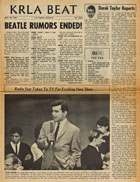
Being forthcoming with reporters wasn't really something John Lennon did. He was often misunderstood when joking, and just as often not taken seriously by superficial hacks who were still focused on the hair rather than the music. It was enough to drive a Beatle batty.
But Derek Taylor's and Dave Hull's separate interviews with John, still in the Bahamas filming what would be "Help!", bring out some sincere commentary on the life, both professional and private, that John then lived.
In his own column Derek Taylor mentioned this week how puzzling music charts could be. Case in point: in England the Beatles' first number one, "Please Please Me," appeared in two of the three music papers, whereas it only reached number two, according to Melody Maker. The same thing was happening to Herman's Hermits, whose latest single "Can't You Hear My Heartbeat" was either number one...or it wasn't, and The Supreme's were number one instead. As Derek suggested: take your pick!
Louise Criscione's "On The Beat" column mentioned a couple of exclusive Beatles tracks played on KRLA, "Cara [sic] Bella" and "Soldiers [sic] of Love," which she described as "pre-Epstein" from 1961. Actually these were recorded for BBC radio in 1963 and were more properly known as "Clarabella" and "Soldier of Love." Still a nice coup by Dave Hull to air them at all, rarities that no other American radio station had.
To open a PDF copy of this week's issue, click the image above, and happy reading!
Mostly George
4.7.15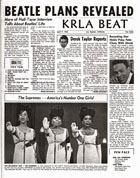
The predominant interview in this week's KRLA Beat was with George Harrison, on location in the Bahamas with the other Beatles filming "Help!". With Derek Taylor as one of the interviewers (along with disc jockey Dave Hull), George appears to be more forthcoming about his personal and professional life than he might have been with anyone else.
George's ramblings about recording, touring, and filming reveal just how busy the Beatles had been during early 1965---and would be all throughout the rest of the year. In addition to a brutal production schedule (up at 7:00am on set for filming), George mentioned that the foursome had spent the previous week recording eleven new songs, most of which were to be part of the "Help!" soundtrack. And the rest of their year appeared to be pretty hectic, if George was right about all the touring they had planned.
The new KRLA Beat format makes accessing the Tunedex so much nicer than dealing with mimeographed pages as in days of yore. In early 1965 a plethora of new British acts were making their way into the American charts, but as you'll see there's still plenty of room for domestic acts as well. This was a golden period for the flowering of musicians, both American and British, who had been influenced by the Beatles. The Tunedex---and our ears---were the beneficiaries.
Click the Beat to open the PDF copy of this week's issue.
News notes and more
3.31.15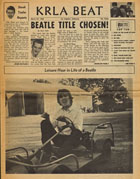
For the first time in the recently revamped KRLA Beat we see a new name: Louise Criscione, whose page three article "On The Beat" provides a roundup of American and British artists and their latest records.
An Angeleno born and bred, Criscione was eighteen when she started working for the Beat, becoming adept at interviews with the many bands who passed through Southern California. She was to stay with the newspaper pretty much up to the end of its run, rising from the position of reporter to managing editor in April 1967. Her interviews included The Rolling Stones, Dusty Springfield, The Turtles, the Association, and a passel of others too numerous to mention.
Her reporting was thoughtful and detailed, never devolving into the type of prose that teen magazines routinely offered. Her professional tone helped put musicians at their ease, and as a result singers were usually more candid with her than with other reporters. Women who wrote about rock and roll were rare in those days---about as rare as serious coverage of rock, at least in the United States. Criscione was a welcome addition to the Beat's (at this point) small roster of journalists.
This brief biography includes a list of some of her best-known interviews...and of course you can navigate to those issues in our archives.
This week's issue got one thing spectacularly wrong...but it wasn't Dave Hull's fault. The Beatles' second movie title was announced: "Eight Arms To Hold You." But of course it didn't stay around for very long, being jettisoned for "Help!" as soon as that song was written.
Click the image of the Beat above to read all about it.
Insider tales
3.24.15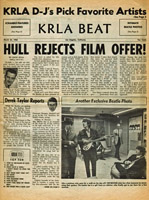
With the plethora of Beatles news in this week's issue, you might overlook a gem on page four. "KRLA News" reveals details of the seven newsmen hired by KRLA to produce hourly news shows and occasionally contributions to the Beat itself.
That's a fairly large news staff for a pop music station, but for the record there were no all-news radio outlets at the time. Most stations, whether middle-of-the-road, pop, jazz, or classical, had news crews. But for KRLA there was more than practicality involved in their investment in journalism.
Promoting newsworthiness was a good tactic for a station like KRLA, whose license renewal process was still on shaky ground. One way to rebuild its reputation was to be more responsive to the wider radio public---not merely to teenagers with money to burn on ninety-eight cent singles.
Public service was key, and a good news staff indicated to the FCC that a station was serious about providing public services to its listenership.
This could include news, documentaries, and studio debates on topics like politics, current, events, and religion. The more a station served its public, musically and non-musically, the better the FCC liked it. KRLA was on a roll, in print and on the air.
The March 24, 1965 issue of the Beat also has a nice interview with John Lennon, who for the first time expresses an interest in the business side of making records, entertaining the idea of becoming an A&R man himself. In a way, all the Beatles were moving toward that model of in-studio involvement as they became more comfortable with the recording process. This evolution would take a giant leap forward with "Rubber Soul," recorded later in 1965, and even more so in 1966 with "Revolver."
Click the image of the Beat above to read all about it.
Straight from the Bahamas to you
3.17.15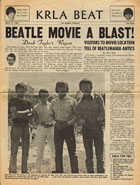
True to their word, the KRLA Beat provided two reviews of the Beatles filming "Help!" in Nassau, with one article by Derek Taylor and another by Dave Hull. There must have been nameless reporters on hand by this time, or perhaps publisher and KRLA newsman Cecil Tuck was generating copy. Certainly the prose style is loftier and more fact-based than in earlier editions. However, some typesetter needed lessons on how to spell "Emperor" and "Kasem"!
This week there's another article on one of the new bands fresh from Derek Taylor's publicity palace. The Beau Brummels, a San Francisco band, originally came to the attention of KYA's Bob Mitchell and Tom Donahue. What made them unique? They claimed to be the first American band to embrace the "English sound" of the British Invasion. Whether or not their soon-to-be-hit "Laugh, Laugh" was truly evocative of English groups is up for debate, but a catchy number it certainly was, showing up at number 28 on the KRLA Tunedex this week fifty years ago.
Click the copy of the KRLA Beat to open the PDF copy.
All Derek all the time
3.10.15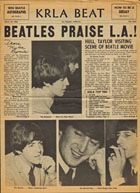
It was hard to miss Derek Taylor's presence in this week's KRLA Beat. He's the primary source of information for almost all this week's news stories.
The biggest one, of course, was a reporting coup: Derek Taylor and Dave Hull flew together to the Bahamas to interview the Beatles on the set of their second film, "Help!", which was then being filed in the Bahamas. Derek, of course, had a distinct advantage as former professional assistant to Brian Epstein. For all his enthusiasm about the Beatles, Dave Hull would never have had the ability to arrange interviews like these on his own. For a time, Derek took out ads in Billboard Magazine offering the taped Beatles interviews up for sale. A week later the tapes were suddenly (if not predictably) no longer available.
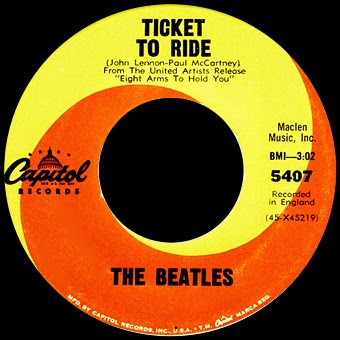
Interesting to note that at this point the second Beatles' film had no name. For awhile the title was "Eight Arms To Hold You," known early on to sharp-eyed fans who bought a single of "Ticket To Ride" and found it printed on the Capitol "swirl" label. Now you know where Veruca Salt got the title for her album.
At this point Derek is also using the KRLA Beat's considerable reach to publicize some of his own groups. As a Los Angeles publicity agent his stable of stars was small, but he'd already signed The Byrds and Paul Revere & the Raiders to contracts. Not so surprising is the page 2 article on the latter group, whose hits had been heretofore relegated to the Northwest.
Was this truly only the second newspaper-style edition of the KRLA Beat? Ordinarily the newspaper was published on a strict weekly basis, so after February 25, 1965 there should have been an issue out on March 3, 1965. No Beat with this publication date has ever turned up in collections or auctions, so for now we'll assume there was a two-week gap in the schedule prior to this week's issue. But if someone out there actually has a copy, we'd love to get a scan and share it with the world. Let us know, please!
Click the copy of the KRLA Beat to open the PDF copy.
Something new has been added
2.25.15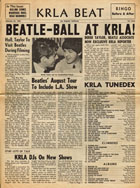
Now that's a newspaper! Fifty years ago today the Beat sported a new look.
Headlines, subheads, bylines, boxed teasers...it's the real deal for the KRLA Beat. With this February 25, 1965 issue the Beat made a new statement. Even the photos look better -- principally because they'd decided to use more professional photographers and official publicity shots where sharp camera work really stands out.
Another clue that the paper was getting serious: they're soliciting advertisers. That would be a lucrative source of income to help fund the Beat as it experienced its first real growing pains.
Check out Derek Taylor's premier column on page three of the Beat. It's the first local resource that would cover British music news in a style that Taylor knew intimately from his own journalism days in England. This new association with Bob Eubanks and KRLA would prove a fruitful one for all concerned.
Click the issue above to read it in PDF format.
The end of the begining
2.22.15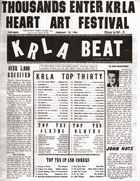
If you're the kind who looks for clues, this week's KRLA Beat offers a couple.
First is the publication date. Sharp-eyed readers will note that it had been ten days since the publication of the previous issue. Once a week (on Wednesdays) like clockwork was the usual tempo. This one showed up on a Saturday, February 22, 1965.
The other clue is the replacement of editor Bonnie Golden's name with a very prominent copyright notice, and a forceful statement that "Beat" and "KRLA Beat" are terms belonging solely to KRLA.
The truth was that Golden's fanzine era was over, and The Beat was about to debut a new look and format, one more in keeping with the vision that KRLA newsman---and now KRLA Beat publisher---Cecil Tuck had in mind. There would be a new staff, too, professional reporters whose stories would be focused on rock and roll news, building a type of entertainment journalism that simply didn't exist in the United States. You'd have to look at British examples like "Melody Maker" and "New Musical Express" to see where The Beat was going.
The KRLA Beat also had a "secret weapon" that would be revealed with the new format. He was an experienced journalist himself, he was British, and he had a special relationship with the biggest foursome of the era.
Meanwhile, enjoy this issue for its nice photo essay on deejay Dick Moreland, who was one of the biggest reasons that KRLA in those days had the best playlist on the airwaves.
Click the image above to read all about it.
"Our fine nine!"
2.12.15
That's how the KRLA Beat described their deejays in this week's photo display of the recent KRLA television special, hosted by Los Angeles' KCOP TV, Channel 13 on the dial. In this one issue you'll see more of KRLA's on-air staff than had ever been published before.
KRLA, the number two rock and roll station in town, was still struggling to push frontrunner KFWB out of its number one position, and there wouldn't be long to go.
This February 12, 1965 issue of the Beat also highlights the career of 27-year-old deejay Bob Eubanks, one of the station's most popular 1110 Men, whose foresight brought the Beatles to the Hollywood Bowl in August 1964. He had just finished negotiations with Brian Epstein to bring them back in August 1965, another feather in the cap.
At the end of the story you'll just catch a mention of a new venture, the establishment of Bob's own talent agency, with a very special associate indeed: Derek Taylor, former personal assistant to Brian Epstein. That would prove to be a pivotal hire, and it was to have some unexpected but positive consequences in the evolution of KRLA's newsletter during the coming weeks. Stay tuned!
To read the KRLA Beat just click the image above.
"Buy a record -- it's yours for keeps!"
2.5.15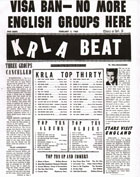
That slogan, apparently, was they key to saving the British record industry...which was really doing just fine in early 1965, better than ever, as a matter of fact. But record industry folks in the UK were whipping themselves into a frenzy over "a possible end to the pop music boom" based on no evidence whatsoever and decided to mount a campaign to encourage the public to buy more records.
This must have been the month for hyperbole. The February 5, 1965 issue of the KRLA Beat succumbed to an unrelated but no less hysterical fear over the temporary suspension of H1 visas, without which British acts couldn't travel to America to perform.
Of course if you're patient and read through to page 4, it's clear that this was a short-lived catastrophe. "Last minute flashes" suggested that the whole brouhaha would be of limited threat to the back-and-forth of British and American musicians visiting each other's shores. Glad that's cleared up!
Click the image above to read details of all this week's news.
To wit? To hoot!
1.28.15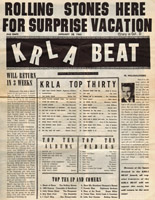
The music scene of early 1965 wasn't all rock and roll, although that's mostly what you heard on KRLA. At the end of 1963 the music industry was quite convinced that folk music would be the next big thing...and arguably it was big all the way through the 1960s, just not the predominant form of musical entertainment. There was a lot of musical evolution just about to erupt, and it would include a novel meld of both rock and folk.
A holdover from commercial folk presentations of the early decade was the hootenanny, an antique term that had originally referred to folk music jam sessions. Hootenannies were popular concert option on college campuses of the era, and KRLA was smart to organize one of their own. This issue of the KRLA Beat covers the "hoot" that was held on January 15, 1965. Co-hosted by Doug Weston of The Troubador, the well-known Los Angeles folk club, the event was likely held on the premises, although The Beat doesn't say specifically.
Groups and singers who appeared include The Womenfolk, a Pasadena-based group of all women folksingers who specialized in multi-part harmonies. The Dillards, an electric bluegrass band popular in concert venues as well as television, were a big hit. Hoyt Axton was an established folksinger and composer, a regular on ABC TV's weekly tribute to the medium, "Hootenanny," hosted by Jack Linkletter...and the son of Mae Boren Axton, whose composition "Heartbreak Hotel" would make a name for Elvis Presley and inspire some of the British musicians so beloved by the KRLA Beat.
This issue also includes the results of KRLA's first ever KRLA Beat music awards. See whether you can guess who came out on top.
Click the image above to read details of all this week's news.
Million dollar music
1.21.15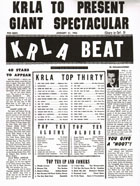
Whatever motivated KRLA to get into television?
Your guess is as good as mine. The only traces of this local TV show I can find are in the January 5, 1965 issue of Variety, the trade journal. While this week's KRLA Beat calls the show "KRLA Presents...Million Dollar Music!" Variety refers to it only as "D.J. Special," hosted by mainstream composer Henry Mancini, noting that all the deejays on the show would be working "for scale," i.e. very little money.
KCOP was the lowest-rated local TV outlet in L.A. but it wasn't averse to teenage viewers -- in fact, Lloyd Thaxton's immensely popular dance show, which began broadcasting in 1961, eventually went into national syndication because of its popularity on KCOP. Perhaps KRLA was hoping that this premiere broadcast would result in something similar for the station. Ex-KRLA Jimmy O'Neill was hosting the very popular "Shindig!" at the time, so the idea isn't too farfetched.
The January 23, 1965 issue of Billboard further elucidated the musical lineup. Those appearing live on the show were to be Jan & Dean, Duane Eddy, Freddie Cannon, and Dick Clark (who had his own rather famous "American Bandstand" on the air). All the other acts appeared via film clips.
It was a unique idea at this time to try to present an accurate history of rock and roll, which was still considered a slightly illegitimate form of music to industry types who were, ironically, making their own millions off of its sales. It couldn't have been a very accurate genealogy without the mention of folks like Buddy Holly, Big Joe Turner, or even Louis Jordan, but here was an impressive beginning. Later on, once the KRLA Beat was relaunched in its newspaper format, KRLA would explore again the idea the rock and roll had legitimate roots in a variety of music such as rhythm and blues, gospel, and rockabilly.
The January 21, 1965 issue of the KRLA Beat is clickable and readable at the touch of a mouse.
Blues for breakfast
1.14.15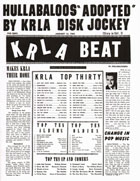
Fifty years ago this week's KRLA Beat (still only five cents!) was editorializing on the shifting interests of music fans. Rhythm and blues music was taking over...but honestly, hadn't R&B been the daily bread of many a KRLA fan for years?
You would've heard plenty of it in daily KRLA playlists from 1959 onward, from singers and groups like Arthur Alexander, Sam Cooke, Smokey Robinson & the Miracles, The Isley Brothers, Irma Thomas...groups the editorial writer seems to have forgotten when remembering the station's musical landscape "before Beatles."
I was there and I heard all those delicious R&B artists on KRLA. In fact, one of the more remarkable developments of the Beatles' sound was their own devotion to R&B, especially if the b-side of the record was the least bit obscure. Look how those influences are reflected in their set lists during appearances at venues like The Cavern, The Star Club in Hamburg, and radio shows all over England in 1962 and 1963.
The Beatles' first LP "Please Please Me" demonstrates just how devoted they were to cover versions of songs by some of the artists above, not to mention The Shirelles and The Donays. Of course there were some pretty blues-infused self-penned numbers too ("Love Me Do," I'm talkin' about you).
Meanwhile the music industry fifty years ago was somewhat confused whether KRLA even existed anymore. Billboard's January 16, 1965 issue reported on KRLA's ongoing and indeterminate license issues, referring to "the AM spot formerly occupied by KRLA." Yes, the station was under interim control by Oak Knoll Broadcasting and the vultures were lining up to purchase it if the FCC dissolved it entirely. But KRLA was busily pumping out hits and obscurities of all musical genres this week and every week, just as it had always done.
Feel free to peruse the January 14, 1965 issue of the KRLA Beat by clicking on the image above.
Ghostwriters in the sky
1.7.15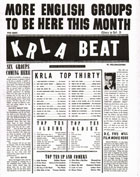
If there was ever any doubt that KRLA deejays weren't really writing their own columns in the KRLA Beat, this week's issue fifty years ago was pretty convincing. Of course Dave Hull's page one column has never reflected Dave's "literary" voice, if anyone out there was fortunate enough to correspond with him.
But there's no way on earth that Dick Moreland and Casey Kasem wrote their own columns in this issue. Overuse of exclamation marks was in high gear this week. That's a clear marker of fangirl prose...which wasn't doing much to increase the implied authority of the KRLA Beat. Don't despair, better things are in store in a few weeks, with forthcoming changes visible in print as well as in tone.
There is a notable upward evolution though. Readers can now subscribe to the Beat by sending in five cents plus a self-addressed pre-stamped envelope. That's the way to reach a wider readership.
January 1965 was big news for British groups. The Beat anticipated the arrival of The Kinks and The Animals in advance of their taped appearance on TV's "Shindig," and for the nostalgic, the Beat offers images from past issues in its centerfold.
Click the image to read the January 7, 1965 issue of The KRLA Beat.
Welcome to 1965
1.1.15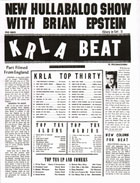
Pop music was moving forward fifty years ago and KRLA was doing its best to keep up with new releases, both in the United States and across the pond...where, says KRLA, Ireland would produce the next big musical phenomenon.
Hindsight tells us that this wasn't very close to the truth. Britain continued to provide most of the new sounds at the beginning of the new year. In this issue Bob Eubanks reviews several new releases, one of them an exclusive by the Rolling Stones, "Little Red Rooster." Their manager Andrew Loog Oldham didn't want them to release it, claiming it was "uncommercial" and "virtually undanceable," according to Stones bassist Bill Wyman. But the group recorded it anyway. In December 1964 it reached the top of the UK record charts, the only blues song to do so.
The song wasn't released in the U.S. until February 1965 when it was included on the American LP "The Rolling Stones Now!" so the version being played on KRLA must have been the UK single, procured somehow by wily KRLA deejays.
Bob Eubanks also liked The Kinks' newest release "All Day and All Of The Night," admiring its "rough blue sound."
The photo feature in this week's Beat highlights Dave Hull and Emperor Bob Hudson in the Hollywood Christmas Parade, as well as a recording session by KRLA deejay Reb Foster, a track neither named nor verified to have been actually released. Sonny Bono appears to have been involved in the production. If you look closely you'll see a photo of KRLA news director Cecil Tuck and his wife Gail, both of whom would be involved in the upcoming relaunch of the KRLA Beat as a professionally produced newspaper.
Click the image to read the January 1, 1965 issue of The KRLA Beat.
Something new has been added!
12.23.14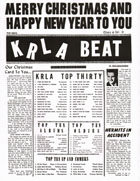
That's right, something new is in the KRLA Beat's masthead with this week's issue: a price tag.
The newsletter now costs five cents per issue...not bad when you consider the cost of production, printing, and distribution. Copies of the Tunedex were still free but henceforward you'll need to shell out a nickel a week for your copy of the Beat.
Another first this week: the Beat sports its first-ever print advertisement. It's nearly a full page advert for Vox amplifiers, the same models as the ones used by The Beatles, among other illustrious bands, both British and American.
The fact that Vox wanted to advertise in a newsletter that was little more than a weekly giveaway indicates that KRLA Beat readership was being promoted to advertisers as including music makers, not just music listeners. Just as American music of the nineteen-fifties had one sparked a wave of young Britishers to buy their first guitars in an attempt to emulate Elvis and Buddy Holly, the British Invasion did it in reverse. No less than Jim McGuinn admitted that his first thought, after exiting a heady screening of "A Hard Day's Night" in 1964, was that his group -- soon to be The Byrds -- had to become an electric band. Essential to this musical evolution was an amp, preferably one used by The Beatles themselves.
The Vox advert lists various music stores where Vox gear was available, and this too points to a much wider distribution than would have existed just a year earlier. From the greater Los Angeles Basin east to the Pomona Valley and as far as the Inland Empire, Vox was setting up shop in a wide variety of towns. Did KRLA's airwaves reach all over the Southland? As the number-one station in the Los Angeles market, KRLA could claim it...and advertisers were starting to pay attention.
The image above is clickable if you'd like to read the December 23, 1964 issue of The KRLA Beat.
The Beat goes backstage with the bands
12.9.14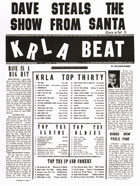
Don't you love alliteration?
The December 9, 1964 issue of the KRLA Beat featured a photo spread of two different concerts: backstage at the T.A.M.I. Show (which KRLA had no hand in producing) and backstage at an appearance by British group Manfred Mann (which KRLA engineered). Sharp-eyed readers will see a picture of Beat editor Bonnie Golden with Gerry & the Pacemakers.
There's also the inevitable "pose the musicians reading the KRLA Beat" picture showing members of Manfred Mann engrossed in its prose. The Beat maintained that the group were "amazed" at the newsletter: "Why don't we have something like this in England?" they wondered.
But of course they did -- three newspapers of note, Melody Maker, New Musical Express, and Record Mirror, which were launched in 1926 (!), 1952, and 1954 respectively. As rock-and-roll developed these newspapers shifted into high gear to cover singers, bands, record releases, and charts.
The U.S. had Billboard and Variety, of course, but those were music industry publications, not usually read by the general public. The KRLA Beat was indeed a groundbreaking news source even during it's newsletter-style days, but KRLA had bigger ambitions, and by February 1965 publisher Cecil Tuck would re-configure the Beat to resemble its British brethren. Something to look forward to in the new year!
You'll also notice KRLA deejay Gary Mack greeting Shindig host Jimmy O'Neill with a copy of the Beat. Jimmy was an original member of the Eleven Ten Men and the first voice of KRLA when it switched formats from country to rock-and-roll in September 1959. Wonder if it stirred up any memories for him?
The image is clickable if you'd like to peruse this issue and revisit the past as it was fifty years ago.
On his junkie float
12.2.14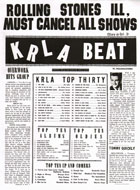
This issue fifty years ago was pretty much all about the Dave Clark Five, who were in town for yet another in a series of Bob Eubanks concerts. Also on the bill were The Vibrants, who were the house band at Bob's club The Cinnamon Cinder, The O'Jays, Round Robin, and Joey Paige, who always seemed to find more fame in England rather than the States.
The photo spread of the concert dominates, showing the DC5 in action and even reading (with apparent interest) the November 18, 1964 issue of the KRLA Beat, included in our archive. Also pictured this week is a rare view of KRLA newsman Jim Steck, who along with Dave Hull made a mad dash onto an airliner in August to gain an exclusive interview with the Beatles, then on tour and bound for Denver. That's where Dave and Jim ended up too, to their chagrin...ticketless. In that heady atmosphere they failed to disembark before departure. KRLA general manager John Barrett had to make it all good with the airline and eventually got them home safely.
In this issue on page one, Dave Hull makes some cryptic comment about fans sending him garbage for his "junkie float." Strange as it seems, it was a publicity stunt for the upcoming Hollywood Christmas Lane Parade, which would feature KRLA's own deejays riding various floats -- or in the case of Emperor Bob Hudson, a golden Rolls Royce that he'd commandeered from somewhere.
Dave's plan was the antithesis of grandeur. He had his float built from junk sent in by adoring fans. The Beat covers the parade later on in the month, so prepare to be dazzled.
Just the facts, ma'am
11.25.14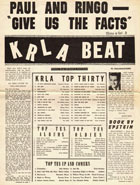
Other than the silly letter from some entitled Beatles fans who thought they owned the group, this was a nice issue of the Beat, published on November 25, 1964.
For the first time anywhere we get a backstage look at the KRLA studios where station deejays prepare, announce, and clown around for the cameras. Note a rare appearance of the Southland's only female disc jockey, Sie Holiday, who had a show on Sundays at KRLA.
Another rare glimpse includes KRLA newsmen Bill McMillan and Richard Beebe. Beebe was later an early member of The Credibility Gap and recorded fake commercials for KRLA, advertising non-existing products like Valhalla motor oil. If you remember mini-comedy skits by Emperor Bob Hundson's Commandos, Beebe was a member of that cast we well.
Also appropriate for the season: Thanksgiving wishes from the KRLA on-air personalities. Now you can enjoy your day of plenty on style!
Click the image above to read the November 25, 1964 issue of the Beat.
"Will you get Fabian away from me?"
11.18.14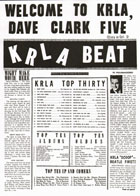
I'm not sure the impact of the British Invasion was fully understood at this point fifty years ago.
Or maybe, wary of their prior contests where the prize actually couldn't be won by anybody, the KRLA Beat promotional bandwagon was primed to serve up a non-controversial event.
Witness the "forward into the past" approach in the issue that KRLA published on November 18, 1964. The newsletter is chock-a-block with stories about the Dave Clark Five's performance at a KRLA-sponsored concert, KRLA's clever scoop by playing the Beatles new single "I Feel Fine" before (they claimed) any other radio station in the world, and photos of the recent Rolling Stones show...also sponsored by KRLA. Brits abound all over the airwaves and in person.
So whose idea was it to offer a dinner date with Fabian as a prize in their weekly contest? The American singer hadn't had a hit in more than four years and had transitioned to acting, appearing in minor roles in teen films and television. But better late than never, I suppose. KRLA wasn't likely to be able to offer a dinner date with Mick Jagger.
Click the image above to read the November 18, 1964 issue of the Beat.
Gathering no moss
11.11.14
The November 11, 1964 issue of the KRLA Beat was bursting at the seams with photos of the latest invasion, so much so that there wasn't room for all the news stories they'd promised a week ago. The Rolling Stones were the subject of two subsequent issues of the Beat. Brought to Long Beach by Bob Eubanks for a sold-out show, KRLA caught three of the Stones -- Mick, Keith, and Bill -- relaxing at the Roosevelt Hotel in Hollywood before the performance.
This issue also reported the upcoming and much-anticipated launch of deejay Reb Foster's singing career, on the cusp as he was of a recording session, with a voice (so claimed the writer) that was remarkably close to Reb's old friend Buddy Holly. For whatever reason the tracks remained unreleased but it made for a nice story and would have been a handy bookend to another deejay record, Casey Kasem's "Letter to Elaina."
This issue also contains the only reference I can find in the KRLA Beat to The T.A.M.I. show that was filmed earlier that month in Santa Monica. KRLA had nothing to do with that production but the Beat claimed that both Gerry & the Pacemakers and Billy J. Kramer had personally invited Reb to watch the taping of their performance at "their Electronovision filming."
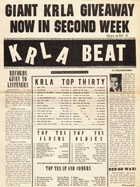
The term is the give-away. Electronovision or Electrovision (both terms appear to have been used) was a videotaping process created by H. William "Bill" Seargent, using videotape cameras of 800 lines of resolution at 25 frames per second, with tape then transferred to film for general distribution to cinemas. The result was a higher-quality image than film alone would usually present, and it made The T.A.M.I. Show performances unusually riveting to watch -- as if the performances weren't already electrically charged!
Click the image at right to read the November 11, 1964 issue of the Beat.
Reb Foster and friends rock the Southland
11.4.14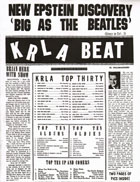
When the November 4, 1964 issue of the KRLA Beat was published it was still in newsletter format, with its articles tinted with hyperbolic fervor. Brian Epstein, in Los Angeles with two of the groups he managed -- Gerry & the Pacemakers plus Billy J. Kramer & the Dakotas -- and seemed full of enthusiasm for a newly discovered singer, Tommy Quickly. Brian seemed convinced that Tommy would become "the biggest star in the world!"
That was being kind. Quickly had no charisma, no discernable talent, and nothing remarkable to offer the music world. Nevertheless the Los Angeles TV show "Shindig!" agreed to give him some air time along with its more substantive British and American acts.
Several big musical events were taking place around this time fifty years ago. KRLA's Bob Eubanks had booked the Rolling Stones, among other acts, to perform November 1 at the Long Beach Civic Auditorium. Not to be outdone by his compatriot, Reb Foster booked the nearby Long Beach Arena for a concert event of his own. You'll see photos of this concert in this issue of the Beat (click the image above left to view it).
Why Long Beach? Venues were much cheaper there than in Los Angeles proper, and both Reb Foster and Bob Eubanks had booked concert and club venues in the beach cities around L.A. For them it was a logical and financially advantageous choice.
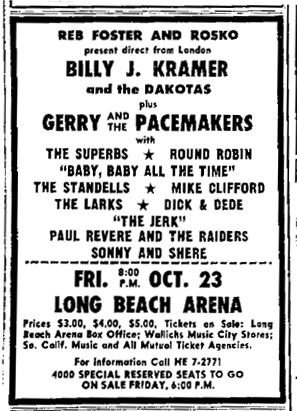
Reb was working with another local deejay, William Mercer, known professionally as Rosko. Rosko had been the first black deejay hired at New York's WINS and at Los Angeles R&B station KBLA, with a later career in free-form FM and international broadcasting, although he never worked for KRLA, interestingly.
But this wasn't a KRLA event and was never billed as such. Reb and Rosko co-hosted a musical line-up that included Billy J. Kramer and Gerry & the Pacemakers (already in town for the T.A.M.I. Show and "Shindig!"), The Superbs, whose tune "Baby, Baby All The Time" was on the KRLA charts, local favorite Round Robin, early appearances (before they had any hit records) of The Standells and Paul Revere & the Raiders, plus Sonny and "Shere," not quite well known enough at this point to be spelled as Cher. In fact, the Beat mentioned that audience members at the show were surprised to discover that the singer was female. On recordings her deep contralto could be confusing to the uninitiated.
The only record of this show is the advertisement from the Long Beach Press Telegram and this issue of the KRLA Beat. Other concerts since have overshadowed its significance. But it's enlightening to see how busy singing groups were when they came to town. Not much time for sight-seeing, alas!
Fifty years redux
10.28.14Another fifty year anniversary!
The Teen-age Music International show was the first of its kind, performed live at the Santa Monica Civic Auditorium on October 28, 1964. Musical acts included some of the best in American and British Invasion: Chuck Berry, James Brown, The Rolling Stones, Gerry & the Pacemakers, The Supremes, Leslie Gore, and more. Hosted by singing duo Jan & Dean, the show also sports pretty wild dancing a la Shindig, courtesy of choreographer Toni Basil.
No Beatles (they'd just been to the States and were busy back at home recording "Beatles For Sale") but who cares? These performances are the stuff of legend. Just watch James Brown if you don't believe me.
A technology that some have likened to High Definition processing, called Electrovision, was used to capture the film footage, and the quality's pretty good.
In 2006 the Library of Congress, no fools they, decided that the American Pictures International film was of sufficient historical (and musical!) interest to add it to the National Film Registry.
You can watch the entire show here or wander over to YouTube to see it in all its glory.
Fifty years go by so quickly
10.7.14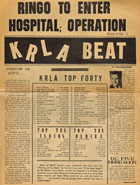
In some ways local and world news has changed very little. Fifty years ago today on October 7, 1964, reported the Los Angeles Times, Los Angeles was suffering under a layer of heat and smog (well, the smog's not so bad these days). The St. Louis Cardinals were in the opening game of the World Series (today they're in the playoffs). The meat packer's union was threatening to strike. The November elections were heating up.
Deeper into the Times was Cecil Smith's television commentary, where he recounted taking Shindig's British producer Jack Good to a Dodgers' baseball game at (where else?) Dodger Stadium. It was Good's first baseball game. Smith called the game a bore but noted that Good was impressed by everything he saw, especially the stadium itself: "Be a marvelous place for the Beatles," opined Good. He wasn't wrong, just prescient.
Good was mindful of such opportunities because of the Beatles' recent triumphant tour of the United States, and most prominently KRLA's coup, hosting the group at the Hollywood Bowl. There would be one more Bowl concert in 1965, and then, just as Jack Good predicted, a stadium debut where the Dodgers normally played baseball.
Cecil Smith, like much of the older generation at that time, didn't get it at all. He mentioned incredulously how Good was "quite addicted" to the Beatles and rock-and-roll, which he dismissed as "whanging monotony." Most media writers at the time held similar opinions. It took a forward-thinking journalist to see otherwise.
Fifty years ago today the very kernel of the KRLA Beat was born. At this point it was little more than a four-page newsletter, painstakingly typeset and laid out by hand by KRLA's Bonnie Golden, a publicist who managed almost every aspect of its production from reporting, designing, and distribution. It helped that KRLA has a strong news staff and deejays whose sources for all things Beatle were well placed (Dave Hull, in particular, had a regular telephone dialogue with George Harrison's mother Louise, who supplied tidbits of information about the group via long-distance calls from England).
In the coming months the KRLA Beat would expand to eight pages, then sixteen. Head publisher and KRLA news chief Cecil Tuck would lend his expertise to the enterprise, and Derek Taylor, former personal assistant to Brian Epstein, was brought aboard to promote the British as well as the Southern California music scene.
But today's anniversary marks the Beat's humble beginnings. If you were there on the KRLA front porch that day and managed to snag one of those rare copies, you were in a fortunate place in the universe.
Click the image above to read the first-ever KRLA Beat!
KRLA goes to the moon (and back)
8.20.14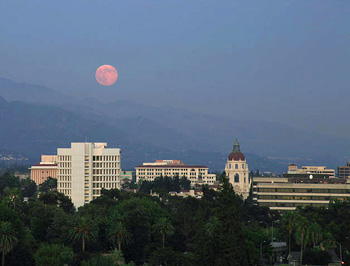
In some ways Pasadena is very different from the way it was forty-nine years ago. More people, bigger buildings, a passel of traffic, a light-rail line. But the moon still rises gracefully over the San Gabriel Mountains just as it did during KRLA's heyday.
On August 20, 1965 a notable event occurred, although almost no one remembers it today. Perhaps its story was overshadowed by the then-upcoming Beatles concert, which would take place three days later at the Hollywood Bowl.
Simply put, for eleven minutes just after midnight, KRLA became the first radio station to have its signal beamed to the moon and back by laser. Engineered by Mark Q. Morgan, then a high school senior at Palmdale High School and organized at the station by program director Mel Hall and deejay Casey Kasem, KRLA's special broadcast could be heard by all who were listening in that night...even ships at sea!
And most remarkably, thanks to the generosity of Mr. Morgan himself, we can have a listen right now.
Brian reads about himself
7.12.14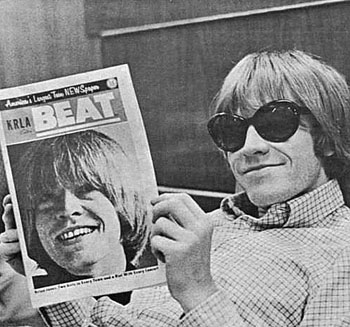
Brian Jones of the Rolling Stones was evidently a fan of the KRLA Beat. Here he reads the February 19, 1966 issue, where the Beat had an article on a documentary film about the group.
Though the Rolling Stones were perpetually reported to be making a full-length feature movie, nothing ever emerged from their many false starts. "Charlie Is My Darling", on the other hand, was filmed by Peter Whitehead during the Stones' 1965 tour of Ireland and was intended for viewing on British television. The KRLA Beat reported that negotiations were underway to find an American network interested in airing the hour-long film sometime that spring.
Whitehead was known in the London music and poetry scene, having made "Wholly Communion" (with Beat poets Allan Ginsburg and Lawrence Ferlinghetti) and "The War Game", an imaginary look at a nuclear attack on London. "Charlie" had something of a Maysles Brothers or Richard Letster cinéma vérité effect, and captured early Stones fans waxing rhapsodic in beautiful black-and-white.
The film's rights had been tied up for years, but in 2012 ABKCO Films announced a new rerelease on multiple media platforms in honor of the Stones' 50th anniversary. You can read about it here.
New Dave Hull interview on the air June 26
6.25.14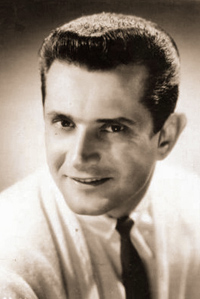
Sorry for the late notice, but if you have some time to spare on Thursday afternoon you're in for a treat.
Long Beach Daily Breeze radio writer Richard Wagoner will join Mike Stark in an interview with legendary Los Angeles radio deejay Dave Hull, the Hullabalooer himself, on L.A. Radio Sessions, airing tomorrow, Thursday June 26th at 2 p.m. on KBEACH.org.
If you miss the live show it will be available later for download at http://laradiowaves.com.
In this hour long special, Dave will talk about the time he spent with the Beatles leading up to their first Hollywood Bowl performance in 1964.
Included will be some rare interviews Dave did with the band and music from the Bowl performance. In a subsequent edition, Dave will talk about his long term stay at the Top 40 giant KRLA. We hope you'll get a chance to tune in.
Casey Kasem and KRLA
6.15.14
Most people know Casey Kasem's legacy from syndicated radio and television. Those of us fortunate enough to have heard him on KRLA from 1963 through 1969 heard a talent fully formed but somehow approachable and neighborly.
Casey had actually begun his career after being drafted in the Korean War in 1952 where he was on Armed Forces Radio. His professional career was launched on WJRT-AM in Flint, Michigan, then on San Francisco's KYA and Oakland's KEWB, the latter of which was a starting point for several other KRLA deejays.
He didn't have his top-40 countdown in place when he came to KRLA in mid-1963 but his afternoon shows, from noon to 3pm, were always peppered with music trivia involving the artists who sang or produced the songs.
We have a few airchecks that demonstrate Casey's inimitable style on the Airchecks page. His tone is warm, friendly, and informative, perfect for an early afternoon. He was the buffer between Ted Quillin's countrified morning effusion and Bob Eubanks' or Dave Hull's more up-tempo post-schoolday freneticism.
Here is is in October 1963, a nice snippet of KRLA in its pre-Beatles atmosphere, with on-air games and news.
How different things were the following July! Only 35 days until the Beatles were to perform at the Hollywood Bowl.
Rest in peace, Casey.
When we were very young
6.11.14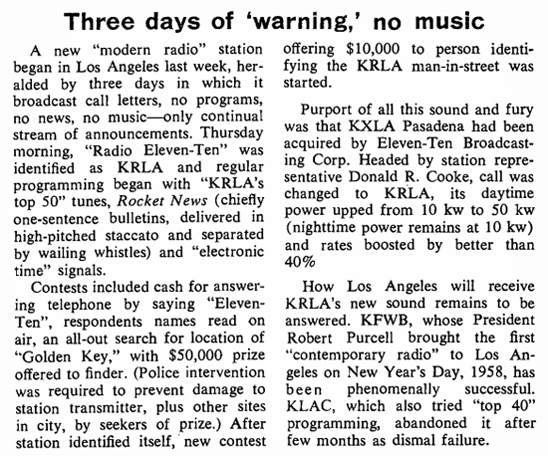
Broadcasting Magazine ran this cryptic news item about a new radio station on the airwaves...or rather new call letters and a brand-new musical focus to go along with the change.
Appearing in the September 7, 1959 issue, it gives the clearest idea of what listeners heard when they tuned in at 1110 kilocycles and found that their Country & Western radio stalwart, KXLA, had vanished.
We know, according to Christopher Sterling and Cary O'Dell's book The Concise Encyclopedia of American Radio that nineteen-year-old Jimmy O'Neill's voice was the first thing broadcast over the new station at midnight on Tuesday September 1, 1959: "You have been listening to KXLA. You are now listening to KRLA -- radio for the young at heart."
For the next three days only the station's new call sign and an unspecified set of announcements filled the airwaves, with regular broadcasting commencing on Thursday September 3.
Whether it was "modern" or "contemporary" or "top 40" radio, Broadcasting Magazine seemed unsure what to call it. As they noted, KFWB had succeeded as Los Angeles' first top 40 station, while KLAC had not been so lucky. There's a sense, from the tone of this article, that Broadcasting's editors felt a second top 40 station in the same market was also doomed to fail.
Of course it was a rocky beginning. But for now, KFWB had a rival on the horizon. Eventually radio mavens would see that Los Angeles was quite capable of handling two, and eventually three, top 40 radio stations. It gave us all more music to love.
One antenna to rule them all
6.09.14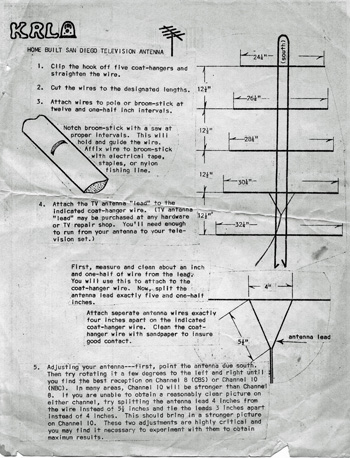
A very kind collector of KRLA memorabilia has shared a nifty document: the original plans for KRLA's 1967 Super Bowl antenna. Click the image at left to enlarge a PDF copy.
Why was a radio station passing out instructions for a television antenna?
The first Super Bowl game was held at the Los Angeles Memorial Coliseum on January 15, 1967. As the first AFL-NFL world championship game ever, it was simulcast by both CBS and NBC television networks.
Only problem: in Los Angeles the broadcast couldn't be watched on local TV. This blackout involved the entire L.A. Basin, where no TV station could air the historic game. Tickets to the game were twelve dollars each ($85 in today's dollars), and even if it sold out NFL football commissioner Pete Rozelle was adamant that he wouldn't lift the blackout.
So KRLA stepped in. Program manager John Barrett asked the station engineering staff to come up with a simple, affordable solution. Mimeographed on the back of KRLA letterhead was a one page schematic with instructions on how to assemble a five-element VHF TV antenna out of coat hangers and a broomstick, plus a length of lead-in wire to hook it up to the televsion -- items that anyone would be likely to have around the house, or could buy for cheap. The antenna specs were designed to help users tune in NBC's KFMB-TV Channel 8 and CBS's KOGO-TV Channel 10, both located in San Diego...where, not surprisingly, the Super Bowl was being aired by both channels.
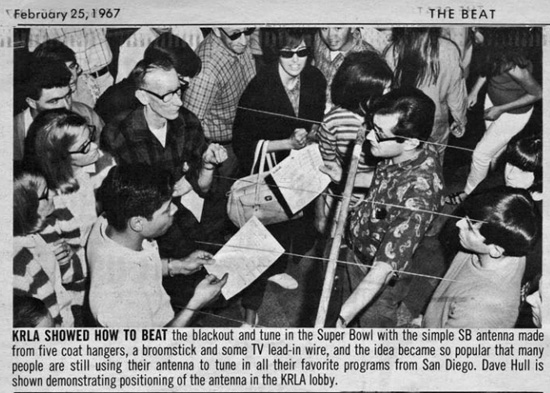
Did it work? Well enough, reported KRLA in its February 25, 1965 issue of the KRLA Beat, to let Los Angeles residents tune in their favorite San Diego programs anytime they wanted. Pictured above is Dave Hull in the crowded lobby of the KRLA studio at 1401 South Oak Knoll, where anxious Super Bowl fans could pick up their schematics and view an actual antenna up close and personal.
It's nice to remember how KRLA came through with a "home brew" solution to help TV viewers watch this historic event. Could be some new KRLA fans were won over that day too.
Beck and the Beat
5.17.14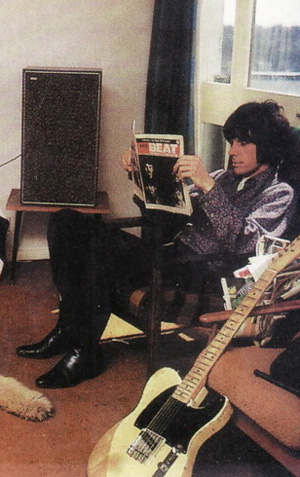
While Jeff Beck was with the Yardbirds he was heard frequently on KRLA, a station with its ear well-tuned towards the more progressive, guitar-driven sounds of the British Invasion. Yardbirds hits like "For Your Love," "Heart Full of Soul," "Shapes of Things," and "Still I'm Sad" were placed in prominent rotation on the KRLA charts. Beck joined the group just after "For Your Love," replacing Eric Clapton on guitar.
Beck's tenure in The Yardbirds provided some of the most exotic sounds on the airwaves at that time, with songs using fuzztone guitar effects and the haunting Gregorian-like chants on "Still I'm Sad." Beck was named Britain's number one lead guitarist by the English magazine Beat Instrumental.
But there were eccentric moments during his tenure with The Yardbirds, including a tendency to be late to gigs or simply not show up at all. Beck was let go after a particularly difficult U.S. tour in October 1966.
Not one to let things get him down, he formed the Jeff Beck Group in January 1967 with Aynsley Dunbar, Rod Stewart, and Ron Wood. The group's sound tended more towards heavy blues and psychedelic pop. They toured the U.K. in early 1967.
At some point, someone snapped a couple of photos of Beck enjoying the March 25, 1967 KRLA Beat, accompanied by his Fender Esquire and the furry paw of an out-of-shot canine friend. Photos of sixties pop stars reading the Beat aren't all that unusual (the Beat had published many), but color shots are rare.
The Beat covered the first Jeff Beck Group in its pages, publishing a letter from him in the January 28, 1967 issue: "Merry Christmas -- even though it's a bit late! As I expect you know, I have left The Yardbirds and am recording with my own group tomorrow. So, I'll be keeping in touch with you and letting you know what's happening for me. Happy New Year. Jeff Beck, England." That's nice!

Nevertheless the Beat noted in the April 8, 1967 issue that the group's debut was a "disappointment," without expanding on reasons why this might be so. A month later, in the May May 6, 1967 issue, Beat senior reporter Louise Criscione elaborated a bit more: "According to Jeff Beck's new publicist, Jeff and his new group broke the existing Rolling Stone record at the Marquee Club. Quite a switch from Jeff's debut which ended with his dropping out of the tour. He recently spent time in Los Angeles and then flew back to Britain to open at the Marquee."
That explains how he got his hands on a copy of the Beat. For the record (no pun intended) the "Rolling Stone record" broken at the Marquee Club in London involved attendance at the venue, which previously the Rolling Stones had held.
That's the last we hear of Jeff Beck in the pages of the KRLA Beat. The group had a brief tour of the States in early 1968, making successful inroads in New York City at the Fillmore East as well as San Francisco's Fillmore West. But by that time the KRLA Beat coverage was much reduced due to staff departures and distribution woes. No further note was taken of Beck or his group, although some accounts likened their rapturous audiences to those during the height of Beatlemania.
Faded signals and rash promotions
4.28.14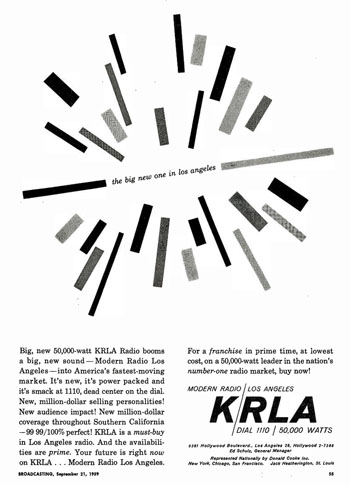
Anybody interested in the business of old radio and television might like perusing the website Faded Signals.
Faded Signals derives its material from the pages of radio and TV trade magazines. It opens a window into the business side of broadcasting as early as the 1930s.
The website has a few items of interest for KRLA fans as well, with some advertisements and airchecks from KRLA's earlier incarnation as KPAS and KXLA. See for yourself.
NB: The link in that page to Jim Hawthorne on KXLA is dead. But try WFMU's hour long show including that same 1947 aircheck from KXLA. You won't be sorry!
But don't stop there. Faded Signals only scratches the surface. American Radio History provides an even bigger array of publications from the 1920s through more contemporary times, including AM, FM, and shortwave radio, plus early television publications like Televiser and Television Magazine from the 1940s.
Broadcasting Magazine was an industry publication probing the details of the business, not always in a flattering light. KRLA took out a full-page advertisement on September 21, 1959 just as they'd gone live with their new call sign on the bones of old country format KXLA. "Your future is right now on KRLA...Modern Radio Los Angeles!"
But KRLA had also just stumbled into its first controversy, providing a listener contest that technically could not have been won by a listener. It was, in fact, won by an insider, rival KFWB president and station manager Robert M. Purcell. This ill-fated launch led to a multi-year investigation by the FCC and very nearly resulted in KRLA's license being pulled permanently.
Imagine a history of Los Angeles radio with no Dave Hull, no Bob Eubanks, no Beatles at the Hollywood Bowl...and no KRLA Beat. Inconceivable! But it almost happened.
Click the advert above for an enlargement.
Forward into the past
2.09.14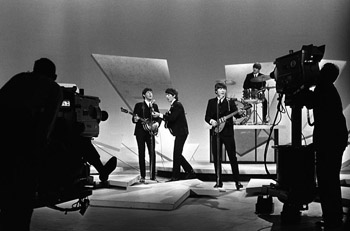
A phenomenon conquered its biggest frontier tonight, fifty years ago.
Although its jargon had the sharp tang of Northern England, its substance was awash in familiar words and rhythms, with lyrical themes as old as the roots of rock and roll.
We could already comprehend the dialect of Britain's great gift to pop music, but seeing the music in motion, on television, was the true revelation of that night.
You may remember how it first happened to you, whatever your age, whatever your country of origin: the first glimpse of their startling new look, the first fair notes of their songs. You needn't have seen it on Ed Sullivan's variety show, as many of us did tonight, to understand what happened. But if you do remember that night, maybe, like me, you have some way of commemorating that evening.
Tonight's the night to sit down with a DVD or a video of the whole show, start to finish, in real time, at eight o'clock in the evening on February ninth. It's better than time travel.
Some of us already knew who they were. Thanks to KRLA and stations like it, we'd already heard their first official release "I Want To Hold Your Hand" for well over a month. Some of us may have sneaked a look at these odd lads in national magazines. Some journalists, alas, were clueless. The January 31, 1964 issue of Life Magazine didn't quite get what they were all about, dismissing them as just another fad. They couldn't have been more wrong.
Tonight fifty years ago the future was newborn. In the maelstrom of their own freshly-minted fame The Beatles themselves were in a sort of netherworld where reality had not yet reached them. Even then they discussed among themselves what would be the next big musical thing.
As they flew across the Atlantic to the United States, the Beatles wondered why America would want them. This despite the fact that "I Want To Hold Your Hand" was number one on the U.S. charts and had been for three weeks when the group stepped in front of the camera for their first live show on American soil. Funny! I think we knew what was happening before they did.
The Beatles changed our world that night, with the help of their own musical heritage as well as the one they admittedly borrowed from us; backed by family, compatriots, soulmates; by a manager who believed in them and a producer who brought out the best in them; and bolstered by the desire to share their musical joy with us.
For a short little while, this Beatlemania in all its facets was only Britain's lustrous artistic gem. Fifty years ago tonight it became ours too, and the world's.
Tune in to the Tunedex
1.11.14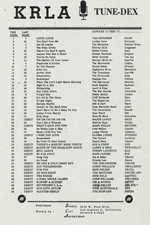
With the launch of this new feature, I can't help but think about the poor typesetters at Studio City Advertising out on Pico Boulevard who had to type up the KRLA Tunedex every week. What a task! All those song titles, band names, record labels to typeset and proofread, bits of history slipping through fingers in an endless list of ever-changing songs.
It's remarkable that these varicolored sheets of history have survived at all...or perhaps more unexpected, that they've survived the years mostly intact.
For those who'd like more context for the progression of pop music from 1959 - 1966 in Los Angeles as well as other radio markets such as Chicago, Minneapolis, and Albany NY, please do visit this treasure of transcribed radio surveys at Oldiesloon.
Catch a wave
12.17.13
By this date fifty years ago, one radio station had already seen the wave of the future. It wasn't KRLA, not quite yet.
Carroll James of WWDC in Washington DC was just the kind of deejay listeners loved: sensitive to the radio audience, always looking for a way to go the extra mile for his fans. So when he received a request from listener Marsha Albert, he paid attention. Marsha had watched the CBS Evening News on December 10, 1963 when the network's London correspondent Alexander MacKenrick filed a story on the Beatles. Why, asked Marsha, can't WWDC play their music?
James put into gear his wheels of influence, procuring a single from England on the Parlophone label (it wasn't yet available in any format in the USA) by this group, The Beatles. On December 17, James asked Marsha to come into the studio to announce it on the air: the first documented airplay of "I Want To Hold Your Hand" in the United States. James promoted it as a WWDC exclusive...which it was, for a few short days.
Capitol Records, which as early as December 7, 1963 had agreed to release the single in January 1964, was flummoxed and demanded a halt to WWDC's airplay. They were too late. A tape made its way to Chicago, where listeners warmed to it just as they had in D.C. Then it made its way to St. Louis. By about the third week in December the tape had reached the airwaves in Los Angeles. Did KRLA know what it had on its hands?
Ironically KRLA was one of the few stations that had actually given the Beatles an early American debut, long before WWDC. WLS-AM in Chicago had scooped everybody, with Dick Biondi giving "Please Please Me" a push in February and March 1963. There's some speculation that Biondi, who came to KRLA in mid-1963, encouraged his compatriots to put the British group's follow-up, "From Me To You," on the air in July 1963, where it charted modestly. The song showed up on San Bernardino's KFXM and KMEN too. A trend?
Alas, no. America wasn't quite ready for a sea change. And KRLA had problems more formidable than recognizing the next big musical tsunami. They were scrambling for their very livelihood.
Their FFC license renewal had been denied in 1962, the result of shenanigans involving a rigged on-air promotional game in 1960. Several appeals in 1962 and 1963, the latest in November 1963 to the U.S. Supreme Court, went down to defeat. Things must have seemed pretty bleak in late December, the holidays notwithstanding.
Then there was this new song...and a certain station in Pasadena was about to find a new lease on life.
"At last -- A real teen newspaper!"
12.12.13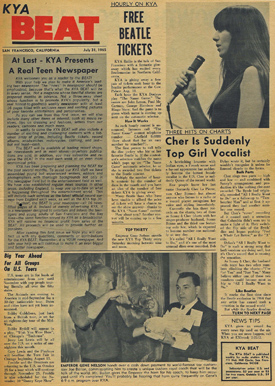
Thanks to Scott at Northern Sky Archive, we have what's close to a mission statement from the KRLA Beat...via its new Bay Area spin-off, the KYA Beat. It's an interesting clue to the new direction. The KYA Beat was just being launched in the San Francisco area, so they had to tell their readership why they were different from all other U.S. music publications. Read the editorial by clicking the image at left.
"The 'news' in newspaper should be emphasized, because that's what the KYA Beat will be in every sense. Not a magazine whose fanciful stories were prepared months in advance. Not a throw-away sheet whose function is to promote KYA's popularity, but a real honest-to-goodness weekly newspaper...."
In the Southern California market the KRLA Beat had already demonstrated this commitment, distancing itself from its "throw-away" predecessor by going to newsprint in February 1965, organizing itself into a real music publication with newly hired reporters and feature writers. KRLA's radio news director Cecil Tuck was clearly a driving force, but so were two new voices joining the Beat community around that time, whose experience with the British pop music scene -- and journalism -- made them particularly authentic additions to the team: journalists Tony Barrow and Derek Taylor.
Both Barrow and Taylor were familiar with British music newspapers such as Melody Maker and New Musical Express, weeklies that also treated music news as serious business. Is it any wonder that the Beat veered towards that more professional model, down to the British-press-inspired red masthead and page layout?
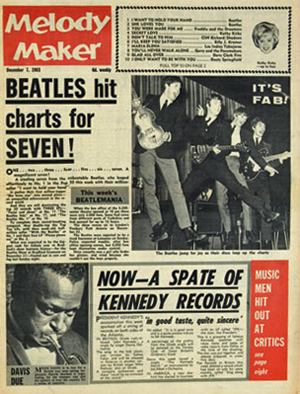
Barrow, originally a Decca Records employee who wrote liner notes for LPs, had written pseudonymous music reviews under the name Disker for the Liverpool Echo, Merseyside's primary newspaper. From 1962 to 1968 he was also employed by Beatles' manager Brian Epstein as the group's press officer. Barrow contributed a weekly column for the KRLA and KYA Beat, focusing on happenings in the British music scene, with occasional special reports on the latest Beatles' recording session.
Taylor's conversion came about when he was assigned by the Manchester Guardian to cover a May 1963 Beatles concert at the Mancester Odeon. Instead of the negative piece his editors expected, Taylor sang their praises. By early 1964 Taylor was ghostwriting a regular newspaper column ostensibly by George Harrison, as well as acting as media liaison for Brian Epstein. Epstein's demanding nature led to Taylor's departure after the Beatles' North American tour in September 1964, which left him a free agent just around the time the KRLA Beat was in its infancy. How lucky for the Beat!
Cecil Tuck's Beat newspaper never quite realized its dream of national pop-music news coverage, but the issues that survive provide a unique window into the evolution of mid-sixties rock and roll, and were the first of their kind in the USA. Not such a bad legacy, really.
For those with a particular interest: the Manchester Guardian was almost the only mainstream British press entity writing about the Beatles in mid-1963 with anything remotely like an intelligent view. Here's a June 3, 1963 article by Stanley Reynolds called "Big Time". In most browsers you can click the jpeg image to enlarge.
Something new
11.21.13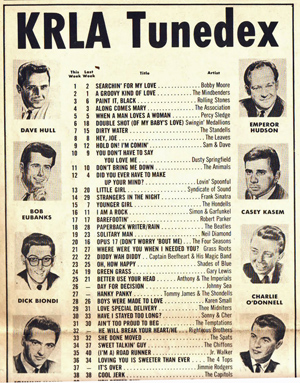
Once the KRLA Beat was being published, readers always had a copy of the Tunedex at hand.
KRLA's chart listings of the top thirty songs of the week was a great way to keep track of what was being played on the station, as well as reading sneak peeks at new musical trends.
But before the Beat was published regularly starting in late 1964, the only option that KRLA listeners had was to pick up a mimeographed copy of the Tunedex at their local record store or other purveyor of fine musical news.
Thus the rise of Beatlemania on KRLA would have been lost...without the steady appearance of the 1964 chart listings, capturing wave after wave of new and old-guard music from across the pond as well as from our own shores. But there's something new coming to the KRLA Beat blog.
Starting January 11, 2014, we'll post a Tunedex once a week, for every week (well, except one, we're missing the first week in January) that KRLA issued its chart during the whole of 1964. Fifty years to the day, you can relive the progress of popular music as the songs of the Beatles changed everything in that most auspicious year.
Check back with us starting January 11, 2014 for our new feature!
Dick Biondi, now and forever
09.21.13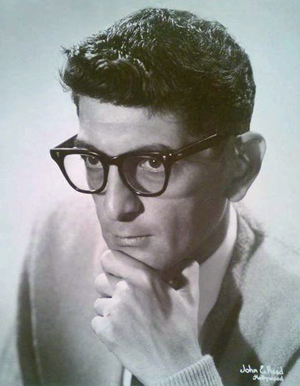
Speaking of important deejays, just this morning National Public Radio had a delightful interview with Dick Biondi, which, if you didn't tune in this morning, you can hear here.
His voice is almost the same, not quite as frenetic, not as high-pitched, but still the same vim and vigor.
He has some wonderful stories about working at WLS-AM in Chicago, playing for the first time in the U.S. a record by a curious group from England called the Beatles, and coming to Los Angeles to a radio station we may have heard about before.
His contribution to American radio is incomparable and at 81...well, we should all be so tuned in.
Fifty years of the Fabs
08.11.13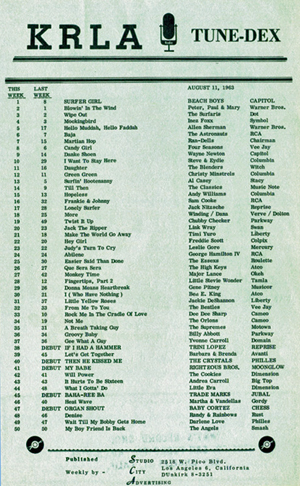
KRLA wasn't the first to play a Beatles song on the radio, but fifty years ago a Beatles song did grace its airwaves...months ahead of the arrival of Beatlemania on our shores.
Likely as not we had then-new KRLA deejay Dick Biondi to thank for it. Biondi was fired from Chicago powerhouse WLS-AM in May 1963 and came to work for KRLA in June 1963. While at WLS he was the first U.S. deejay we can document who played "Please Please Me" in February and March 1963.
Something about that band must have resonated with him, and he may well have been the person to suggest that the band with the odd-sounding name might make it big on KRLA. Or perhaps KRLA, in its inimitable way, was looking for the source band of Del Shannon's cover of "From Me To You."
On the KRLA Tunedex of August 11, 1963 we can see (click the image to enlarge) the Beatles' third single, "From Me To You," lodged comfortably at number 32, up from number 33 the previous week. But it was too early. The airwaves were still awash with the sounds of surf and pop favorites like "It's Judy's Turn to Cry" by Leslie Gore and novelties like "Martian Hop" and "Hello Muddah, Hello Faddah."
"From Me To You" didn't quite catch with Southern California audiences, and as far as anyone knows there was no more Beatles presence at KRLA until December 1963, when radio listeners began to catch a wave from across the pond...a much bigger wave than anything home-grown.
Oldies but goodies
11.26.12
Yes, it's true that the blog has been a little quiet this past year. Real-life work-related tasks intervened, but things are quieting down now and there's breathing room at last for more KRLA updates.
Local NPR affiliate KPCC -- coincidentally located in Pasadena -- posted a nice article online about Art Laboe, long-time Southern California deejay who has had a significant involvement with various radio stations in and around town, not the least of which was KRLA itself.
For the interview, slideshow, and sound clip, please follow this link to KPCC's article on the indefatigable Art Laboe.
KRLA's big three deejays
10.31.11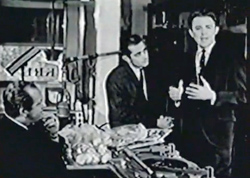
Thanks to a tip from a KRLA fan and regular reader, this tiny gem was uncovered. It's just a small portion of a 14-minute pastiche of various Beatles interviews from 1963 and 1964. Beginning at about the 32 second mark KRLA's Bob Hudson, Dave Hull, and Reb Foster discuss the phenomenon known as the Beatles. Click the photo at left or this link to reach the YouTube interview. KRLA deejays continue discussing the group till the 1:15 minute mark.
"They have an unusual appearance," admits Reb Foster, "and a lot of it is the haircuts." Dave helpfully and erroneously explains that the British word for "beatnik" is, in fact, "Beatle." Emperor Bob Hudson demonstrates his keen ear by successfully pronouncing the word "Beatles" with a Northern English glottal stop.
The collection isn't professionally edited and jumps around from snippets of Granada TV's 1963 documentary on Liverpool musicians, "The Mersey Sound," plus British and American newsreel coverage of the band's departure for the States and arrival in New York in February 1964, as well as some other Beatles interviews from the time.
A second brief clip of Dave Hull discsussing the Fabs is embeded in this KABC-TV news story that was aired during the time of "The Beatles Anthology" in November 1995, starting at about the 1:40 mark. The 1964 Dave and the 1995 Dave appear in the same interview discussing the group's importance.
Some of the beautiful people
09.23.11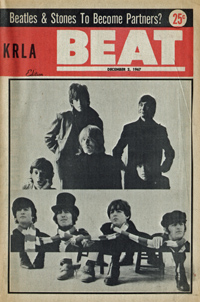
Regular reader Timmy sent in a brief audio snippet in mp3 format of Bob Dayton's evening show from Tuesday December 5, 1967 where KRLA was busy promoting its latest edition of the KRLA Beat. Thanks, Timmy!
That current issue, with a publish date of December 2, relied more than usual on headline hyperbole. C'mon, the Beatles and Stones as partners? But hey, it was Tony Barrow, the Beatles' publicist, and if he said the two biggest rock-and-roll groups in the universe were exploring joint ownership of a recording studio, who were we to argue? Click the cover of the Beat to read up on life in the pop-music fast lane at the time.
Speaking of L.A. radio history, I can highly recommend this profile on Hunter Hancock by journalist Dave Allen of the Inland Valley Daily Bulletin. Without Hancock, I think it's safe to say that rhythm-and-blues music might not have been such a large part of our daily listening diet as it was in the fifties and sixties. Hancock, alas, was never one of KRLA's Eleven-Ten men but his influence was widely felt in Southern California radio. He was a unique on-air presence at a time when music was ripe for change.
More voices from the past, now online
08.30.11
You may have noticed some new airchecks online. Someone with a cache of old tape recordings donated them for transfer from reel-to-reel, so we're up and running with a few new selections.
Not everything is pristine, coming as they do from a variety of sources, but all are chock-full of interesting historical tidbits. I like the jingles package in particular, though there are some I swear I never heard on the air at the time.
There's more material to come during June and July, including several unscoped airchecks (i.e. full of music) from the 1981 KRLA reunion. If you were one of those intrepid KRLA fans who recorded broadcasts for posterity, and if you'd like to share something from your collection that we don't already have online (or that you have in better quality), please let us know.
New airchecks are listed at the top right of the airchecks page, and are also included in the main column describing and linking to each one. If you have any trouble navigating or hearing them, please get in touch and we'll try to help out. Have fun!
Update August 2011: There are more airchecks coming in September. It's been a busy summer, sorry about that. Patience is a virtue, or so I was told by someone at one point.
John Gilliland's 'Pop Chronicles'
05.24.11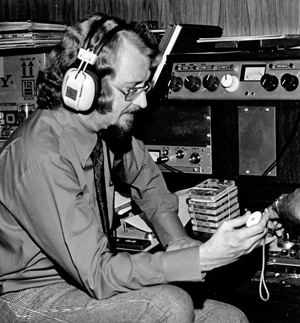
KRLA's news director (and Beat publisher) Cecil Tuck wasn't one to mince words. When he liked someone he was effusive. Radio historian Don Barrett talked to Tuck soon after John Gilliland's death in 1998. "If I could have cloned John Gilliland," said Tuck, "I would have had an entire station made up of John Gillilands!"
Gilliland came to KRLA as a newsman in 1965 where he quickly became one of the station's shining stars, known on the air at first as John Land. While contributing to the newly-inaugurated Credibility Gap, KRLA's signature news-and-satire show, Gilliland also focused on a pet project of his, eventually titled the Pop Chronicles. The concept had been inspired by the KRLA-sponsored Monterey Pop Festival in 1967, whose success convinced Gilliland to develop a wide-ranging history of pop music, the first such radio documentary of its type. He spent two years researching and interviewing singers, songwriters, managers, and producers. The show's range was broad, including R&B artists who had contributed to the birth of rock-and-roll as well as then-contemporary music makers in rock and folk-rock.
The documentary eventually comprised 55 hours of rare interviews and musical illustrations, broadcast on KRLA in one-hour segments from 1969-1970, with a selection of those shows rebroadcast out of sequence in 1984. At Gilliland's death the taped collection was donated by his sister to the University of North Texas to be housed in its digital library, which has recently made portions of it available online. This excerpt, from show number 34, includes an interview with erstwhile KRLA Beat reporter/editor and former Beatles associate Derek Taylor. Other chapters of the collection can be heard on the UNT Digital Library website.
Thanks to Bill Earl, KRLA historian, for updates about Gilliland's career at KRLA.
Heart and soul
04.12.11
To some Southern California listeners, legendary disc-jockey Art Laboe was Mr. KRLA. His tenure as program director in the 1970s and his stint on the air in the 1980s with call-ins and dedications revived the station and made it relevant to several generations of listeners.
True, he wasn't a part of KRLA's initial golden age but he had a special gift in reaching out to music fans and building listener loyalty. This wasn't surprising. Laboe had lived and breathed radio since he was a teenager. And he had a connection to 1110 that predated the existence of KRLA itself, though it's not widely known.
Laboe himself remembers being at KXLA, KRLA's predecessor, in 1955, but he was actually doing an on-air show as early as 1951. At that time KXLA had ten thousand kilowatts of western-swing power, but time slots were open to anyone who wanted to pay for an hour or two of alternative entertainment. In and around Cliffie Stone, Tennessee Ernie Ford, and "Squeakin'" Deacon Moore, KXLA provided a home for religious shows, cooking hours, farm reports...whatever might pique listeners' interest. A forum was ready and Laboe convinced his sponsors to pay for his airtime.
Laboe's career had begun in 1943 at KSAN-AM in San Francisco. He had years of experience feeling comfortable in front of the microphone, even without the classic radio-announcer voice, and he had a knack for marketing his format. In the early 1950s at KXLA he took his broadcast on the road, roaming the city with his "Queen of Cuisine" contest where local car-hops talked about the drive-in food they served. Punctuated with contemporary R&B, Laboe hosted shows broadcast remotely from Scrivner's Drive-In on Wilshire and Western and Bob's Big Boy hamburger restaurants. Swing-shift workers came by at all hours to grab a meal and a bit of on-air entertainment. Sometimes there'd be an impromptu dance, courtesy of Laboe's portable dance floor.
This was pre-rock-and-roll, a genre that technically didn't yet exist. Another popular deejay, Hunter Hancock, also played rhythm-n-blues at KVFD, a station on south Western Avenue, but Laboe's audience seemed to prefer catchy releases by the Penguins and Chuck Berry. KXLA 1110 fans heard songs that Laboe would later call "oldies but goodies" years before the station left behind its "hillbilly" format and became KRLA in late 1959.
Laboe wandered among various L.A.-area stations in the 1950s as a contract deejay, calling his format the "Original Roving D.J Show," sometimes broadcasting from two or three stations a day. He had gigs at KXLA and KGFJ at the same time, then landed at the now-defunct KPOP. Laboe returned to 1110 as program director in the mid-1970s and by 1977 KRLA had trounced KHJ in Arbitron ratings...a rivalry just like the old days. Laboe remained with KRLA off and on through the 1990s as programming consultant. Not suprisingly his show is still in syndication and airs on a variety of stations and on the Internet.
Who are those guys?
03.08.11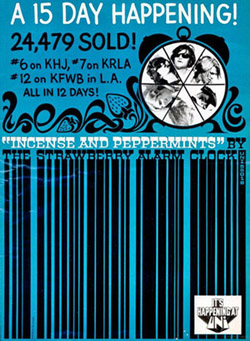
As late as 1967, when rival KFWB was about to change to an all-news format, a young and upcoming band like The Strawberry Alarm Clock could still gain focus with an ad like this one. Their song "Incense and Peppermints" was racing up the charts of all three Los Angeles top-forty stations, and the group wanted you, the music executive reading Billboard, to know the facts and plan your record sales accordingly.
Billboard covered station rivalry with some enthusiasm all during the nineteen-sixties. The scramble for the toppermost of the poppermost was never predictable. KFWB reigned supreme in the early part of the decade with its "Color Radio" format originated by Chuck Blore at KELP in Texas. When Blore brought the format to Los Angeles in 1958, KFWB was for a time the only local purveyor of rock-and-roll, and it's safe to say that KRLA would never have been reborn from the ashes of country-western KXLA without KFWB's initial success in top-forty programming. Envy is occasionally a great catalyst.
And then there were three. KHJ's "Boss Radio" format was launched in April 1965 and had to play catch-up to both KFWB (then losing ground to KRLA) and L.A.'s number one pop-music outlet at Eleven-Ten on the radio dial. The threesome struggled for a few years for top ratings, but KRLA came out on top consistently from 1964 - 1966. What was its secret? Maybe it was simply that KRLA had more than a playlist, a passel of talented on-air personalities, and a pop-music newspaper to offer. It had intrigue!
The December 11, 1965 issue of Billboard detailed a favorite tale. One night, two mystery men approached KRLA's studio in the Carriage House of the Huntington Hotel on Oak Knoll Avenue in Pasadena. One of them had a copy of a Beatles record...one that had yet to be released in the USA. He offered to sell it to the deejay on-duty that night, who turned it down. But a sharp-eyed teenager working as a volunteer at the station called program director Mel Hall, who in turn called Dave Hull, both of whom begged the deejay to buy the record. The deejay couldn't meet the price, so Dave himself drove to the station with $70 in his pocket to buy the disc. As a courtesy, Dick Biondi invited Dave to be a guest on his show the following night to host the exclusive premiere of a Beatles record no other station in L.A. had managed to find.
Billboard asked Mel Hall about the transaction. Didn't the station have an agreement with Capitol Records to honor a record's official release date and not jump the gun with pre-release airplay? Hall neatly sidestepped the question and agreed with Billboard that no one really knew who was selling the record: "Capitol Records tried to find out who they were, but all we could tell them is that the guy outside may have been called Oscar."
And perhaps, after all, the record wasn't even Capitol's. Note Louise Criscione's "On The Beat" column from the April 14, 1965 issue of the KRLA Beat. She refers to two rare Beatles tracks played by Dave Hull on the air. "Cara Bella" must be "Clarabella", sung by Paul McCartney, and "Soldier of Love" by John Lennon, both at that time unavailable on official vinyl. They must have come from the Beatles' BBC radio show, not from 1961, not pre-Epstein, as Criscione claimed, but from 1963. Someone must have had good connections to deliver a copy to the KRLA listening audience...someone, perchance, named Oscar?
Out of the ether into TV
02.06.11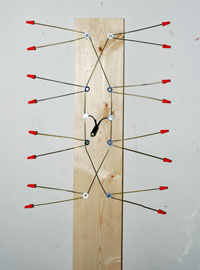
Normally KRLA had very little to do with local broadcast television, but in early 1967 the station came to the aid of football fans throughout the Los Angeles basin. Every time the Super Bowl comes around it comes to mind.
The first Super Bowl game was subject to a broadcast blackout on Los Angeles TV, something having to do with the proximity of the event being held in nearby San Diego. TV and football aficionados in the region were up in arms. At this point, KRLA stepped into the fray and offered something that might help: an "amazing do-it-yourself electronic marvel."
With a narrow wooden board or a broomstick and some coat hanger wire (similar to the photo at left, which you can click to enlarge), plus a suitable lead-in to connect it to the TV of your choice, KRLA offered a schematic to listeners that told them in great detail how to build a VHF TV antenna that could pull in either of the two San Diego TV stations broadcasting the game. It was dubbed the "KRLA Simple S-B Antenna."
KRLA engineers built a prototype and tested it before printing up schematics, which were free to all who might inquire. KRLA Beat publisher Cecil Tuck built one himself and told the Pasadena Star-News that KRLA had received 15,000 requests for the antenna plans. Click the headline above to read the full article from January 12, 1967.
Page 8 of the February 11, 1967 issue of the KRLA Beat had a story about the antenna's success, for those who'd like more details of the project. Where I come from, antenna-building trumps football-watching any day of the week.
Clash of the Titans
01.25.11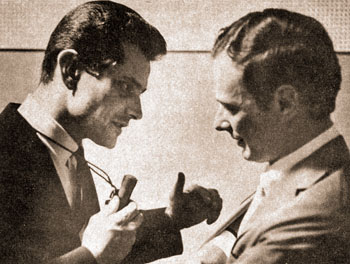
I don't want to say bad things about other stations.
But other than KRLA, where was their a radio station in Los Angeles where an on-air drive-time personality could also be a print and a broadcast journalist?
I suspect it was news director Cecil Tuck's influence, or perhaps something that wafted from KRLA's newsroom, or maybe something intertwined with the KRLA Beat's sense of musical journalism. It's hard to pinpoint just one source.
Dave Hull, whose field was not focused on news, wrote articles for the early KRLA Beat, and this photo from early 1965 shows KRLA's number one deejay Dave Hull with number one Beatles manager Brian Epstein. Brian was visiting Los Angeles to hammer out details of the Fabs' second Hollywood Bowl concert later that year. Dave took the opportunity to record an interview.
Snippets of interviews like these (most involving music groups traipsing through Los Angeles) were broadcast as teasers on Dave's afternoon show, to the delight of his listeners. I still remember a notable afternoon when Dave introduced an "exclusive" interview with George Harrison of the Beatles. The totality of George's interchange: "Hello, goodbye."
Where have the porch people gone?
01.09.11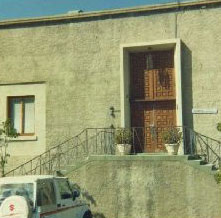
Or more precisely, where have all the pictures of KRLA's front porch gone?
It was a popular place in the 1960s, where all sorts of KRLA fans would gather to meet and greet their favorite deejays. Musicians who visited the station were always given a friendly welcome by the Porch People too.
The tradition goes back much further than the 1960s. Deejay Dave Hull, who grew up in Arcadia, recalled hanging out on the porch in the late 1940s, when the station was called KXLA, hoping to say hello to Jim Hawthorne, KXLA's wacky artiste of the airwaves. But for some reason, photos of the famed porch are few and far between.
From his website, KRLA historian Bill Earl was able to provide a snapshot of the station's famous porch. This photo comes from KRLA's "heart and soul of rock-and-roll" era, about 1985. But there's a dearth of images from earlier times. Can you help us find a few photos from those days of yore?
If you have any pictures of the porch from the 1960s that you'd be willing to share, with or without people, please let us know. We'd like to feature them here in an upcoming post, and it goes without saying that we'd be happy to credit you if you like.
Not-so-beautiful Bob
12.29.10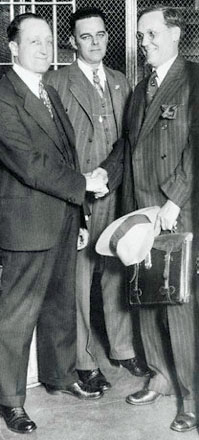
Before KRLA was a top-forty clear-channel powerhouse with "Beautiful Bob" Hudson on it deejay roster, it was KPAS, the genteel Pasadena presence on the airwaves, with big-band music, radio travelogues, and inspirational programming. Owner Frank Burke was willing to give a platform to almost anyone who wanted to address the community (and who'd pay for the time to do so), but Robert P. "Fighting Bob" Shuler, pictured at left with hat and valise, was a bit of a handful.
Shuler's brand of evangelism had been part of the Los Angeles airwaves since 1922, when radio first began to attract preachers as well as entertainers. A fundamentalist minister at his own local church, Trinity Methodist, Shuler was no shrinking violet when it came to controversy. He railed against Catholics, Jews, African Americans, alcohol, and newspapers. He caused a stir in the 1920s by insisting that the Ku Klux Klan was just another fraternal organization like the Masons or the Elks. He hated most estabished politicians and ran for office at the head of the Prohibition Party in 1932.
In 1930 Rev. Shuler was released from jail after serving 16 days of a twenty-day sentence for radio attacks on judges. His platform had been his own radio station, KGEF ("God Ever Forward"). Once it was silenced by authorities, Shuler was on the lookout for other radio venues. In 1942 he paid for time on Pasadena's newly inaugurated KPAS at 1110 on the dial.
Suddenly KPAS owner Frank Burke had a first amendment issue on his hands. The FCC contacted Burke and asked for tapes of Shuler's broadcasts, citing wartime concerns that the shows were "detrimental to the war effort of the United States," as the Long Beach Independent put it. Shuler admitted that he'd been critical during his 15-minute Sunday morning broadcasts of President Franklin Roosevelt as well as communists (whom he felt had infiltrated the FCC), racketeers, and New Deal proponents. Shuler understood that the station "got jittery" over his diatribes and cancelled his show. He didn't blame Burke. But Shuler was off the air once again, a move that even his former political opponent, Congressman Jerry Voorhis, deplored as an attack on free speech.
Frank Burke was more blunt. He had not only the FCC to contend with, he had advertisers as well as listeners to serve. Burke told the Los Angeles Times in January 1943, "You know, I'm pretty liberal about free speech and, doggone, I like Bob, but it just seems he's always getting off the deep end."
Many thanks to a sharp-eyed reader who sent in the clipping from the Long Beach Independent. It helped shed a little light on KRLA's ancient history.
We're not much on fancy words...
12.01.10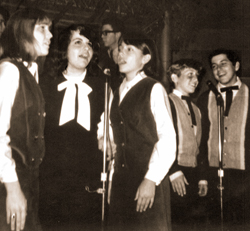
KRLA collector Timmy sent along a nice sound clip of Dave Hull opening his afternoon show with a very local hit record. (If I had to guess, I'd say this snippet comes from the 1981 KRLA deejay reunion, but I'd be happy for corroboration).
The band, pictured at left, was made up of Suzie Cappetta and her two younger brothers, Michael and Robert, plus two cousins, Gale and Paula Chodkowski. Dubbed "The Scuzzies" by Hull himself, the quintet recorded their paean to Dave, "Dave Hull the Hullabalooer," in December 1964.
The backing group was The Vibrants, the house band at Bob Eubanks' Cinnamon Cinder nightclub, and one of the producers was Don Wayne, road manager of the Everly Brothers. KRLA listeners loved it. The song made it to number 13 on the KRLA Tunedex for March 1965, but if you were a KFWB-only fan you'd have missed it entirely.
The Scuzzies' mysterious lyrical reference to "your junky float" can be clarified in the January 1, 1965 issue of the KRLA Beat, where photos of the Hullabalooer show Dave riding a float in the Hollywood Christmas parade that was made of...junk, most of which had been provided by fans. All Emperor Hudson got was a gold Rolls Royce, poor fellow.
 The Scuzzies gave voice to the affection fans felt for their number
one KRLA deejay. Dave remained one of KRLA's most popular personalities throughout his
station tenure and was always a heavily-requested favorite at local dances and school events.
The Scuzzies gave voice to the affection fans felt for their number
one KRLA deejay. Dave remained one of KRLA's most popular personalities throughout his
station tenure and was always a heavily-requested favorite at local dances and school events.
Here Dave hosts a concert at Bishop Alemany High School in Mission Hills in 1964, where one-hit-wonder Terry "Suspicion" Stafford headlined. Seated from left, Bishop Alemany students Becci Reynolds, Bev Benefiel, "Spyder" Villalobos, and Eileen Chapman visit with Dave during a break in the show.
If you missed getting your own copy of The Scuzzies' record back in 1965 and have been kicking yourself ever since, rest easy. You can buy a version with extra tracks on eBay.
R.I.P Charlie O'Donnell
11.02.10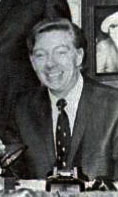
So sorry to hear of the passing of Charlie O'Donnell this past weekend, who was familiar to KRLA fans as "Charlie O" during the station's heyday. O'Donnell had his start in Philadelphia and caught the deejay bug early while still in his teens. Online radio station HyLit Radio recently recorded an interview with O'Donnell, who recounts his varied career from his Philly start-up to Dick Clark and "American Bandstand," a move westward to KHJ for a job that vanished as soon as he arrived, and his three-year stint at KRLA.
Once he moved into the 9am-12 noon time slot at KRLA in September 1964, Charlie was ready to show how valuable he could be to KRLA Beatles fans. As Billboard reported in their Nov. 21, 1964 issue, Charlie helped KRLA obtain an advance copy of the Beatles' latest single, "I Feel Fine," eighteen days before its USA release. How did he do it? An unnamed neighbor of Charlie's had a copy, it seems, and somehow the record made its way to the KRLA studios. It pays to have nice neighbors.
Capitol Records suffered a case of the screaming ab-dabs. "This advance airplay creates a false demand" for the record, a spokesman protested self-righteously...as if anyone could create a false demand for a Beatles record. But it was great publicity for KRLA and gave listeners yet another reason to keep their ears glued to L.A.'s "Official Beatles station." Thanks, Charlie!
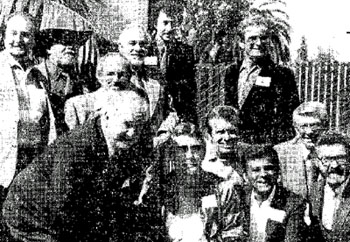 Though Charlie O'Donnell left KRLA for KGBS in 1968 and enjoyed his much
more renowned TV career, he agreed to join KRLA deejays of yore for the 1981 KRLA reunion of its classic
line-up. This photo is from the Orange County Register.
Though Charlie O'Donnell left KRLA for KGBS in 1968 and enjoyed his much
more renowned TV career, he agreed to join KRLA deejays of yore for the 1981 KRLA reunion of its classic
line-up. This photo is from the Orange County Register.
Back row from left: Reb Foster, Ted Quillan, Dick Moreland, newsman Richard Beebe, 1980s program director Jack Roth, and Dave Hull; front row from left, "Emperor" Bob Hudson, Bobby "Boris" Picket of "Monster Mash" fame (who briefly had a Saturday evening show on KRLA in late 1964), Bob Eubanks, Casey Kasem, Charlie O'Donnell, and Johnny Hayes. Hard to believe that almost thirty years have passed since that get-together....
KRLA's optical psychedelic symphonic nerve spasm
10.12.10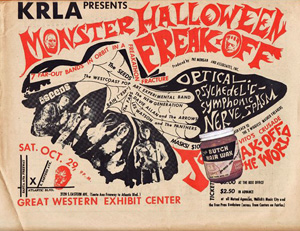
Our good friend Timmy sent along this clipping (click to enlarge), apropos of the season. For a change it's not from the KRLA Beat, rather (apparently) from L.A.'s underground newspaper The Free Press.
But KRLA hosted the event, titled the "Monster Halloween Freak-Off," held Saturday, October 29, 1966 at the now-defunct Great Western Exhibit Center in Commerce, just southeast of downtown Los Angeles.
L.A.'s own The Seeds were clearly headliners, having just enjoyed their first hit "Pushin' Too Hard" that same year. They were also a favorite band on KRLA's playlist and covered in the KRLA Beat during 1967. But the rest of the show's lineup is interesting too.
The West Coast Pop Art Experimental Band included Danny and Shaun Harris, sons of classical composers Roy and Johanna Harris and schoolmates of the young Ry Cooder; lawyer-turned-singer Bob Markley; Michael Lloyd, late of the surf band The New Dimensions; plus musician friends Danny Belsky, Dennis Lambert, and John Ware. They incorporated light shows in their act and played with The Mothers of Invention, The Count V, and The Factory. Read up on them in detail, if you like, or give a listen to a song or two on YouTube.
A Hollywood band called Rain had released its latest single, "ESP" backed with a song inspired by Them's "I Can Only Give You Everything," called "Outta My Life," a track I swear I remember hearing on KRLA's playlist. The Fabs from Fullerton, California had recently covered a Fred Neil song, "That's The Bag I'm In," while The New Generation was fortunate enough to record for Capitol Records and play local Sunset Strip clubs...but Capitol never released their music during their heyday, alas.
San Fernando Valley local Davie Allan and his group the Arrows had their biggest success with "Blues Theme," which melded garage-punk and surf instrumental sounds. The group contributed ubiquitously to biker movies such as "The Wild Angels" and "Born Losers". The only non-local band was South Dallas' Les Watson and the Panthers, an all-black soul group who specialized in Motown and soul covers. You can sample their single "Oh Yeah" released on Pompeii Records, a subsidiary of Atco which was owned by Pat Morgan, producer of KRLA's "Freak-Off" show.
No telling what the "optical psychedelic symphonic nerve spasm" advertised on the poster was referring to...the music? A light show? Or maybe the winner of the "wiggiest masked freaker" award? Your guess is as good as mine. Happy Halloween!
I dropped my harmonica, Albert
10.04.10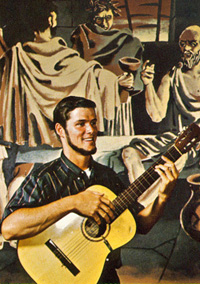
Tim Morgon had the unfortunate luck to follow a musical trend that was almost over by the time Los Angeles radio noticed him...and the disinclination to pick up on the imminent dawning of folk-rock, which would invade KRLA's airwaves in early 1965. With a style that was lightly folky, similar to The Kingston Trio or early Smothers Brothers, Morgon was a popular singer at the Balboa nightclub "Prison of Socrates," run by two Greek entrepreneurs, Jerry and Ted Nikas. Balboa teens adored Morgon and he played numerous gigs at Southern California clubs as well as high school assemblies, one of which was hosted by KRLA's own Dick Biondi.
The release of an LP on Fink Records called "Tim Morgon at the Prison of Socrates" (which was a better title, I think, if you didn't know that it referred to a nightclub) sparked a flurry of sales at Wallich's Music City in Hollywood, one of the region's biggest record stores. Morgon fans assumed that radio exposure was next for their fave rave. When it didn't happen, the Nikas brothers helped them organize petitions and picket lines at the two main top-forty stations, KRLA and KFWB. Fink Records was owned by the brothers and clearly they had something to gain from the protest too.
This Billboard article from December 7, 1963 showed how (and how not to) respond to your radio constituency. KFWB's program director Jim Hawthorne didn't get it. "We won't have anything to do with any promotion which coerces us and places us under duress," he declared humorlessly. KRLA's John Barrett was more deft, telling Billboard that his station was "frankly quite flattered that the kids have such a high regard for our station that they wanted to picket us to play the single." Barrett's praise for Morgon's sound was good public relations. But in the end neither KFWB nor KRLA added Morgon to their playlists.
A couple years later the KRLA Beat interviewed Morgon in their December 25, 1965 issue on page 9. Morgon described his music as "folk-like" and expressed his dislike for protest music: "We have enough war, and death, and destruction without this, and I don't think a song here and there is going to do anything about it." On the same page you'll see a small advertisement for the Nikas Brother's quirky 30-minute film about the Tim Morgon phenomenon, "Dirty Feet," premiering at the Cosmos Folk Club in Seal Beach. For those who missed it, YouTube has a copy of "Dirty Feet" online for your viewing pleasure, with Part I here (follow the links on that page for Parts II and III).
Tabloid wars: "Go" vs. the KRLA Beat
09.10.10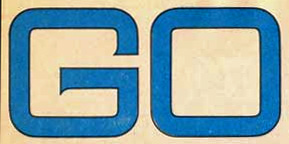
Robin Leach was apaprently well-known for some TV show about rich and famous people...a phenomenon that I was spared for some reason, thankfully. But before he was involved in television he was in print, first as the youngest columnist for England's Daily Mail, then working for a handful of American magazines.
To my surprise, Leach was also involved in the only large-scale rival to the KRLA Beat, a tabloid called "Go Magazine" (not the same "Go" that exists today, it goes without saying). In the April 1, 1967 issue of Billboard (which you can read via Google Books, if you're so moved), Claude Hall reported on the state of teen newspaper coverage in the U.S. Leach claimed that each twelve to sixteen page issue of "Go" had a weekly circulation of 390,000, mostly on the east coast. Issues were personalized to include radio station call letters and top-40 indexes for stations from upper New York to New Orleans, though the content was more promotional than journalistic. Does a complete copy of "Go" exist anymore? I was only able to find a few bits and pieces, such as this one, courtesy of Reel Radio's website.
KRLA Beat's publisher Cecil Tuck was also interviewed for the article, where he gave circulation figures of 200,000 copies per Beat issue, with expansion to other markets planned in the near future. Tuck had already had some luck with the KYA Beat in San Francisco. Adding other cities must have seemed like a good idea at the time. The Beat was a bigger newspaper, arguably more professional than "Go," and had an extensive staff of reporters ("college girls studying journalism," Tuck called them, though they were mostly post-college freelancers by 1967).
Expansion was probably the beginning of the end for the Beat. AM radio was entering a new phase by 1967 when it began to take a back seat to album-oriented rock on the newly popular "underground" FM stations, where promotional newspapers and top-40 lists were less treasured by the listenership. The KRLA Beat limped forward all through 1967, sputtering into insolvency by the following spring. "Go", cheaper to produce, continued to be published until 1969. I don't think it's inaccurate to say that more folks remember the KRLA Beat than "Go," though. There's probably a good reason for it.
Why is this night different from all other nights?
08.23.10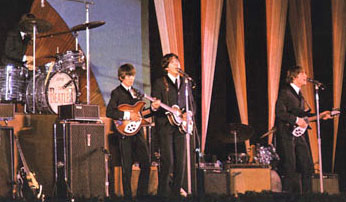
Nothing important, just the forty-sixth anniversary of the first Hollywood Bowl appearance by some fellows from Liverpool.
They weren't the first rock-and-roll artists to appear at the Bowl. Dick Clark's Caravan of Stars entertained an enthusiastic audience in August 1961 with then-popular stars like Chubby Checker, Freddie Cannon, and Jan & Dean, and the venue played host to jazz artists, folk singers, and other popular performers in the years preceding the Beatles' appearance. It wasn't only a place to hear classical music.
But excitement about the Beatles' first Los Angeles area concert was palpable, especially over the radio airwaves. KRLA deejays shouted reminders in station promos as often as they could. Tickets quickly sold out for the Beatles' show, with prices ranging from $3.50 to $7.00. The most expensive tickets put spectators potentially as close as Row 10...so near and yet so far.
A bit of the magic was captured in this news footage of the event, which I believe has been post-synched to the Capitol Records recording of the concert, hence the slight mismatch. You might say that the KRLA Beat was born this night, if only in the minds of KRLA management. But that was a good place to start.
Listening to Lew's Credibility Gap
08.04.10
One of KRLA's bright spots in the late 1960s was its innovative news programming in the form of The Credibility Gap. The 15-minute show was developed by newsman Lew Irwin, who had served a stint at KPOL-FM from 1958-1962 and KABC-TV before founding his own news production company in Southern California. KRLA was an ideal avenue for Irwin's talents. Unusual for a pop/rock station, KRLA had assembled a large news staff and took pride in its regular reporting and public affairs programming (no doubt this made the FCC happy, too).
In a commentary published at Don Barrett's "L.A. Radio" website, Irwin offered an open letter to Harry Shearer to correct misinformation about the news show's origins. Its details may be of interest to fans of KRLA's erstwhile devotion to thorough and innovative reporting. You can read a PDF version here of Irwin's open letter.
One of the Credibility Gap originals was folk singer Len Chandler, a friend of Irwin's who was hired in 1968 to provide troubador-like commentary on current events. Billboard magazine reported in its June 15, 1968 issue that Chandler had been hired for a minimum of thirteen weeks. There was no AFTRA payroll title for a "poet-singer" or "singer-poet" in radio, so KRLA designated him a disc jockey, albeit a musical one. The Pasadena Independent ran a feature on Chandler and his contributions to KRLA's news operations in their June 30, 1968 issue.
After leaving KRLA in 1970, Irwin and Chandler went on to Los Angeles PBS outlet KCET-TV, where they presented "The Newiscal Muse," essentially The Credibility Gap for TV viewers. "There'll be a mixture of tragedy and trivia in each show," Irwin told the Pasadena Independent in a July 1970 article. "It will be as likely for Len to sing about a stowaway cockroach aboard a rocket to the moon as it will be for him to sing about the desperation of an unsuccessful moon voyage."
At KRLA The Credibility Gap continued as an occasional news show with new satirists such as Severn Darden, comedians Avery Schreiber and Jack Burns, David L. Lander, and, of course, Harry Shearer.
The extinction of KRLA?
07.16.10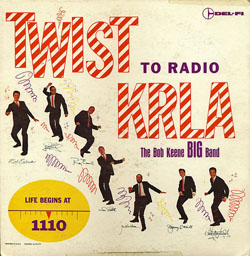
Imagine that this "Twist to Radio KRLA" LP, released in 1961, was KRLA's most notable legacy.
Imagine no Beatles at the Hollywood Bowl, no KRLA Beat, no Radio Free Oz (on AM radio, anyway), no Credibility Gap, no "Pop Chronicles." Had the FCC persevered with its initial plans, come May 1, 1964 the Land of 1110 would have been shrouded by dead air, all future opportunities unrealized.
It could have happened. According to a March 15, 1964 article in the Pasadena Star News the situation was hopeless. KRLA was doomed, haunted by "mourners" and "ghoulish interests" ready to snap up its FCC license the moment it ceased to be. How puzzling, mused the Pasadena newspaper: "Never has a radio station seemed healthier while perishing." And not a word was mentioned on the air to the station's loyal listeners.
Riding high on Beatlemania's first wave, KRLA decided to ignore its predicted fate. In March 1964 the Beatles dominated not only the singles charts but also held the top two positions in the LP charts. Taking its cue from this musical goldmine, KRLA poured all its energy into giving Beatles fans what they wanted -- Beatle double plays, triple plays, album tracks, and rare unreleased songs from their early days in Germany. As a result, KRLA's listenership as well as its market value burgeoned. The station was worth four to seven million dollars (that was a lot in those days), had 43 employees on its payroll, and was challenging KFWB for the number-one position on the airwaves. What, me worry? Read the juicy details of KRLA's demise by clicking on the image below.
A restless, hungry feeling
06.30.10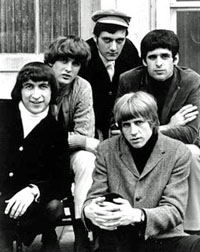
By 1966 San Francisco's Beau Brummels were a band with a new mission. Having chosen their name for its British flavor (and the fact that it would place their LPs just behind those of the Beatles in record racks), the Brummels already had two top-twenty hits, "Laugh, Laugh" and "Just A Little." The KRLA Beat had been loyally reporting their progress from its very first newsprint issue and had awarded them the Best New Group award at their Beat Pop Awards Show in 1965 -- then the only pop/rock awards show in existence (it took years before the Grammy Awards caught up with this category).
But the Brummels' later singles failed to crack even the top thirty. Something akin to a relaunch was in order. Louise Criscione was the Beat's top talent interviewer and she does the honors in the April 23, 1966 issue, interviewing the group on pages six and seven of the Beat and introducing a new member in their line-up.
New was Don Irving, who substituted for songwriter and lead guitarist Ron Elliott when Elliott's health didn't permit extended tours. Unmentioned in this article was the departure of rhythm guitarist Declan Mulligan, their only non-American member. Mulligan's attention-grabbing harmonica riff had opened "Laugh, Laugh" but he left the group in 1965 and, in an inventive reinterpretation of the verb "to quit," had just sued the Brummels for wrongful termination. Criscione and her interviewees carefully step around the elephant in the room and move on to the group's possible newest single.
Just dropped by Autumn Records, the Brummels had been picked up by Warner Bros., but Warners had neglected to obtain the rights to their own compositions. As a result the Brummels' upcoming 1966 album consisted of cover songs only. They play for Criscione their version of Bob Dylan's "One Too Many Mornings," and the reporter duly notes that it's great but also that they changed the lyrics. Why? "That's the way we wanted it, the way we arranged it," says Sal Valentino. Maybe the original lyrics were a tad too "adult" for teen audiences? Never mind! In the context of multiple Dylan songs reconfigured with a folk-rock jangle for top-forty radio, the Brummels' new single could have been a contender. You can hear it here until someone takes it down. It reached number 95 on Billboard's charts but went no further. KRLA and other stations gave it airplay but the end of the Brummels' first golden era wasn't far off.
Jim Steck, man of mystery
06.22.10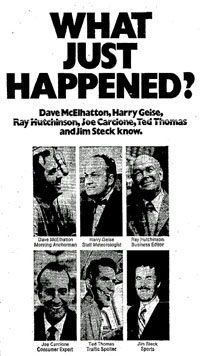
If you find any mention of newsman Jim Steck's name these days, it's usually paired with that of KRLA deejay Dave Hull. In one of the most brazen feats of newsgathering during 1964, Hull and Steck waltzed onto a plane carrying the Beatles from Los Angeles to San Francisco and pretended to be passengers.
The boys from Liverpool consented to a taped interview in the few minutes before their plane departed (not surprisingly, since the Fabs were already acquainted with the two radio men). The resulting sound bytes were aired exclusively on KRLA and later provided material for Vee-Jay Records' 1964 release "Hear The Beatles Tell All."
An Australian reader who met Jim Steck in the 1960s emailed me recently to ask what had become of him. There are gaps in Steck's professional biography but here's a start.
Born in Pittsburgh, Pennsylvania in 1935 to telephone electrician James R. Steck Sr. and Dorothy A. John, Jim Steck spent three years at Oxnard's KACY-AM (the same station where Bob Eubanks had gotten his start). Steck was then recruited to become part of KRLA's news department lineup from 1964 through 1967. He's listed (as James R. Steck Jr.) in the Radio and Television News Directory Association bulletin, Volume 23, with news director Cecil Tuck and compatriots Jere Laird, Bill MacMillan, and Richard Beebe. In 1966 and 1967 Jim Steck branched out and combined his radio work with a stint on "Teen Scope", a public affairs show aimed at the Los Angeles teen audience and aired on KCOP-TV. After 1967, Steck disappeared from the L.A. market. Where did he go?
The advertisement above (click to enlarge) represents San Francisco's premier AM radio news outles, KCBS. Steck was the station's sports reporter from 1967 through 1974. He had a simultaneous gig at CBS' KPIX-TV, where he also handled sports. He was part of the station line-up at least until October 1974. After that date there are no further sightings in the local press.
Steck, a Korean War veteran, died on September 27, 1990 and was buried at the San Francisco National Cemetery. If anyone knows anything about Steck's career from 1974 to 1990, or prior to KACY, I'd be happy to fill in the blanks. He deserves a proper history.
KRLA off the air? Not so fast....
05.24.10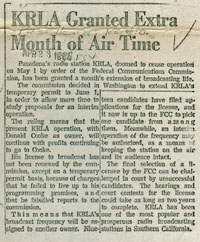
Imagine the unthinkable: the biggest radio station in the Los Angeles area, generating $150,000 to $200,000 revenue per year, faced with the sound of silence. That's exactly what the FCC had threatened in early 1964, just as the early height of Beatlemania was unfurling in full glory over the airwaves.
KRLA's youthful indescretions with its log book (agricultural shows were logged that actually hadn't aired) and a game show that was techically unwinnable contributed to the FCC's wrath. Once the charges were investigated and evaluated a series of temporary license renewals were granted, each for a year while more weighty sanctions were considered. A most serious solution was reported in the Pasadena Star News on April 23, 1964 (click the article above left to enlarge). Just a week later KRLA was scheduled to go off the air.
But for reasons not made public, a one month reprieve was granted, extending the pull-the-plug date to June 1, 1964. It was the first in a series of extensions to indicate that someone, somewhere had a broader view of KRLA's economic (or cultural?) potential. The news was all over the local press, including the Los Angeles Times, though nary a word was mentioned on KRLA itself. Deejays continued to spin records (mostly by the Beatles, whose popularity inspired double and triple plays of the same hit record), commercials continued to air, and KRLA's management continued to hope that a long-term solution would be found. The situation was not fully resolved for another three years.
Not such a bad-looking chap, really
05.07.10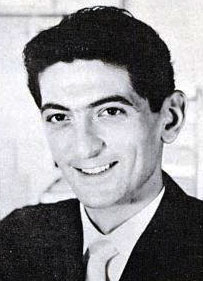
He billed himself as the "Wild Eyetralian" and "the world's ugliest disc jockey." He was the biggest personality on the airwaves in Chicago during the early sixties. At WLS, so it was said, Dick Biondi "owned" everyone under the age of thirty, and had the legendary distinction of playing the first Beatles record on U.S. airwaves, "Please Please Me," which charted on the WLS Silver Dollar Survey at number 35 in March 1963, then dropped away into oblivion. America wasn't quite ready for the Beatles.
Three months later Biondi and WLS were on the outs, allegedly over a dispute about how many public service commercials were required during his airtime. Biondi spent a few months with KRLA in the summer of 1963, then went on to the Mutual Network as a coast-to-coast deejay via their subscription service. He was signed by KRLA in February 1965 to take over the late evening time slot, which had been vacated by Dave Hull. Dave went to the afternoon drive-time shift, dislodging Reb Foster (who shortly was on his way to KFWB). Some kind soul has uploaded a ten-minute clip of Biondi on WLS in 1962 to YouTube. Contrast with Biondi's KRLA style.
Biondi arrived at KRLA at a fortuitous time. The station was then the top-rated contemporary music station in Los Angeles and was just about to launch its newspaper-format version of the KRLA Beat, further enhancing its presence in the market. KRLA general manager John Barrett reformatted the station's news programming, moving five-minute bulletins to 15 minutes and 45 minutes after the hour rather than at the top of the hour in an apparent bid to cater to news-hungry listeners. According to a Billboard Magazine article from February 20, 1965, Barrett was also careful to warn his staff "to stay clear of teen-age or hippy expressions," citing a growing adult listenership. Wishful thinking? At least he didn't stop deejays like Biondi from being silly on the air...that's what the listeners wanted at this stage of the game.
These days Biondi is back in Chicago at WLS-FM where he hosts an oldies show. Just a week ago Illinois celebrated Dick Biondi Day. It couldn't have happened to a more deserving fellow!
Olden days on the radio dial
04.30.10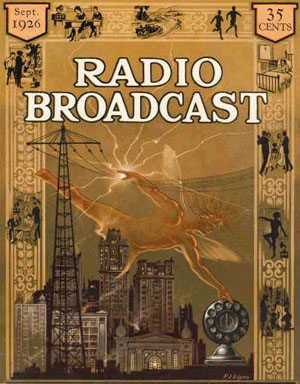
Those of us who grew up with top forty formats in the 1960s were used to the Los Angeles market roiling from competition between the Big Two (initially KFWB and KRLA) and starting in 1965 the Big Three, with a third contender, KHJ, added into the mix. But decades earlier the airwaves were filled with a different sort of sublime noise.
In 1922 when the flying god of the airwaves first cavorted through L.A.'s skies, all stations shared approximately the same place on the radio dial, 485 meters (about 620 kilocycles in in later terminology). This led to problems, not surprisingly.
Stations were supposed to play nice with each other and broadcast their programs for only a portion of the day, then graciously sign off and let the next station step up to the plate. Angry letters to the editor of the Los Angeles Times suggest that the listening public was not well served by this strategy. One listener complained that when he settled down to tune in Frances St. George on her ukelele at her assigned time, her recital was overrun not five minutes later by another station tuning up early with The Tooth Paste Troubadors and their dance-music program. Separate frequencies were inevitable.
Both KHJ and KFWB, KRLA's future rivals, were part of the early radio scene in Los Angeles. KHJ, originally around 740 on the dial, went on the air in 1922 and was at first owned by the Los Angeles Times. Warner Brothers' station KFWB debuted in 1925 at about 1200 kilocycles, broadcasting from towers situated at Warner Brothers' Studios. Gradual frequency adjustments placed KFWB at 980 and KHJ at 930, where the stations aired variety shows and news programs through the decades.
So who was at 1110 while the local airwaves were percolating with sound? No one, at least not in the Los Angeles market. The radio
dial looked like this in 1940. KFWB and KHJ were not quite situated at their eventual frequencies. Look carefully: KMPC is not in two places at once.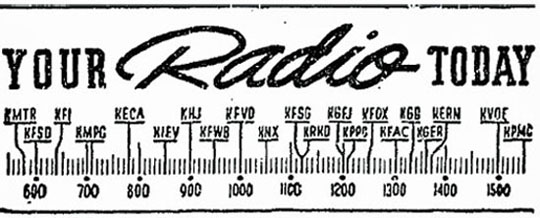
In 1942 KPAS appeared at 1110 on the dial with its on-air compatriots. KFWB and KHJ are now at 980 and 930. The
latest reference I can find to KPAS is November 3, 1945 from
a Los Angeles Times advertisement for a church service it aired every Sunday. Change was in the air.
KXLA popped up at 1110 in the January 5, 1946 radio guide and remained so until September 1959, when as KRLA it began delivering
the same top forty tunes as KFWB, a format described by the Pasadena Independent newspaper as "inane popular songs, frantic news
bulletins, twist dance tunes and light-headed disc-jockey chatter." Good enough for rock-and-roll! 
Happy birthday Casey Kasem
04.27.10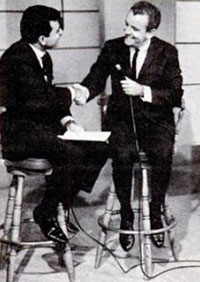
Casey Kasem (whose 78th birthday is today) is known for the phenomenal success of his syndicated show "American Top 40," which was launched in 1970 after his KRLA days. But he honed that format at several West Coast radio stations: KYA in San Francisco, KEWB in Oakland, and finally at KRLA 1110.
Kasem's standard countdown through the week's top ten records included what he used to call "teaser/bio" material, snippets of information about each singer or group. At KRLA the format was big with the early afternoon crowd and resulted in Kasem being named best disc jockey for that time slot by Billboard Magazine.
In the photo at left, Kasem was interviewed by reigning local pop-music TV host Lloyd Thaxton. The subject was Kasem's own record, "Letter From Elaina," released on Warner Bros. Records and published by Unart/Maclen in September 1964 (hmmm...Maclen...where have I run across that label before?).
Billboard had a brief review of the disc in their September 19, 1964 issue: "KRLA disk jockey Kasem effectively relates the story of a gal who experiences one of the more important moments of her life when she gets to hug a Beatle. Schmaltzy enough to register real strong with Beatle set." Now wait a minute, it was better than that! At least it was sincere.
The single originated from an on-air reading Kasem did earlier that month of a real letter from twelve year old Elaina Kaye Tribble, who had indeed manage to hug George Harrison after The Beatles' 1964 Cow Palace performance and wrote to tell Casey about it. KRLA audiences loved hearing Kasem's recitation and a recording followed in short order.
There's a riot goin' on....
04.22.10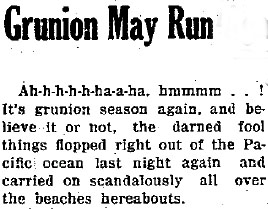
In more halcyon days one could wax rhapsodic about the innocent pastime of grunion hunting, a favorite sport in Southern California where grunion -- little silver fish about the size of smelt -- would launch themselves onto local beaches to lay their eggs, then return to the surf...if they could! Grunion were so preoccupied with their procreative task that they didn't consider people patrolling the beach with baskets, buckets, and all manner of carriers to harvest little fishes for the dinner table.
Grunion had an unfortunate connection with KRLA in 1961, a time when the station was still under investigation by the FCC for license irregularities. This time KRLA was entirely innocent and was merely a victim of bad planning. But it wasn't the sort of publicity a station necessarily enjoyed.
KRLA deejays hyped a "beachcomber's ball and grunion hunt" at Zuma Beach, set for June 3, 1961, with pop stars like Fabian set to sing and other local pop acts providing dance music for the teens who were expected to attend. KRLA had estimated a crowd of 2,000 people, at most 10,000. Instead, 25,000 people showed up at Zuma Beach, not all teens, not all well-behaved. Newspapers referred to it as a fully-fledged riot. Local constabulary and lifeguards were attacked with sand-packed beer cans. Restrooms were trashed, lifeguard stands dismantled, and illegal fireworks tossed into the crowd with mad abandon.
The June 6, 1961 issue of the Valley News summed up the basic story, while the Los Angeles Times insisted that things had been calm as long as deejays entertained the crowd. But as the situation grew out of hand the deejays and entertainers fled the scene, leaving thousands on the beach to revel through the evening. Eventually there were eleven arrests. One injured girl filed a lawsuit against KRLA, as well as Los Angeles County for issuing the permits in the first place (the lawsuit was tossed out of court two years later).
None of the news stories mentioned how the grunion fared that evening. They probably made out better than KRLA did.
Dave Hull the Hullabalooer fired...again?
04.16.10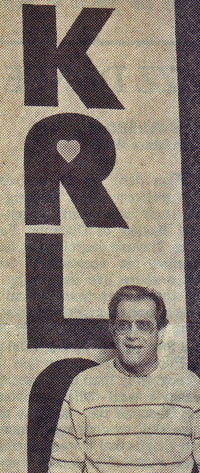
It was nothing personal, just business as usual, as you can see from this memo, altering the entire staff that they'd no longer be needed. For the full story click the picture of Dave Hull at left to read the March 2, 1985 L.A. Times interview.
KRLA was ready to reinvent itself yet again, this time in new studios in Los Angeles where Art Laboe would hold court over a reconfigured oldies format. Bert West's "Heart and Soul of Rock and Roll" was sold to Greater Media in February 1985 and with that change Dave Hull the Hullabaloer was out the door once more. He'd first been fired by KRLA in 1967, then brought back within hours after great fan uproar, remaining with KRLA for another couple of years.
After bouncing around various L.A. stations from 1969 to 1980 (KFI, KGBS, KMPC), Hull had been brought back to KRLA in 1981 for a reunion of the mid-sixties deejay lineup, which proved to be so popular that the station made room for Hull on a regular shift. But the format was running out of steam just four years later. Technically Hull could have stayed at KRLA but at a 35% pay cut, not exactly an attractive option. Perhaps, too, playing fourth fiddle to The Real Don Steele and "Emperor" Bob Hudson, tapped by Greater Media to join Laboe, held little allure.
Interesting to note in this article that Dave described himself as a member of KRLA's "porch people," the folks who hung out at the Huntington Sheraton's Carriage House studio hoping to get a glimpse of on-air personalities. Of course it wasn't KRLA in the 1940s, it was KXLA, but the idea that Hull's career was inspired by Jim Hawthorne's antics provides a nice bridge to KRLA's past.
Hull joined KWXY in Palm Springs in 1997 and until February 2010 was still on the air...until a format change left him once again without a radio home. Perhaps he'll find something else soon!
Hawthorne on 1110...before KRLA
04.13.10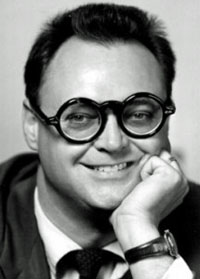
In 1959 KRLA's new Eleven-Ten men had to contend with a well established disc-jockey presence at rival station KFWB. Among KFWB's stars was Jim Hawthorne, whose reputation had been made during his previous fourteen years on Los Angeles radio and television.
Hawthorne actually established his "crazy show" (as he called it) format at 1110 on the dial when the KRLA was called KXLA, its call sign from 1945 to 1959. Hawthorne broadcast his free-form comedy in the midst of what was otherwise a Western Swing format, sandwiched between shows like Cliffie Stone's "Barn Dance", "Harmony Homestead", and "Hometown Jamboree."
To put it mildly, Jim Hawthorne was ahead of his time. Always unpredictable, he might play a song backwards, at the wrong speed, or overdubbed with his own lyrical accompaniment. Sometimes he read the station logs aloud. He lampooned advertisers. He had a cast of imaginary characters, most of which he voiced himself, and mixed bad puns with surreal sketches, including a plan to build an underground three-lane tunnel from Pomona to Pismo Beach...and maybe back the other way, if there was enough interest in it.
Airchecks of Hawthorne on 1110 actually exist. Airchexx.com has a twelve-minute sample of Jim Hawthorne's hilarious nonsense from June 9, 1947. If you're hooked after hearing it, WFMU-FM offers an hour-long compilation of Hawthorne's KXLA show in RealPlayer format. Nothing this wacky would be heard again on 1110 until the debut of The Firesign Theater and The Credibility Gap on KRLA in the mid-1960s, though their brand of comedy had a sharper edge.
Middle of the road?
04.10.10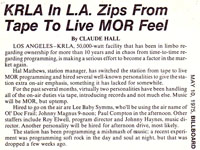
Even up to its last days as an oldies station in Los Angeles, KRLA liked to refer to itself as a continuous presence in rock-and-roll music. When it debuted as a top-forty station in September 1959 the industry term for the station's format was "teen beat". By 1967 KRLA's format -- still top-forty -- was "contemporary."
But it had a brief couple of years as an MOR (middle-of-the-road) station starting in 1975. Claude Hall of Billboard reported that the station, which had languished for a couple of years with just two on-air deejays and lots of taped rock, acquired a new format and new talent. Click the article to enlarge.
Johnny Magnus and Paul Compton were serious MOR powerhouses for previous Southland incarnations. Lee "Baby" Simms had worked at KRLA briefly in 1971. Johnny Hayes managed to hang on to his KRLA hat no matter what upheavals rumbled through the station landscape. Program director Roy Elwell was a surprise, though, a voice from the past. He'd been one of the original Eleven-Ten Men in 1959.
It wasn't a long-lived change and KRLA was back to playing oldies a few years later.
Dick Moreland: not just another pretty face
04.07.10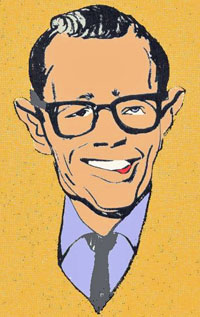
Dick Moreland had a voice less suited to the excitable shouting of top-forty radio than some of his fellow deejays at KRLA. I always felt he seemed more akin to Ted Quillan than, say, the Hollywood slick delivery of Jimmy O'Neill. But he played an important part in KRLA's maturing playlist once KRLA had slipped to the number-two-rated station in its market, an inevitable outcome of the format switch to all-request in late 1965.
By 1966 Moreland was program director at the station and Billboard Magazine rated him "most co-operative in exposing new records" in their March 25, 1967 issue. While the weekly tunedexes continued to be printed in the KRLA Beat, they didn't always reflect some of the rarities and album tracks being played on the station.
You might have to stay up late to hear the late evening deejay play the Rolling Stones' eleven-minute track "Going Home" from their "Aftermath" LP, or Chad & Jeremy's "Rest In Peace" from their Sgt.-Pepperesque "Of Cabbages and Kings", but it was worth a little lost sleep. After midnight you might well be rewarded with an album played in its entirety, something that local FM radio had yet to promote.
Billboard also noted that KRLA set a quota for ten new singles per week to be played on the air. Rival KHJ may have played more songs per hour but they were the same top-forty songs over and over. KRLA's listenership was evolving, and Moreland's picks for airtime might well come from anyone with a new record to push, not just the big labels.
After leaving KRLA, Moreland briefly became program director at the infamous, beloved KPPC-AM and FM shortly after the great purge of on-air talent in October 1971. Don Barrett's "L.A. Radio" website hosts an article by Jim Hilliker about KPPC's remarkable history, for those interested.
Thanks to KRLA historian Bill Earl for the illustration of Dick Moreland.
1959: New kid on the block
04.05.10
It's not the best quality, but it's perhaps the earliest assembly of photos for KRLA disc jockeys in December 1959, shortly after KXLA changed its Western Swing format and went to top-forty airplay on September 3, 1959.
Perry Allen had been recruited by station owner Jack Cooke from WKBW in Buffalo, New York, and was to figure inadvertantly but prominently in KRLA's licensing problems in the early 1960s. He was the innocent party in a "Find Perry Allen" promotion in the Southland, a KRLA contest that was (for various reasons) unwinnable by any local contestants. Perry Allen tells the story best himself.
At this point KRLA was referring to itself as "Radio One-One-Wonderful," a slogan that proved to be short-lived. L.A. Times radio reviewer Don Page was less than amused at the appearance of one more rock-and-roll station in the market, joining KFWB. He extended his holiday wishes with predictable cynicism: "'Twas the night before Xmas, and Santa's gondola -- was loaded for disc-jockeys with bags of payola."
The Payola Scandal, oddly enough, was not what almost conquered the Land of Eleven-Ten.Tunedex tales
04.03.10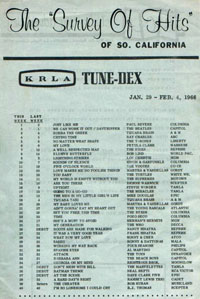
WLS in Chicago called it the Silver Dollar Survey. CHUM in Toronto called it the Hit Parade. KRLA was not the only radio station to use the term Tunedex for its index of hits, but it was the most prominent.
Even though a nicer typeset version of the Tunedex was available every week in the KRLA Beat, some uncelebrated secretary at KRLA still had to type out the Tunedex every week, which was then duplicated and distributed for free at the station as well as at local record stores.
Timothy Warden runs ARSA ("The Airheads Radio Survey Archive") and collects radio surveys, airchecks, and provides a number of documents and databases of interest to radio historians. KRLA is one of the stations represented. Click on any file to see a transcription of the tunedex for that particular week, with a scan of the actual tunedex where available. Someone clearly doesn't yet know how to spell "Simon & Garfunkel".
March 2, 1942: Mark you calendar!
04.01.10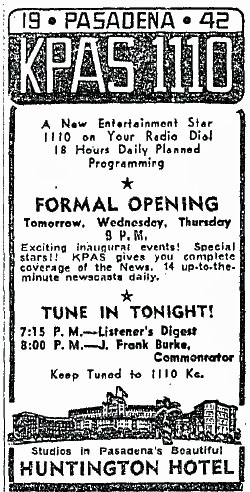
Sharp-eyed readers of this particular issue of the Los Angeles times might have noted history being made. Nestled next to a reminder to obey your air-raid warden ("So if the guy next door is a warden, you'd better be nice to him") was a small advertisement for a new radio station.
Even in those days the station that would become KRLA had a devotion to news, and station owner J. Frank Burke had his own commentary each evening at 8:00pm. But KPAS had competition from its compatriots on the dial. 1960s nemesis KHJ "at 930 on your dial" had the Raymond Gram Swing Show scheduled from 7:00 to 7:15pm, KECA (later KABC) offered Erskine Johnson's "Hollywood Spotlight", and on KMPC the Native Sons sponsored Frank Watanabe's talk on "The Japanese Menace."
But KPAS had a roster of inviting shows of its own, including "Meet Priscilla Alden" at 10:30am (sounds like a soap opera), "Let's Play Bridge" with Ray Noll at 2:45pm, J. Newton Yates at the organ at 10:30pm (poor fellow was probably in studio every week night for this, audiotape not yet being widely available), and "Problem Clinic" with Don Wilkie on Sunday nights at 8:45pm.
Kilocycles was the term used before kilohertz (kHz) to measure the exact point on the radio dial where your favorite station could be found. Before kilcycles came into use in the 1920s the preferred term was wavelength (KPAS was at 270.1 meters on older radio dials). Was there a station in Los Angeles at 1110 kilocycles before KPAS? The closest one I've been able to find was KPLA, operating at 1100 kilocycles, changed to 1040 in 1928. On 1110 kilocycles exactly was the thousand-watt KOAC in Corvallis, Oregon, which you could probably pick up with a decent loop antenna in those days. By January 1946, with no apparent fanfare, KPAS changed to KXLA but was still located (as KRLA was to be) in the Pasadena Huntington Sheraton hotel on Oak Knoll Boulevard. Here's what the Los Angeles radio dial looked like (sort of) in early 1946.

Thanks very much to Dana Shima for newspaper clippings on KPAS.
Looking for specific issues of the KRLA Beat?
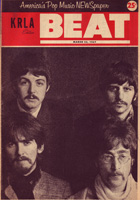
Individual issues are listed in the Archive section in chronological order, starting with the first known issue of the KRLA Beat on October 7, 1964 through May 4, 1968, the last date of publication.
The Archive also includes an indexed list of the entire collection for your reading enjoyment.
To start, click on the Archive tab above, scroll down the page, and click on any image to open that particular issue in your PDF reader of choice. If you run into any problems, please contact the webmaster for assistance.

